
- Types Of RVs
- Tow Vehicles
- Maintenance & Repairs
- RV Power & Electrical Supplies
- RV Appliances
- Living In An RV
- Travel & Destinations
- RV Gear Buyer’s Guides
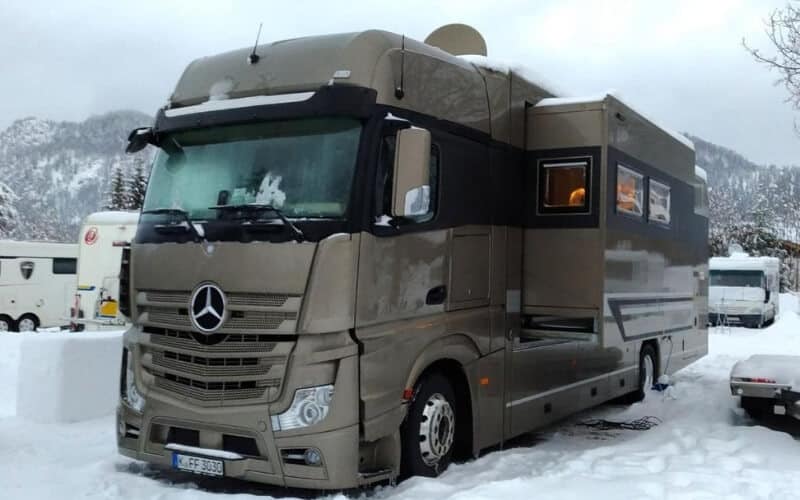

Full-Time RV Living In The Winter: How To Survive & Tricks To Stay Warm
- Last Updated: March 4, 2024
- 10 minutes read
One of the best things about being a full-time RVer is the ability to be spontaneous.
But when it comes to living full-time in an RV for the winter, you’ll want to do some planning and preparation to keep from freezing your tail off.
I know this because I’ve been there…
My wife and I had been RVing for 3+ years and we’d started with the dream of chasing 70 degrees everywhere we went in our RV.
And yet, here we were in the middle of January, sitting in sunny Arizona and hitching up for a long drive to freezing Northern Kentucky.
Our RV trip from warm to cold made us ask ourselves: How do you live and camp full-time in an RV in the winter?
Despite our uncertainty, we discovered that living full-time in an RV during the winter was not only doable, it could even be enjoyable with the right tactics.
To live full-time in an RV in the winter, you need the following:
- A heated water hose (or you can rely on the internal water pump in your RV).
- An internal propane heater in your RV.
- 1-2 electric space heaters .
- Warm clothes and blankets (you can keep the RV warm in the winter, but these help).
- A way to keep tanks and pipes warm (some RVs are 4 season and already have heaters for these areas).
By equipping yourself with the above tools to live full-time in an RV in the winter, you can open the door to new and exciting adventures while winter camping.
Below, I’ll share my story about how we lived in our RV full-time during the winter, the tools we used to keep ourselves warm, and the tactics we employed to make sure we didn’t damage our RVs pipes or tanks due to freezing temperatures.
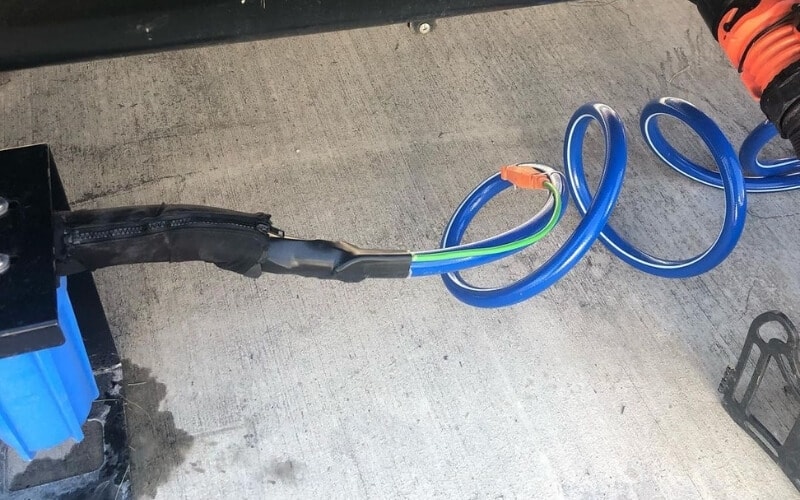
Tips For Living In Your RV During The Winter
Here’s our best winter RV living tips to prepare your rig to stay warm when it’s freezing outside.
1: Use A Heated Water Hose Or Your RV’s Water Pump
A heated water hose like this one is a must if you plan to hook to city water in your RV during the winter.
My wife and I learned this the hard way when we were still in Williams, AZ. Even though it was warm and sunny during the day, the temperature dropped below freezing at night — meaning our hose wasn’t letting water flow in the morning.
If you live full time in your RV during the winter, you’ll always have to deal with frozen hoses unless you have a heated hose. NOTE: Just because you have a heated hose does not mean that the campground pipes won’t freeze during the winter.
If the campground you’re at hasn’t taken precautions to keep pipes from freezing or if you don’t want to buy a heated hose, you could do the following:
Use your RV’s water pump instead of a hose
Because your RV fresh water tank is internal, it will be less susceptible to freezing than an exposed water hose. RV makers usually also run heat ducts near the tank to help keep it warm.
By simply using your internal pump, you can eliminate the problem of a frozen hose.
But beware though, when my wife and I did this it seemed like we always ran our tank dry in the middle of the night when it was freezing outside…
So, don’t be us and proactively fill up your freshwater tank to avoid this late night catastrophe.
Let water dribble from a faucet
If you leave a water faucet open just enough for water to drip, this will cause water to flow through the hose and into your RVs pipes.
Flowing water is very hard to freeze, so this will usually keep you covered in a pinch.
Caution: Use this option only as a last resort because it is very wasteful and doesn’t guarantee that sensitive pipes like your toilet pipes won’t freeze over.
Also, if you don’t have your grey tank open to drain, you’ll fill it up overnight with the above plan.
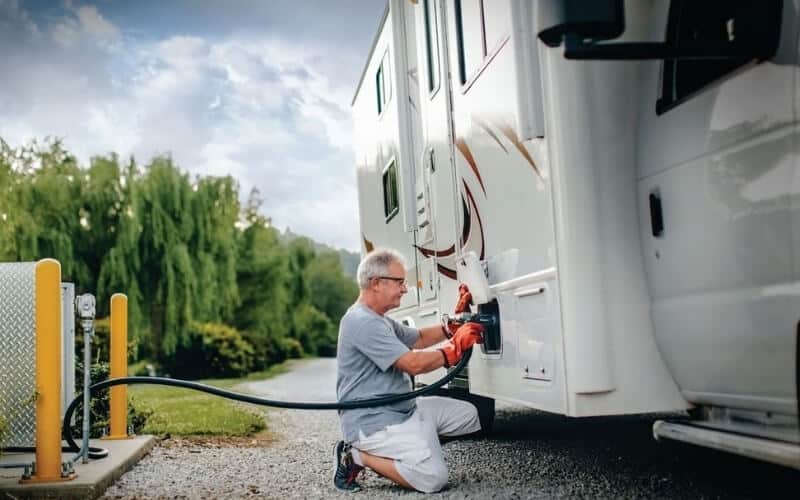
2: Keep That Propane Topped Up!
When you live full-time in an RV during the winter, you’ll burn through propane much more quickly than you’re used to. I remember when my wife and I first discovered this… It was about 3am on a cold Kentucky night. I’d just filled my propane tanks about 4 days before and I was used to them lasting me nearly a month!
So, you can imagine my shock and dismay when I awoke to an ice-cold RV. This happened because I didn’t realize just how much more propane I was using to keep my RV heater running during the winter. I’d run out of propane in the middle of the night and my heater was just blowing cold air.
Don’t be like me — instead, keep an eye on those propane levels and fill them up frequently. If you push this, I guarantee you your propane won’t run out in the middle of the day when fill stations are open. Instead, it’ll run out in the middle of the night when you’re freezing your tail off and there’s nothing you can do about it.
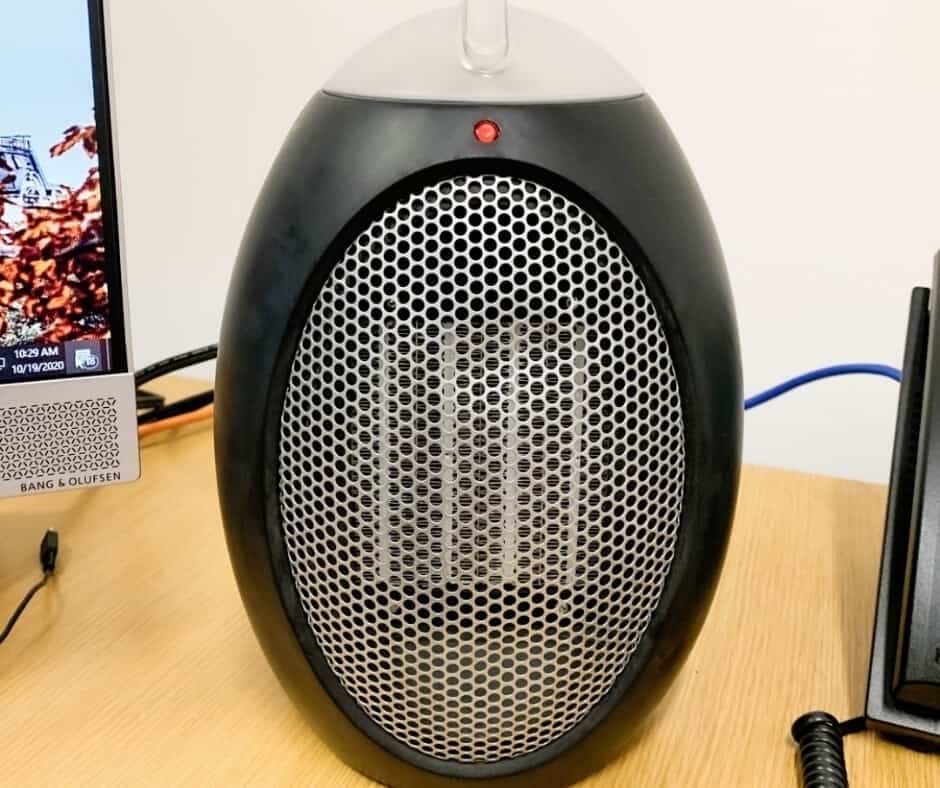
3: Electric Space Heater(s) Are A MUST
When you live in your RV full-time in the winter, your RV’s propane heater will do a great job of efficiently and evenly heating your RV.
But my wife and I found that some areas of the RV (like our bedroom) needed an extra boost of heat to help out.
That’s why you should plan to have an electric space heater for winter camping .
Generally speaking, you should not try to run more than 1 electric heater in a 30amp RV because space heaters pull a lot of juice and can trip your breaker.
50amp RVs are capable of running more than one space heater as long as you don’t have other energy hungry appliances running.
4: Protect Your Pipes and Tanks
If you have a true 4 season RV, you’ll be able to live in it full-time in the winter without too much trouble.
That’s because your water and dump tanks will be heated and your heat ducts will go all around your water pipes.
But my wife and I (like many RVers around the world) don’t have a 4 season camper .
We have a vintage Airstream which — beautiful as they may be — are not known for withstanding harsh winters. So, if you’re like me, you’ll have to take some additional precautions:
- Don’t leave your black and grey tanks open all the time – Instead, just drain them out periodically, unless you want frozen poo in your sewer hose.
- Run your heat a lot – Even if you’re not in the RV, your pipes and tanks will freeze if you don’t have that heater running. Most RV makers put heat ducts near your pipes to help prevent freezing — do your part by running that heat.
- Don’t overfill your tanks – When living in your RV during the winter, you should never allow your water tanks to get full. You shouldn’t let water in your tanks freeze in the first place, but in case it does, you don’t want a full tank freezing because the water will expand and have nowhere to go.
- Never trust your RV toilet in the winter – Every time I’ve gone into my RV after storing it for the cold months, I’ve been greeted with a toilet that sprays water from all kinds of places. I swear that the valves and fragile pipes on RV toilets are designed to crack the second they get a whiff of freezing temps…Don’t let this be you. Protect that commode. Put a space heater by your toilet, check it often, and if it gets really cold outside, shut off your toilet valve and just use a jug of water to rinse your toilet.
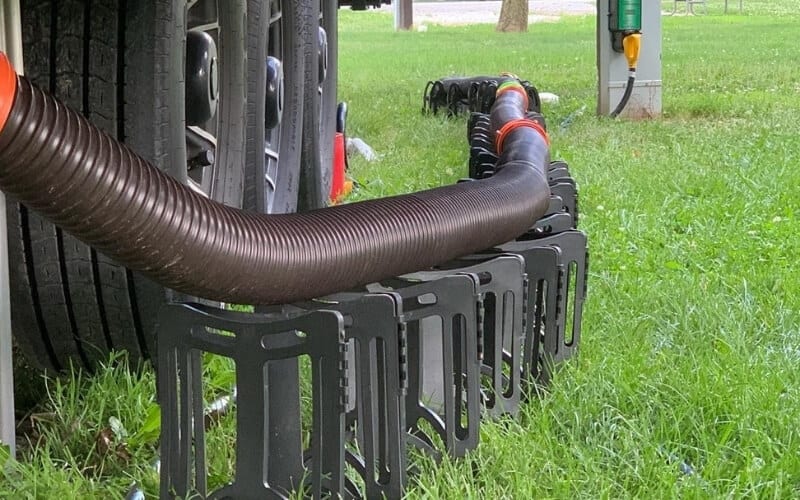
5: Use A Hose Ladder For Your RV Sewer Hose
Sewer hose ladders will keep your sewer hose from bunching up so drain water can flow quickly down the chute. If you don’t use a ladder, your sewer hose might bunch up or leave standing “water” inside it.
Standing water + winter temps = frozen water. And trust me — the last thing you want is frozen poo in your sewer hose when you’re trying to live full-time in your RV in the winter.
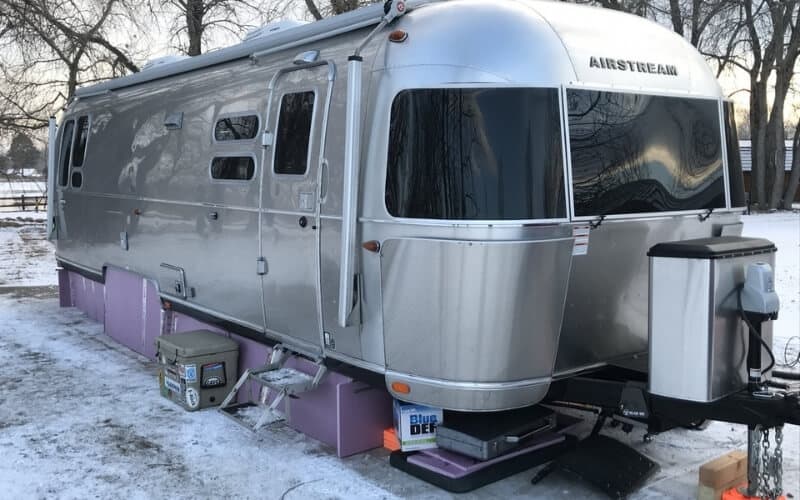
6: Put A Skirt On Your RV
When we left sunny Arizona for cold Kentucky, we arrived to a peculiar thing at our winter campground… People had skirts on their RVs! These skirts would wrap all around a camper to cover up the entire underbelly. While it looked a little weird, we quickly figured out that this is a great way to keep an RV warm in the winter.
While not a requirement for living full-time in your RV in the winter, if you can find a way to cover the underside, you’ll prevent cold air from getting under your RV. And that goes a long way to keeping you and yours warm while camping in the winter.
7: Insulate Your Camper Windows
When wifey and I took our first foray into winter camping, we quickly realized that cold winter winds will blow through RV windows like a hurricane. After we turned to popsicles one night, we vowed to fix this pesky situation.
It turns out the solution is fairly simple — all you need to do to insulate your windows when you live full-time in an RV for the winter is grab some foil bubble or foam insulation , cut it to fit your windows, and then wrap it in nice looking fabric.
This simple solution makes your windows look stylish and will go a long way to keeping you warm while winter camping.
8: Stock Up On Warm Clothes
While you don’t need to live like poor Bob Cratchit in A Christmas Carol , you will want a wardrobe that’ll allow you to brave some cooler temps.
When living in your RV full-time in the winter, you’ll be able to keep it warm, but not as warm as your house.
You won’t be able to scamp around in shorts and a T-Shirt when it’s freezing outside your RV (I always used to do that at my regular home because it was so much easier to heat my well-insulated house).
Instead, grab some thin thermal undergarments, thick socks, and comfy sweaters to keep comfy while winter camping.
8: Thermal Sleeping Bags And/Or Duvets Are Your Best Friend
Even though your RV will stay relatively warm on winter nights, it likely won’t be as warm as you’re used to.
That’s why it pays to have a thermal sleeping bag or thick duvet that you use to keep warm and toasty in bed.
9: Don’t Forget The Healing Powers Of Hot Cocoa
Hot cocoa is that wonderful elixir that you should never be without while living in your RV full-time in the winter.
Keep a supply at the ready to warm body and soul while you brave those winter months in your RV.
When my wife and I decided to live full-time in our RV for that northern Kentucky winter, we had no idea what we were in for.
We quickly took a crash course on all things winter camping. Along the way, we realized that it could be quite fun.
But we hope you don’t have to make the same mistakes we did and that you use our tips above to make sure winter camping goes well for you and the family.
About Author / Aaron Richardson
Aaron Richardson is an expert RVer and the co-founder of RVing Know How. Aaron, along with his wife Evelyn, has been living and traveling in their Keystone Fuzion RV since 2017. Their adventures span across the country and beyond, including memorable RVing experiences in Mexico. Aaron's passion for the outdoors and RVing shines through in his writings, where he shares a blend of travel stories, practical tips, and insights to enhance the RV lifestyle.
![6 Best DIY Teardrop Trailer Kits in [currentyear]: Top Rated Teardrop Camper Kits 2 The 6 Best Teardrop Trailer Kits](https://www.rvingknowhow.com/wp-content/uploads/2021/09/The-6-Best-Teardrop-Trailer-Kits-150x150.jpg)
6 Best DIY Teardrop Trailer Kits in 2024: Top Rated Teardrop Camper Kits
How to winterize your rv camper [a step-by-step guide].
![How To Winterize Your RV Camper [A Step-by-Step Guide] 3 How Do You Winterize an RV](https://www.rvingknowhow.com/wp-content/uploads/2021/01/How-Do-You-Winterize-an-RV-150x150.jpg)
Steve Prentice
Josh – a well-written post. Thank you. I am studying everything I can about winter RV-ing in preparation for the upcoming 2021-2022 winter here in Toronto, Canada. I have read many posts and watched many YouTube videos but one point I have never seen mentioned anywhere is what to do if you want to leave your RV for a short trip such as grocery shopping, or an overnight (or longer) visit to friends/relatives etc.? What do you do then? Are you comfortable with the idea of leaving space heaters on while you go out shopping? And if you choose to leave the RV for a weekend, should you do a quick winterizing treatment with anti-freeze in the pipes? I would love to get your thoughts on this. Happy Travels! Best, Steve
Matthew Groom
Hi Steve. I would wager that you can keep the RV warm enough without the space heaters (which are notorious for starting fires) running the whole time. Water will START to freeze at 32*F/0*C, but it how quickly it freezes will depend on who much time it has to freeze. Keeping it above 40*F inside the RV while not occupied should be quite safe (and will use less propane). Also, the main way that space heaters end up starting fires is usually because people leave piles of clothing or other inflammables near them (or on them), which if you position them cautiously, will probably be perfectly safe to leave unattended for a short while.
I’ve lived full time for 3 winters in the mountains north of Spokane, WA. where temps get below zero several times in cold snaps. One of the best solutions that is also cost effective is to use an oil filled radiator heater. Once they are at top heat out put they don’t use much electricity and will maintain an ambient inside temp while you’re away. Depending on the size of the rv more than one oil heater in different areas can work for larger rv’s. These heaters are sold in many stores or online and are reasonably priced. Hope this helps.
Just a tidbit to pass on. Most trailers with “winter” or “arctic” packages have no additional insulation–they are simply covered on the underside which protects piping, BUT, the warranties explicitly say that you use the furnace to make the guarantee any good. So, while we use radiant heaters, we also use our furnace which can be costly during a cold snap, but it prevents frozen piping and makes us cozy, so we do it. We keep two extra tanks at all times and leave faucets dripping at night. So far, so good (third year).
Leave a Comment Cancel reply
Your email address will not be published.
Save my name, email, and website in this browser for the next time I comment.
You Might Also Like
![How To Winterize Your RV Camper [A Step-by-Step Guide] 4 How Do You Winterize an RV](https://www.rvingknowhow.com/wp-content/uploads/2021/01/How-Do-You-Winterize-an-RV.jpg)
How To Store An RV Outside In The Winter
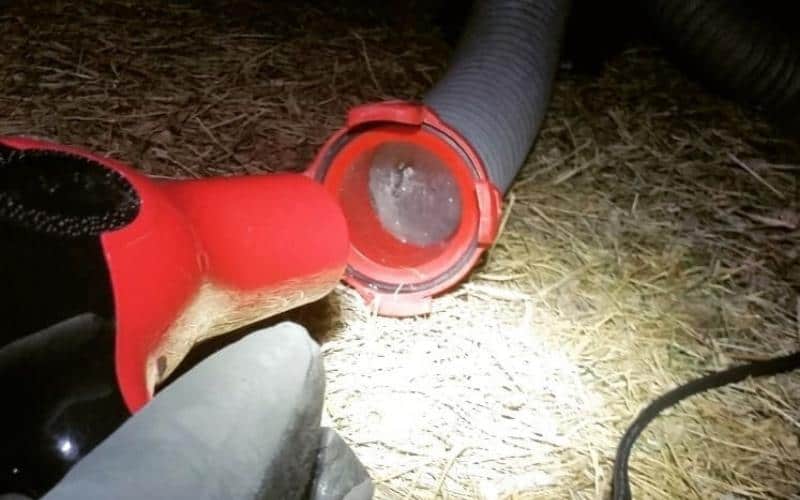
Do I Need A Heated RV Sewer Hose For Winter Camping
Start typing and press Enter to search

21 Best Tips for Living in an RV in the Winter Comfortably
Living in an RV is exciting, adventurous, and liberating. However, depending on where you are, winter can be harsh, especially if you’re not prepared for it.Winter, especially in extra cold climates, can require a whole regime of plans and preparation in order not only to thrive, but just to live comfortably in an RV in winter.
So here are the . . .
21 best tips for living in an RV in the winter
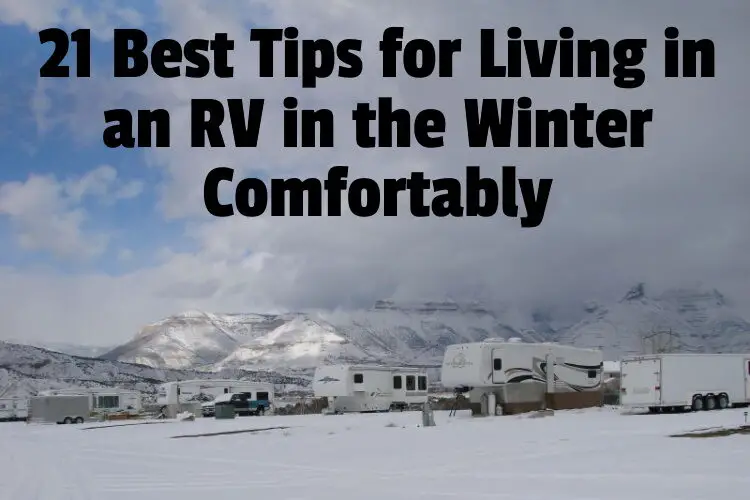
1. How Cold Is Too Cold for an RV?
Temperatures between -19 °F and -25 °F are dangerously cold for an RV. When you’re living in an RV, extremely low temperatures are hard to navigate. In fact, there is a chance of frostbite to occur in just a few minutes if there is no insulation. The RV pipes can also freeze, making it almost impossible to turn on the engine.
Thankfully, you can easily take measures against the cold wind of winter. Simply getting a portable or small space heater could make a huge difference.
2. Showering in an RV in the Winter
Showering can be tricky, especially during the cold months. You can’t shower outside at all, thanks to the cold air and possibly, snow. You will need heated water or a heated hose when you want to keep yourself clean.
Having a propane heater warm the water system can be a great way to negate freezing temperatures. Make sure you have extra propane tanks to properly heat up the water before usage. Some RVs also have electric heaters, but you can always bring your own mini space heater. They use very little amperage.
Also, make sure you have a tank warmer for your propane tanks.
3. Winterize While Still Living in It
Winterizing an RV while you’re still living in it is possible. Of course, it can be a bit tedious to move around stuff, even more so if you have kids living with you. However, with a bit of finesse and a healthy dose of duct tape, it is possible to make your RV winter-ready. Here are a few things you should do:
- Get proper heavy coats for the winter and other winter clothing.
- Heavy-duty winter shoes as well as boots
- Get terminal curtains installed on the RV vendors
- Get freeze proof and possibly heated water hose
- An ice scraper is a necessary tool
- Get RV antifreeze as well as engine antifreeze
- Interest in indoor space heaters, electric and propane kind
- Wrap your pipes in heat tape
- Have a couple of extra sleeping bags
- Also, carry a big foam board in case you need to pat something up in an emergency
- Don’t forget to bring your favorite blankets and hats
I also recommend opening the cabinets and closet doors when you are actively using the space heater. This will heat up the pipes running around the RV and make water flow easier.
@trails_rv RV winter living is all about one thing: preparation. You will experience some big problems if you don’t keep it warm. Your RV’s pipes can burst just like the ones at home, and the cold weather is killer on your RV batteries. pic.twitter.com/XBIt0j3pGW — BUCKEYE TRAILS MOBILE HOME & RV PARK (@trails_rv) October 29, 2021
4. Keeping the Pipes from Freezing
Water supply can be tricky during the winter. Many RVers simply drain their freshwater tanks and have bottled water for brushing teeth as well as doing the dishes. The main area that must be always above freezing temperatures is the bay. It’s where all your water tanks are. Invest in a space heater and place it near it.
Use RV antifreeze in all of your plumbing, as well as black and gray tanks. Simply flush antifreeze down the toilets and let it pour down the drains.
But remember: Do not put RV antifreeze in your freshwater tank or water heater.
Use a PVC pipe for your sewer hose , as it’ll have a lesser chance of freezing than a regular one. Try not to open the tank and only do so when it needs to be drained. Ensure there are no kinks in the hoses as there will be less chance of water freezing. If you’re going to use water hookups, make sure you use heat tape and insulate the pipes. Insulate the connections as well as any exposed piping.
If you are camping in an RV Park that has city sewer connections, make sure your outlet ports are closed. Don’t enter your holding tanks until they are full to avoid any disgusting and freezing incidents.
5. Added Heating Costs – Heat Pump vs. Furnace
A heat pump simply moves heat from the outside to the inside and vice versa. That’s all there is to it, it is not generating any heat itself, so it is a cost-effective alternative to heaters.
A furnace uses fuel, often natural gas or propane, to generate heat. So if you’re in extremely cold weather, a furnace is what you would need.
Sure, you can have both installed and use the heat pump when the temperature isn’t low enough and save money. But when it’s snowing outside, you’ll need to go with the more expensive option and get the furnace running.
6. How to Insulate Windows
There are several ways you can insulate your RV Windows, and most of them are easy to do yourself.
Replace Your Windows with Double Pane Ones – Some windows only come with a single pane glass. Single pane glass is easier and inexpensive to create and install. However, they’re not so great at insulating your RV. A double-pane window, on the other hand, has vacuum space between the panes. That vacuum is an excellent insulator, and therefore any heat inside the RV will stay inside.
Insulated Curtains – Curtains are necessary not only for privacy but also for better window insulation. Curtains trap cold air between the window and your living space.
Tinted Windows – Tinted windows are great for summer as they keep your RV cooler, but they can adversely affect the overall temperature during the winter. Make sure you don’t have tinted windows on your RV.
Get Plexiglass Covers – Plexiglass covers basically trap another layer of cold air between the cover and the glass.
Here are some quick tips to prepare your RV for winter: Clean Inside RV, Drain Liquids, Cover Tires, Cover RV…. Store at Avalon Storage! pic.twitter.com/mWWWZ1mXGl — Avalon Storage (@avalon_storage) November 3, 2017
7. Tire Covers
RV tire covers are great at preventing ultraviolet rays from damaging the tire and making it crack well before its time.
But they are also great at preventing snow and rain from interacting with the wheels.
This, in turn, lowers the chances of corrosion and rust on the rims and wheels. If you want to know more benefits of RV tire covers, here’s a recent article that goes a bit deeper.
8. RV Skirt
RVs are raised above the ground because of wheels.
This means cold air can flow underneath them and drop the overall temperature of the RV. RV skirts are there to prevent that. If you don’t plan on moving around during the winter, RV skirts are a great addition. They also protect you from rain and snow in addition to cold air.
9. Should You Drip Faucets?
Running water through the pipes helps in preventing freezing. However, if the water is in limited supply, even a slight drip can add up over the course of the whole day.
I recommend dripping faucets during freezing weather to avoid freezing the pipes. Some pipes may even burst when frozen, so it’s better to just let the water drip just a trickle to avoid that.
Survived the first night #RV camping. Space heater helping get temp back to human levels. Rain coming to #atx area. pic.twitter.com/cHvBgorElr — Young Fulltimers (@youngfulltimers) January 2, 2016
10. Are Space Heaters Safe?
I recommend using electric space heaters as they are a safer choice for indoor usage.
Gas heaters are also good, but they emit carbon monoxide or other pollutants. Carbon monoxide build-up inside a closed cabin is highly dangerous and, therefore, not worth the trouble.
Gas space heaters need proper ventilation, which kind of defeats the purpose of the heater during cold months. So yes, electric space heaters are safe in an RV.
You should also have a carbon monoxide detector inside the RV at all times, regardless of what kind of space heater you are using.
11. How Cold Will It Get inside the RV?
Without proper heating or insulation, an RV can get freezing cold depending on the climate outside.
Sure, the enclosed space can benefit from multiple people being inside. However, that isn’t enough to combat the extreme cold. It also depends on where you are camping and what time of year it is. If you’re camping in Alaska or perhaps up in the mountains, it’s going to get chilly.
12. Use a Dehumidifier to Minimize Condensation Issues
Here’s a myth: a dehumidifier can completely stop condensation. It actually can’t.
Sure, it can reduce it, but it also needs good indoor ventilation and air exchange with the outdoors to work efficiently. However, having one can minimize the condensation issues significantly inside the RV. Just don’t expect it to miraculously kill any condensation though.
Looking for tips on keeping warm in your motorhome when it is snowing! ❄️ Do you keep it old school or do you get some fancy gadgets? 😎 #MondayMotivaton #mondaythoughts #vanlife pic.twitter.com/p04EnPFP9q — Goboony (@Goboony) February 4, 2019
13. Keep the RV Warm All the Time
It is better to keep the RV warm all the time instead of reheating after intervals.
When you have to start from zero, you may need to push the heating system to its limit to achieve a warmer temperature. This, in turn, uses up more fuel/energy. Think of it as a bicycle ride, it’s easier to continue riding than having to stop and start again.
It is also cheaper to maintain the temperature when the heat is running full time.
14. Make Sure Coach Batteries Are Designed for Cold Weather
Regular RV batteries can stop working in the extreme cold.
That’s just chemistry. So make sure your coach batteries are specifically designed to be used in cold weather. Thankfully, cold weather compatible batteries are labeled accordingly, so all you need to do is take a peek.
15. Check Propane Tank Levels Every Few Days
Checking the propane tank is generally a good idea as they are essential for your winter season survival. They can be used for propane furnaces, propane heaters for the water system, and even for cooking.
I recommend carrying extra propane tanks during your winter RV camping and winter RV trips. Also, keep a mental note of where the hardware store is, so you can keep them topped off during the whole winter season.
Spending the winter in your RV where its cold? You need a heated water hose! pic.twitter.com/tIaTMp0Zd3 — Markin Sales (@MarkinSales2) December 2, 2016
16. Get a Heated RV Water Hose
Heated RV water hoses are insulated and also come with an electric element to heat up the hose during freezing temperatures.
Most of them are rated for drinking water and great to use inside RVs.
I’d say it is one of the most essential pieces of equipment you need to carry. There are several great heated RV water hoses available online. Make sure you get one that has an electrical element inside that actively heats up the water and prevents any freezing.
It might be a bit more expensive but is well worth it in the long run.
17. Keep the Black/Gray Water Drain Hose Free of Kinks
Gray water tank holds any water that’s from the drains.
Similarly, the black water tank is the septic tank. Any bends in the black or gray water drain hoses increase the chance of ice buildup. If applicable, use PVC pipes instead of drain hoses during the winter, but if it isn’t possible, keep an eye for any bends.
18. Wrap All Exposed Pipes and Hoses with Heat Tape
Heat tape is amazing when you need to insulate exposed pipes and hoses. It’s relatively inexpensive and can help protect pipes from bursting during freezing temperatures.
Generally, you should carry extra heat tape with you if you are living in the RV full-time. Also, make sure to wrap any joints and connections in the pipes and hoses with heat tape.
You can place throw rugs over non-carpeted floor areas in your Cruise America RV to help keep it a little warmer. pic.twitter.com/4wh3RJrHE6 — Cruise America RV (@CruiseAmerica) February 5, 2016
19. Use Throw Rugs
Throw rugs not only provide another layer of customization and personalization, but they are also great insulators.
They are easy to simply roll out on the floor, they can be moved around whenever necessary, and best of all, they are washable. So, even if they don’t get dirty, you just need to wash them once a season, and you’re good to go.
I recommend going with the thicker kind as they will provide better cushion and somewhat better insulation. Of course, that all depends on your personal preferences as well. A regular cut-out carpet can also do the job but would be a bit harder to clean.
20. Cover the Roof Vents with an Insulated Cover
Warmer air is lighter, so it rises to the ceiling. And if your roof vents are not insulated, the heat will simply escape out, and your RV will get colder.
An insulated cover ensures that you lose a very little amount of heat through the vents and roof. That’s it. It is as simple as it sounds, so you might as well install insulated covers during winter weather.
Specifically designed vent covers are also necessary.
You don’t want to completely block off the vents because that would increase condensation and also make it hard to breathe. There are great quality vent covers that are designed to be used in cold weather. They are not expensive and are super easy to take off.
21. Use Your Freshwater Tank Instead of the Campground Water Supply
Using the freshwater tank will keep water running throughout the plumbing inside the RV. This means it will have a lesser chance of freezing the whole tank. But make sure you refill the freshwater tank during the day as needed.
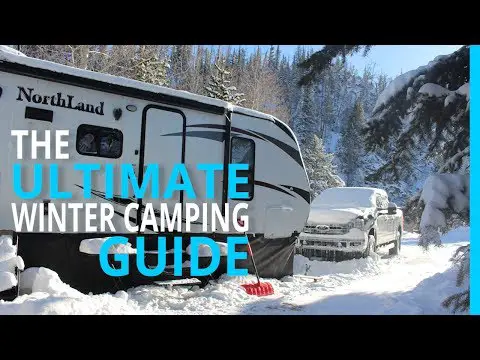
These are the 21 top tips for living in an RV during winter comfortably.
You need to properly insulate the windows, doors, and vents, have extra propane tanks or butane gas for cooking, some good quality thermal sleeping bags, and thermal curtains. Most importantly, try not to open the door too much, as it lets cold air inside.
Similarly, if you want to winterproof your 5th Wheel, here’s a recent article that makes it a lot easier.
Living in an RV during the winter comfortably shouldn’t be hard. Once you get the hang of how you can preserve heat inside the cabin, it becomes extremely easy to maintain the overall temperature throughout the season. Hopefully, these tips can serve as a guide towards a toastier and more relaxing winter .
Photo that requires attribution: Colorado Winter RV Park by vicki watkins is licensed under CC2.0 and was cropped, edited, and had a text overlay added.
Jeff Campbell
Jeff Campbell travels on and off with his 3 daughters in a Newmar Baystar Class A Motorhome. He writes extensively on both RVs, campgrounds, parenting on the road tips, remote learning & schooling, and much more! Click Here to learn more about me. Click Here to learn more about my site. Editorial Policies.
Leave a Reply Cancel reply
Your email address will not be published. Required fields are marked *
Save my name and email in this browser for the next time I comment.
Top Related Posts
How Cold Can it Get Before I Have to Winterize my Camper?
The harshness of winter depends on where you are based. Luckily, most people with an RV can move around. But if you’re staying put in a cold climate, you may have asked how cold can it get before I...
How to Winterize a 5th Wheel for Winter Living - Step by Step
Camping in a 5th wheel and having the freedom to move as you please is an amazing experience. But if you don't take a few simple steps in the wintertime, the dream can turn into a nightmare. So let's...
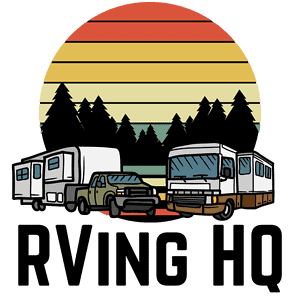
How to Live in an RV in the Winter: Your Ultimate Guide
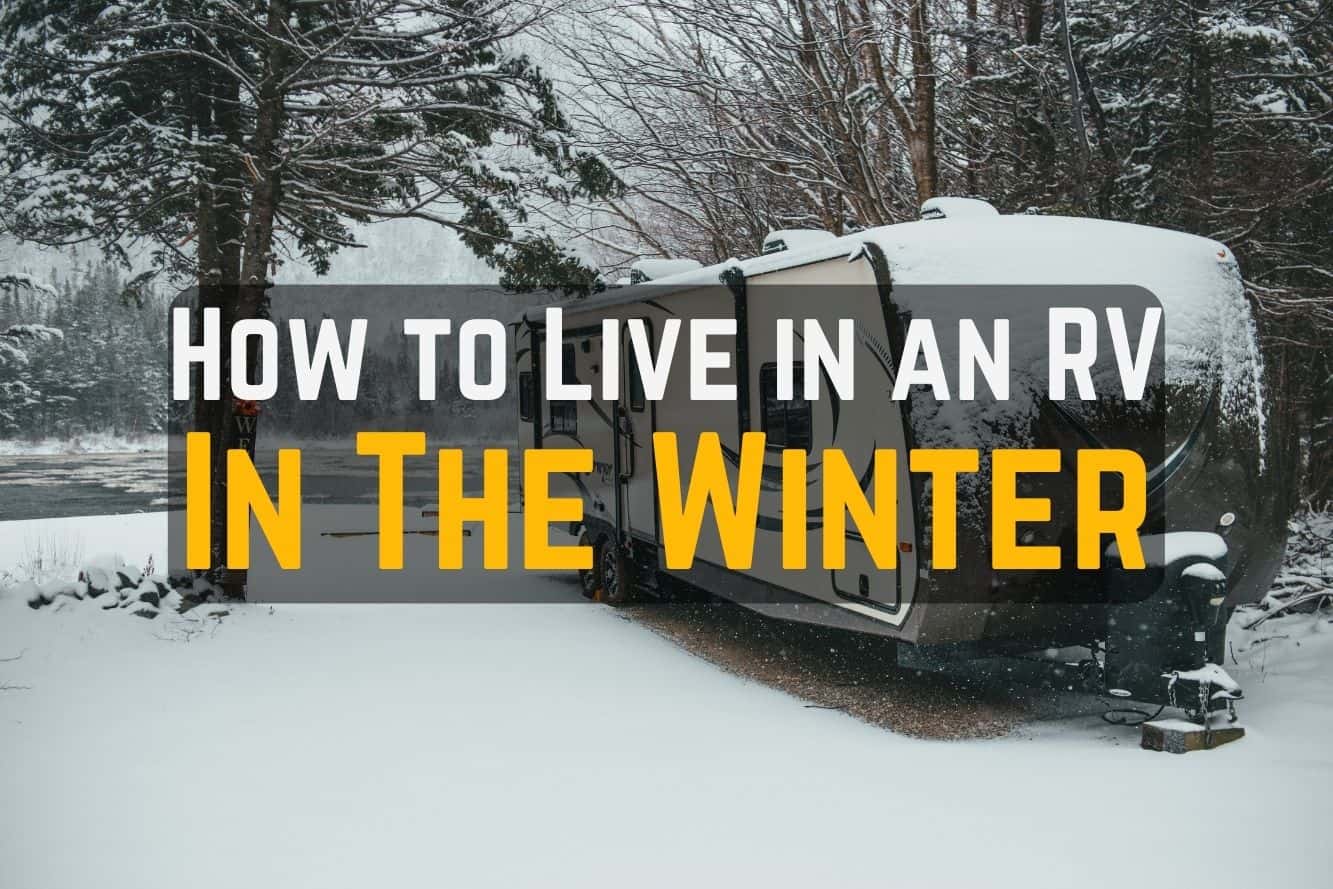
Learning how to live in an RV in the winter time requires just a handful of things: insulation, heating, fire and CO2 safety, and protecting your plumbing.
But these few things can get really in-depth, and there’s a variety of different ways to do them!
In this article, you’ll learn how to live in an RV in the winter time comfortably and safely. Let’s dive in.
This article contains affiliate links. This means if you make a purchase after clicking a link on our site, we may earn a small commission.
Table of Contents
Can You Live in an RV During Winter?
Yes, you can live in an RV during the winter, and many people do! Whether stationary or traveling, living in an RV is a great way to save money and see the country, and you can do it in any season.
The key to comfortably living in an RV during the winter time is to be prepared. This article is meant to be an in-depth winter RV living guide. We’ll touch on every aspect of winter RV living to help you better prepare for the cold winter months.
Note: this article pertains to winter RV living in colder climates.
Also, we use the term RV to apply to all types of campers: motorhomes, fifth wheels, and travel trailers.
Considerations for Full-Time RV Living in Winter Time
Before we get into it, let’s briefly highlight the main topics this guide covers.
- Stationary winter RV living vs full time winter travel.
- Insulating the interior and exterior of your RV.
- Heating your RV and the many ways to do it.
- Protecting your RV plumbing system from freezing.
- Moisture management in the winter (condensation, humidity, etc).
- Fire safety when using space heaters and heating equipment.
- What to do if your RV pipes freeze.
- Inclement winter weather in your RV.
- Tips for traveling in your RV during the winter.
If you’re short on time, use the table of contents to jump to the sections that interest you the most. Let’s get started!
Stationary FullTime RV Living vs Full-Time Winter RV Travel
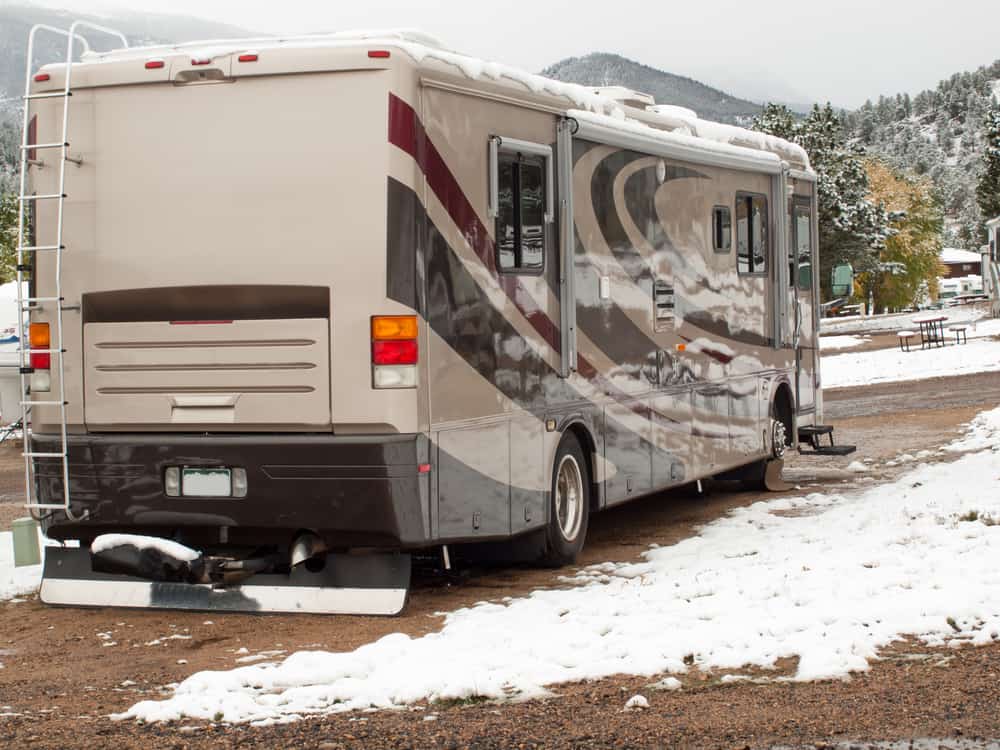
It is possible to comfortably live in your RV in cold winter weather while traveling, and it’s also possible while stationary.
In fact, if you’re stationary, it will be much less work!
The topics that we cover in this guide like insulation, heating, and protecting your RV plumbing all require work. But if you are a full-time RVer who is stationary, you only have to do it at the start of the season and you can use more permanent options that can remain in place all season long.
If you’re traveling, you may have to do it every time you set up camp. Luckily, there are temporary options for just about every method mentioned here.
Nobody said RVing was easy, but we think it’s worth it… and you probably agree if you’re still reading this.
Related: RV Types & RV Classes: Types of RVs Explained (Pros & Cons)
Insulating Your RV for Winter Living
Not all RVs are made equal. Some might claim to be 4-seasons, but the reality is: RV insulation is nothing like house insulation.
And the older your RV, the less effective the insulation may be. There are certain areas in your RV that are more prone to letting in cold air and drafts, and those are what you should focus on insulating.
Here are the main areas to consider insulating:
- Your RV Underbelly
Insulating Your RV Underbelly
You can insulate the underbelly of your RV most effectively with RV skirting. There are DIY RV skirting options as well as quick and easy custom skirting.
Your RV underbelly is the underneath of your RV. Some RVs have enclosed underbellies, and others are exposed. That means some of your plumbing is totally exposed to the elements – but insulation can help!
Insulating your RV underbelly is also important to help keep the interior of your camper warmer.
Since your camper sits up off the ground, this allows the cold winter air to hit every side of it. The walls, the ceiling, and the underbelly.
Cold winter wind whipping past and beneath your RV can pull the warmth out quickly! So, if you insulate your RV underbelly, you simultaneously help to control the temperature inside of your camper.
DIY RV Skirting
DIY RV skirting can be done for relatively cheap. You can use materials like foam board, tarp, or canvas to skirt your RV. Foam board RV skirting isn’t the best option for full-time RV travelers, but it is effective if you’re stationary.
Caution: Although some RVers may recommend it, we strongly advise against using hay bales to insulate your RV underbelly . Hay bales attract pests like mice, bugs, and snakes. They also harbor moisture and quickly rot and grow mold. And perhaps worst of all, hay bales packed under your RV perimeter are a fire hazard.
Custom RV Skirting
Custom RV skirting options can be purchased online, and this will probably be your best bet if you’re traveling.
A quick and easy solution is inflatable RV skirting . All you have to do with this type of skirt is lay it out and inflate it! It’s very simple and a great option if you’re traveling.
Insulating RV Windows
The more windows your RV has, the more cold it probably feels inside. And if you’re in a motorhome, you also have a windshield and cab windows to deal with!
There are many methods to insulate your RV windows. You can use reflective bubble wrap insulation cut-to-size to help keep your RV interior warmer. However, this type of RV window insulation blocks out natural light–something we could all use more of in the winter!
You can also insulate your RV window by using heat-shrink window film. This clear film creates an insulating barrier of air between your RV window and the interior of your RV, and you can still see outside.
For motorhomes, you can use reflective insulation for your windshield and cab windows, or just hang curtains to block the cab off from the rest of your RV.
Insulating Your Skylight and Vents
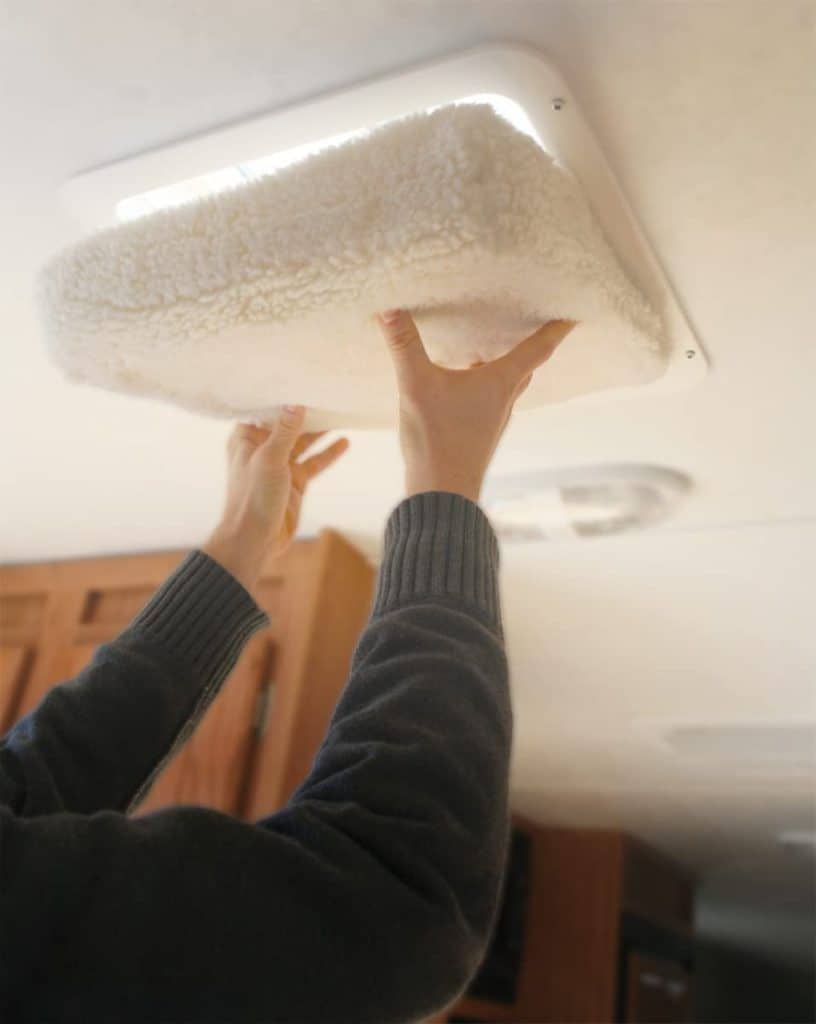
Most RVs have at least one skylight and a roof vent fan or two. These are prime areas for cold air and drafts!
You can insulate your RV skylight with the same shrink-wrap clear film that you use on your RV windows.
And for your vents, you can use these handy RV vent insulation pillows that are easily removable when you need to use the fan.
Insulating RV Slide Outs
Your RV slide outs are another area that are prone to letting in cold air and drafts. Try as they might, RV manufacturers can only insulate slide outs so much.
The main areas that RV slides let in cold air is around the seal and the windows.
You can insulate your RV slide outs by making sure your seals are clean and free of debris. If you still feel cold air coming in through them, you can tuck weather stripping into the lip of the slide out seal to help block cold air.
If you’re stationary, you can use a slide out blanket to further insulate the walls of your RV slide.
And, of course, insulating your RV slide out windows with shrink-wrap window film will help keep this area nice and cozy.
Insulating Your RV Floors
Waking up and stepping on a cold floor on a winter morning is an unpleasant experience, to say the least.
You can help insulate your RV floors and make them more comfortable to walk on by using thick rugs during the winter time.
Heating Your RV for Winter Living
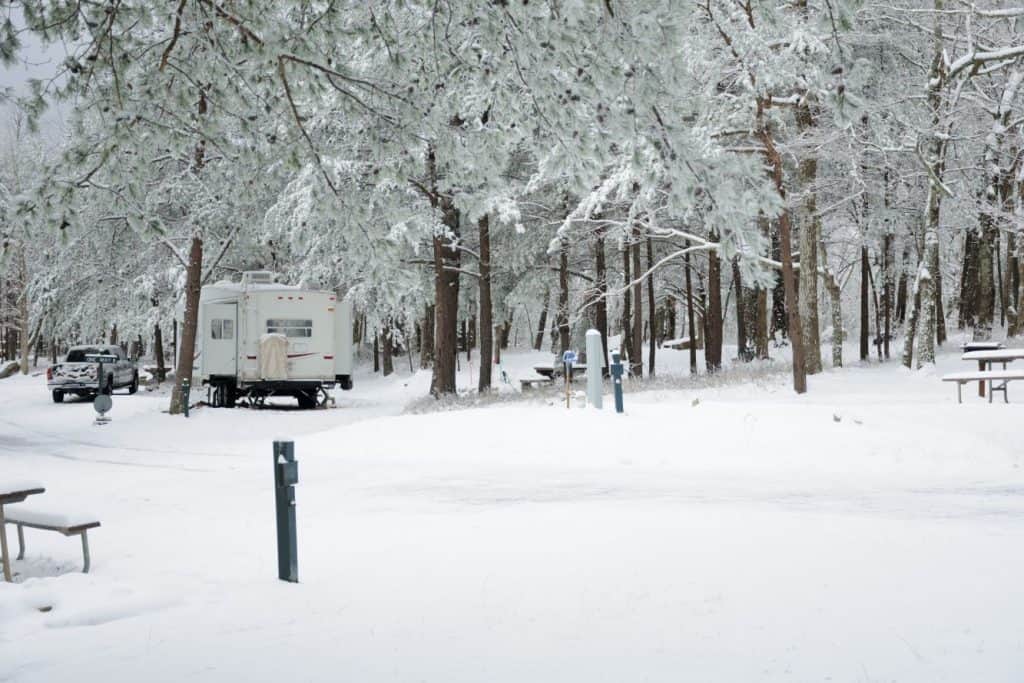
Most motorhomes, travel trailers, and fifth wheels come with some type of heat source, like a furnace.
Most RV furnaces are propane powered, so you will need to make sure that you keep your RV propane tank topped off during the winter time.
If you are stationary at a campground or RV park, you can get propane delivery. Sometimes the campground will provide this service, but almost every local area has a company that will come out to you if not.
You can also use space heaters to help heat your RV – both electric and propane powered. The Mr. Buddy heater is an excellent propane space heater and one we’ve used for years in our RV, but it can’t be left on unattended or while you sleep.
If you want to heat your RV without propane, you can use electric space heaters, install a diesel heater in your camper , or install an Alde hydronic heating system , which uses hot water to heat your RV.
If you choose to use an electric space heater, be sure that your RV electrical system can handle the power draw. And NEVER use a regular extension cord with a space heater as it is a major fire hazard and the cause of hundreds of fires every winter.
Heating Your RV Holding Tanks
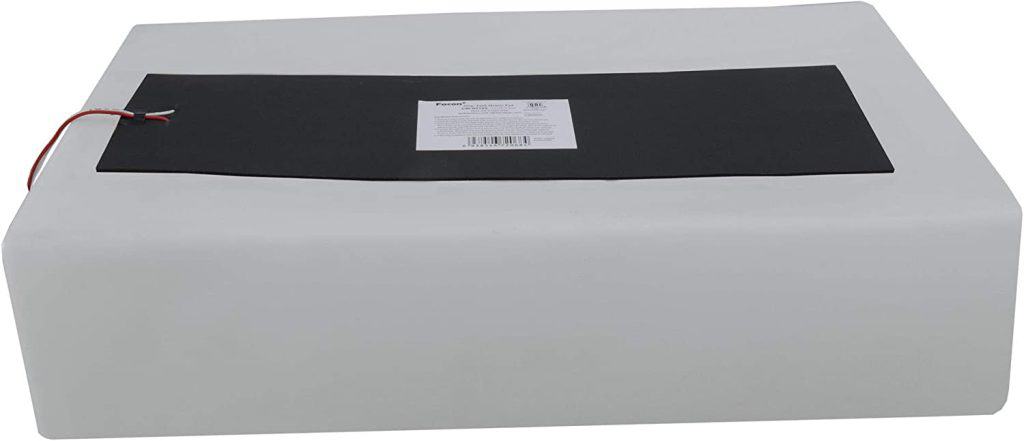
Your RV holding tanks need love, too! Especially if you don’t have a “4 season” RV.
Most RVs have 3 – 4 holding tanks. A fresh water tank, a gray water tank, and a black water tank.
If you have a large RV like a fifth wheel or toy hauler, you may have multiple gray water tanks or multiple black water tanks.
Each of these water tanks should be protected from freezing, because a frozen tank can crack, cause leaks, and be ridiculously expensive to repair.
And repairing a cracked black tank is something we don’t wish upon any RVer or RV technician…
Some RVs have RV tank heaters that you can turn on and off with a switch located somewhere inside the RV. This is basically just a giant heating pad that helps keep your tanks warm.
And some RVs have furnace ducts to the areas where the tanks are held to help keep the ambient temps above freezing.
But if you don’t have any of these options, you can help heat the tanks yourself. You can do this by:
- Installing RV tank heaters on your tanks to prevent freezing.
- Skirting your RV underbelly to keep your RV tanks from freezing.
- Creating a DIY heating duct to your tanks.
- Keeping a continuous supply of RV antifreeze in your gray and black tanks.
- Keeping your fresh water tank completely full (60 gallons of water takes significantly longer to freeze than 10 gallons).
How to Protect Your RV Plumbing from Freezing
Protecting your RV plumbing from freezing might just be the most important thing you do when living in your RV in the winter. There are a variety of ways to prevent your pipes and plumbing from freezing. You can use a heated water hose, heat tape around your plumbing, and make sure the area that holds your pipes and tanks stays above freezing.
If your RV pipes freeze, they’re very likely to crack when they thaw. This causes leaks, water damage, and is a huge headache to repair–not to mention a huge hit to your wallet.
In an RV, it is not recommended to drip your sink during freezing weather. You should keep your gray tank closed during freezing weather to protect your sewer hose from freezing, and dripping your faucets will cause your tank to fill up faster than usual.
Protecting RV Pipes and Holding Tanks
For many RVs, the pipes that run water to your sinks, appliances, and toilets are located in the storage bays or RV underbelly.
You can keep these pipes above freezing by using heat tape along the pipes, ducting a heater into the area that holds your plumbing, and skirting your RV.
Protecting Your Hoses
If you are about to have a day or night of below-freezing temps, it’s best to fill up your fresh water tank and disconnect your potable water hose.
A full fresh water tank will take much longer to freeze than a half-full tank, and by disconnecting your hose, you don’t have to worry about it freezing.
Alternatively, you can use a heated potable water hose and insulate the spigot of the campground.
Additionally, you should close your gray tank and remove your sewer hose. Only empty your gray and black tanks once they become full, and rinse and store your sewer hose after each time you dump.
This will help prevent your sewer hose from freezing or cracking in freezing winter temperatures.
Protecting Your RV Water Heater
Your RV water heater is another area that can freeze easily in cold weather. To protect your water heater, you have two main options.
- Keep your water heater on 24/7. This is a typical arrangement for people who live in their RVs full-time.
- Drain your water heater when temps are forecast to drop below freezing. This is more applicable to part-time RVers or campers. Doing this means you won’t have hot water!
RV Moisture Management in the Cold Winter Months
If you’re new to RVing, you might not know that moisture is a major problem for RVers in the winter.
In houses, the lack of humidity is a problem in winter time. But in RVs, it’s the opposite.
The reason for that is both the small space of the RV and the high-humidity activities we do like cooking and showering… and propane.
Did you know that for every gallon of propane burned by an RV furnace, an average of 1.6 gallons of moisture is released into the air as water vapor? It’s true!
( Source 1 ) ( Source 2 )
As such, controlling moisture and condensation is a never-ending battle for RVnig in the winter time.
For full-time RV living in the winter, we recommend a combination of a dehumidifier in the large common spaces of your RV, and using DampRid in cabinets and closets to help control moisture.
RV Fire and CO2 Safety in the Winter Time
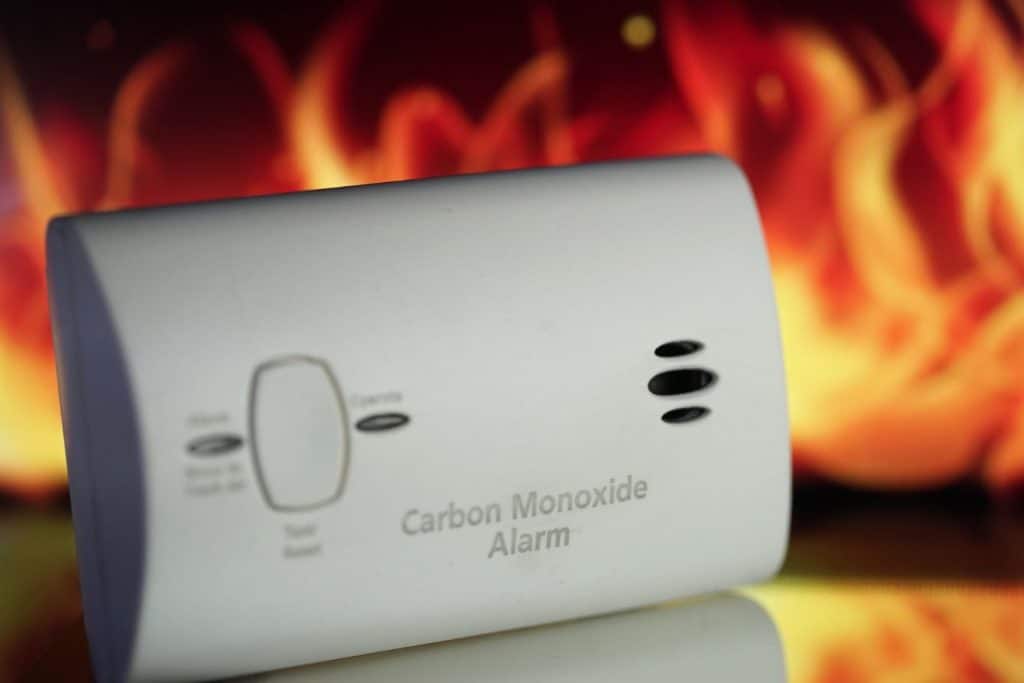
You should be cognizant of RV fire safety at all times of year, but cold winter months may need increased awareness. This is especially true for carbon monoxide, which is an odorless, tasteless, invisible gas that can be fatal.
Here are some RV fire safety and carbon monoxide tips for winter time.
- Use a carbon monoxide alarm in all main living and sleeping areas of your RV, and test them monthly.
- Never use an extension cord for an electric space heater.
- Never use a power strip for an electric space heater.
- Never leave a propane heater running unattended, such as while you’re outside or asleep.
- Keep your RV electrical system in good working order.
- Have your RV propane system inspected annually.
- Do not use hay to skirt your RV.
What to Do if Your RV Pipes Freeze
If your RV pipes freeze, you should check for cracks, check your water pump, and then get to work thawing them out.
You can thaw out your RV pipes in a few ways: using a heat gun or hair dryer, using heat tape around the pipes, or using a space heater.
If this is a job you feel unprepared to do yourself, you can also call a plumber.
It is very common for your RV pipes to crack when they freeze, but sometimes you might get lucky and not experience any cracking if it’s a light freeze.
If your pipes crack and you have a leak once they’ve been thawed out, you should address the leak immediately.
A great short-term solution to patching a leaking pipe is to use a product like Flex Seal tape. This tape can be applied to an active leak and it stops leaks instantly. However, you should still try to replace the pipe as soon as possible.
Snow, Ice, and Yucky Winter Weather
Snow, ice, and yucky winter weather are just a fact of life when you live in an RV in the winter.
Most times, they will cause no problems and need no special preparations other than your usual winter RVing prep.
However, if you are in an area that gets a ton of snow, you may need to try to keep your camper roof clear so that the weight of the snow doesn’t cause any issues.
Snow on your camper roof isn’t a bad thing until it becomes excessive. Wet or packed snow can be very heavy and can cause stress cracks in your RV roof membrane.
Are RVs Made for Winter Living?
Some RVs claim to be made for winter living, and these are typically referred to as “4 season” campers. 4 season travel trailers, fifth wheels, and motorhomes have additional options that help keep them comfortable and prepped for extreme heat and cold.
Additionally, you can purchase campers with a “4-season package”. This type of package will include upgrades to your camper like:
- Dual pane windows.
- Enclosed underbelly.
- A more powerful air conditioner.
- RV tank heaters.
- Ducted storage bays for heating plumbing.
- More insulation in walls, floor, and ceiling.
However, you can still live in an RV in the winter even if it isn’t a “4-season” camper. You will just have to do the additional work to keep it warm and keep your plumbing protected yourself.
Traveling in an RV During the Winter
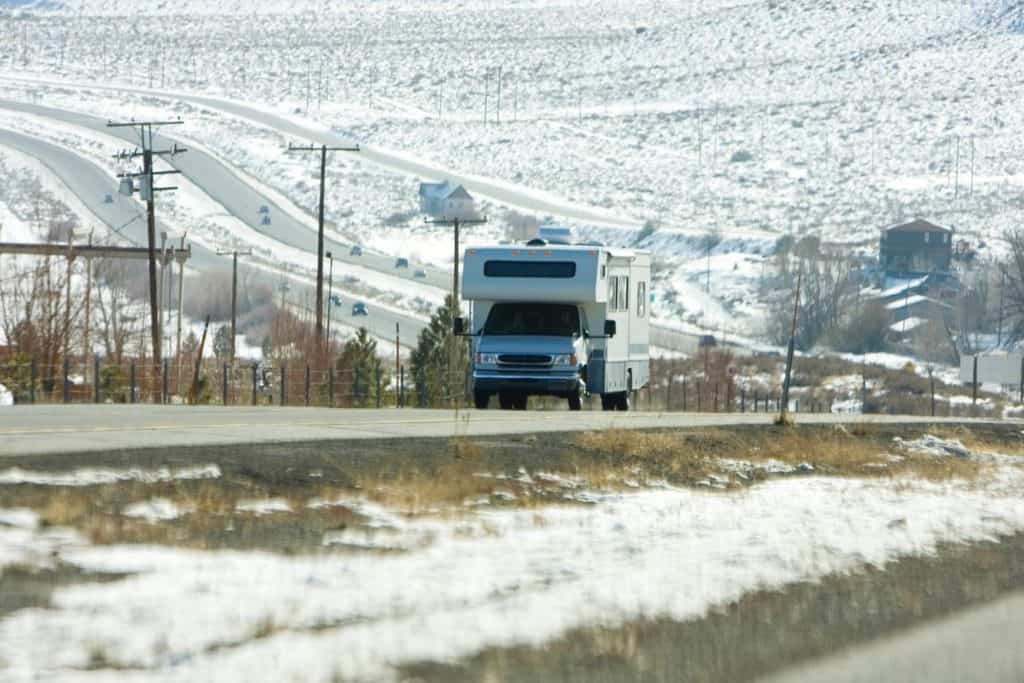
If you want to live and travel full-time in an RV, don’t let winter stop you! You can still travel in an RV during the winter, even in cold or snowy locations.
Here are some tips for RV winter travel to keep you safe out on the roads.
- Plan your travel days around inclement weather. If your campground checkout falls on a day of a winter storm, try to extend your stay. It’s never a good idea to be on the road during a winter storm if you don’t absolutely have to.
- Learn how to drive safely on snow and ice and what to do if you start to slip or slide.
- Get a good pair of winter tires on your motorhome or towing vehicle, if pulling a fifth wheel or travel trailer.
- Invest in snow chains. You never know when you will need them.
- Plan to stay at full hookup campgrounds often. If you rely on solar, you may not have a lot of power in the winter.
- Utilize travel-friendly RV skirting and insulation methods that are easy to set up and easy to take down and store while driving.
Conclusion: How to Live in an RV In Winter
Living comfortably and traveling safely in an RV comes down to a few main things:
- Insulating your RV.
- Heating your RV.
- Protecting your plumbing from freezing and cracking.
- Moisture and condensation management.
- Traveling safely and responsibly.
Truth be told, RVing is always a learning experience.
Learning how to stay warm and comfortable in your RV this winter will teach you a lot of lessons about how to be better prepared next winter, and so on and so forth.
Not every RVer needs to utilize every method talked about here–just do what you can with what you have.
Remember that the most important things to be aware of during winter RV living are:
- Protecting your RV plumbing from freezing.
- Being mindful of fire and carbon monoxide safety.
For everything else, you can bundle up to keep warm and avoid traveling during bad weather. As long as you keep yourself comfortable and avoid damage to your plumbing or health, your winter RV living experience will be a good one!
RVing Headquarters Team
RVing Headquarters is operated by long-time RV enthusiasts with over 8 years of RV industry expertise and full-time and part-time RV ownership experience. From motorhomes to trailers and campervans, we've done it all. Our Mission: to inspire, educate, and entertain anyone who is interested in the RV lifestyle.
Recent Posts
Should I Leave My Black Tank Open or Closed? Waste Tank Tips
Full hookup RV parks and campsites are the creme-de-la-creme of campsites, providing all the convenience of a sticks-and-bricks house in nature, with an ever-changing backyard. If you’re on full...
Why Are Campers 5th Wheel and Not Gooseneck Hitches?
Fifth wheel RVs are the largest towable campers with the most amenities and features. As you’re RV shopping or researching, you may be wondering: why are campers 5th wheel and not...


Living in an RV in the Winter: Pro Tips to Stay Warm and Safe
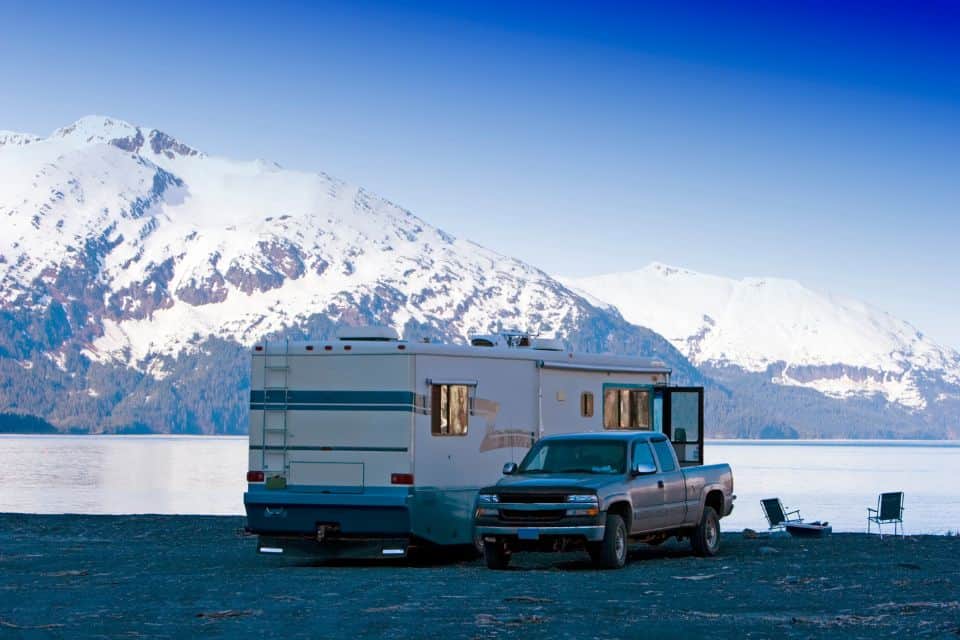
Year-round RV living doesn’t mean you need to snowbird every winter! With the right preparation , you can live in your RV quite comfortably, even in cold, snowy weather. Guest contributor, Julie Chickery, has expert tips for staying warm and safe in your RV, no matter where you spend the winter!
If you plan to travel in your RV this winter and don’t want to head south with the masses, you’re in luck. Winter RV living is not only possible, it’s actually quite comfortable IF you know the right tips and tricks. In this article, I’ll share how to make sure your home-on-wheels stays warm throughout the season regardless of type: motorhome, fifth wheel, or travel trailer.
Whether you’re living full time or just spending part of each year in cold climates, read below for my best advice on ensuring that everything inside your RV stays at its optimum condition no matter what happens outside!
Look for Year-Round Campgrounds
The most important consideration of cold weather camping or RV living is location. It’s important to realize that many campgrounds and RV parks in areas with freezing winter weather are not open year-round. These seasonal campgrounds typically close in late fall and don’t reopen until the spring.
Seasonal closures are due to lower demand during non-peak times of the year. It may be too costly for campgrounds to remain open for just a few campers.
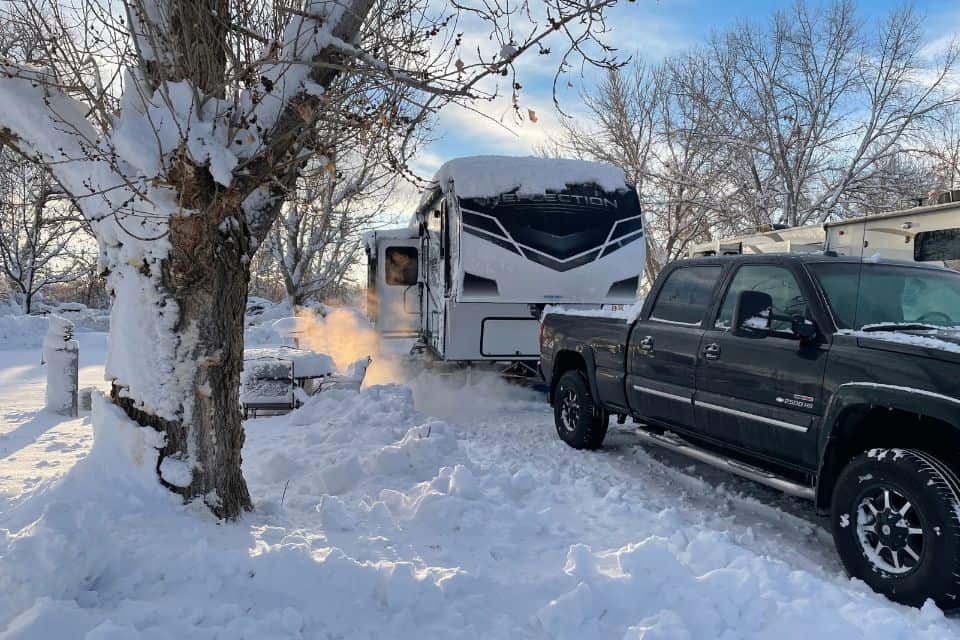
In addition, lower temperatures can pose safety hazards to both the campground and RV equipment if you aren’t fully prepared.
So, if you have your heart set on a beautiful snow-covered winter in your RV, make sure you verify that your chosen location is available.
Choose the Right Type of Heating
One of the most important things to consider when RVing in cold weather is how you will keep your RV warm.
The most common method is to use your RV’s heating system. Most RV heaters run on propane and are very effective, particularly with a smaller RV. However, you need to confirm the availability of propane in advance.
Your propane furnace can go through a lot of fuel if used continuously, so you’ll need on-site access to propane or sufficiently clear roads to go refill your propane at another location.
Some campgrounds and propane companies can even provide you with a large external propane tank to use during the coldest months so you don’t need to refill as often.
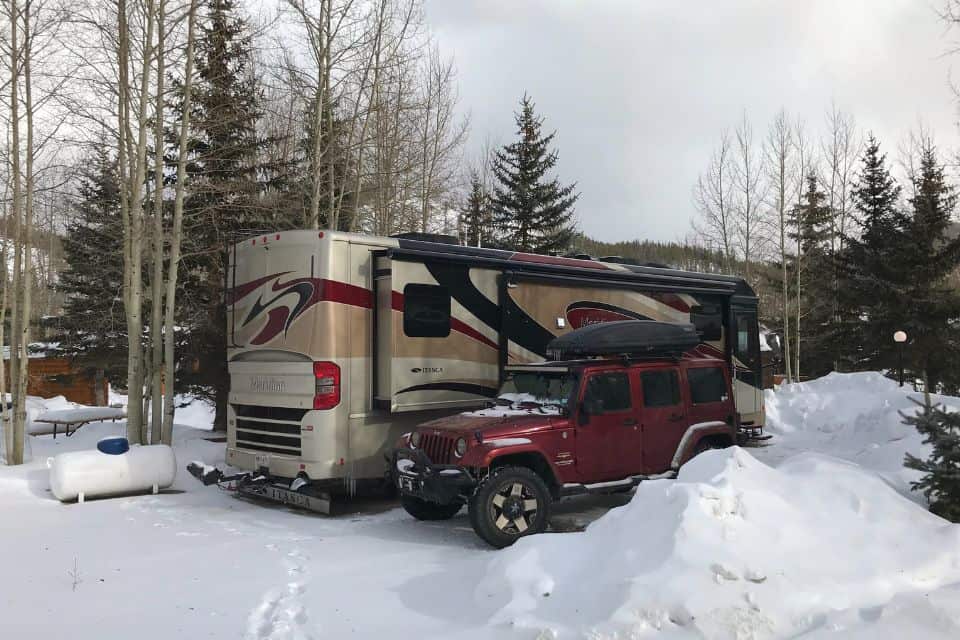
Depending on the size and layout of your RV, you will likely need to invest in a space heater or two.
These small heaters are a great way to warm your living space and can really make a huge difference in your daily comfort during especially cold weather. They are also easy to store for the rest of the year.
The two most common types of space heaters are electric and propane.
Electric heater: This type is especially popular when you are connected to power in a campground or RV park. You can use more than one, which will reduce your dependence on your RV’s furnace, especially if you have a larger RV. We use this electric heater , which also has a cool air fan for use during the summer.
Propane heater : These heaters use propane gas as fuel and are a good option if you are billed extra for electricity. The initial purchase can be a bit more expensive than electric space heaters, but they are often more efficient. If you use a reputable brand, like Mr. Heater, it will come with a safety shut off low oxygen sensor .
If you are using portable space heaters, take extra safety precautions, such as:
- Never leave a space heater unattended.
- Only use a propane space heater in well-ventilated areas.
- Make sure the area around the heater is clear of any flammable objects.
- Keep a fire extinguisher close by in case of emergency.
You can also reduce the amount of heat that you need to use on cold nights by using flannel sheets and electric blankets or a thermal sleeping bag.
Protect Your RV from Heat Loss
Whether you are using propane or electricity for heating your RV, you still need to take additional steps to keep the heat in and the cold out. One of the most important ways to protect your RV from heat loss in the winter is to make sure it is well-insulated.
If you’re planning to do a lot of winter RVing, consider purchasing a four-season rig. Keep in mind that virtually no RV is constructed for sub-zero temperatures, but there are some that can handle freezing temperatures well.
While there is no industry standard for a four-season RV designation, the most important thing to look for is superior insulation in the interior walls and ceiling, as well as in the basement storage. This insulation goes a long way towards keeping the warm air inside your RV.
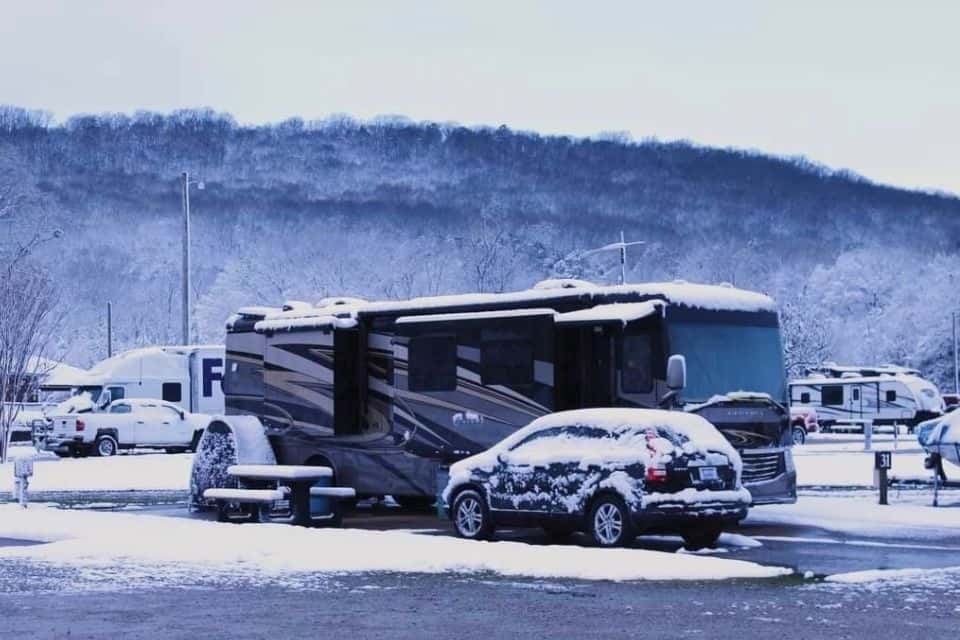
Don’t worry if you don’t have a four-season RV. There are still several steps you can take to minimize any potential heat loss by adding extra insulation yourself.
First, look for drafty areas around your RV windows, skylights, fans, doors, slide-outs, and roof vent that allow the cold air in. Then, make sure to seal them with weatherstripping .
Foam inserts also create an effective barrier in skylights and the back of cabinets.
If you don’t have dual pane windows, consider using additional insulation in the form of foam panels or a product like Reflectix, a highly-pliable thermal insulating material. This extra insulation will help keep the heat in the RV and prevent it from escaping.
The advantage to using panels cut to size is that you can easily remove them on warm days to allow in more sunlight.
Another simple fix is to install weather blocking or thermal curtains in your RV. While most RVs come with blinds and valances, you can easily add tension curtain rods under the valance to hang curtains.
Install Skirting Around the Bottom of the RV
Insulation doesn’t only apply to the interior of your RV. One way to manage extreme temperatures in the winter is with some type of skirting around your RV.
Skirting is simply a material that you attach to the bottom of your RV, encircling it completely. This will create a barrier between your RV and the cold ground, helping to keep your RV warmer in the winter.
You can buy RV skirting at camping stores, but one unique product I recently saw at a trade show is called AirSkirts . This inflatable skirting system is made of heavy-duty PVC that serves as insulation and also acts as a barrier against wind, snow, and ice.
AirSkirts come in nine different sizes to ensure the proper fit and are inflatable so that you don’t need to affix the skirt to your RV with any type of snaps or adhesive.
The AirSkirts website helps you select which skirting kit you need based on the type/size of your RV. Use the coupon code “POPSMOKE” to save $100!
If you’re not interested in buying ready-made skirting for your RV, you can also create your own DIY version using some basic materials available at any hardware store. Here’s how:
- Measure the height and width of your RV. You’ll need these measurements to create the skirt template.
- Cut foam insulation boards or heavy plastic about one inch higher than the height of the space between your RV and the ground.
- If using plastic, attach elastic bands to each side so that it will fit snugly around your RV.
- Install the foam board or plastic skirting around the base of your RV using adhesive or zip ties. Don’t use duct tape, as it will take the paint off your RV.
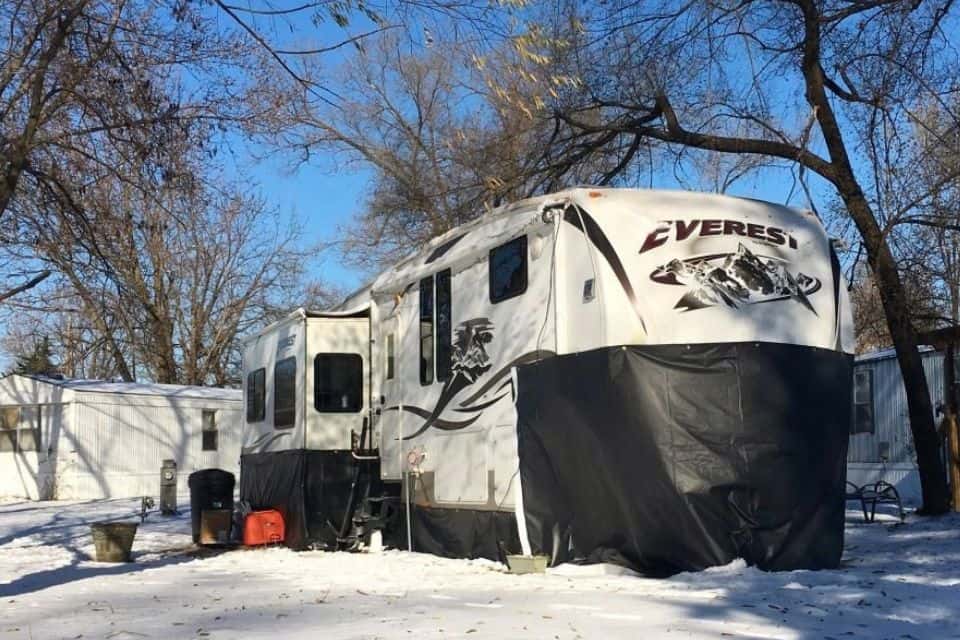
Remember to check the policies of the RV park where you plan to stay. Some parks have specific rules about the type of skirting allowed.
Minimize Moisture Inside Your RV
Once your RV is all warm and cozy, beware of the dangers of condensation. The resulting excess moisture can cause a big problem in RVs during the winter, as it can lead to the growth of mold and mildew.
The best solution to prevent excess moisture is using a dehumidifier. Dehumidifiers remove the moisture from the air and deposit it in a holding tank that must be emptied and cleaned regularly.
There are two different types of dehumidifiers: passive and electric.
- An advantage of passive dehumidifiers is that they do not require power. ( We like this one when we’re not connected). Most passive dehumidifiers use calcium chloride crystals to pull the moisture from the air. The crystals need to be replaced regularly.
- Electric dehumidifiers typically have a higher capacity than passive models, which makes them more effective at removing moisture from the air. When we have power, we use a couple of these .
This renewable dehumidifier is a hybrid of the two. You recharge the silica gel beads every 20 – 30 days, so you don’t need power to use it.
Keep the Water Flowing
If you’re going to live in your RV during cold weather, it’s especially important to take steps to protect your water supply. Your RV has three distinct water tanks: fresh, gray, and black.
Fresh Water Tank
During the winter, you’ll want to keep your fresh water tank as full as possible. This is necessary for two reasons.
The first is that you must disconnect your water hose from the water spigot any time the outdoor temperature drops to freezing. You will need plenty of water to continue using your RV’s sinks, showers, and toilets.
The second reason for keeping those water tanks topped off is that more water in your tank, combined with the skirting previously discussed, reduces the chance of it freezing.
Your best bet is to use a heated water hose throughout the winter to reduce the chance of a catastrophe for those times when there is an unexpected dip in temperature.
An important feature to look for is Ground Fault Circuit Interrupter (GFCI) protection. These specialty hoses can be quite pricey, so if you are handy, you may also want to consider using heat tape or a heat cable.
Even with a heated hose, campgrounds will typically require you to disconnect overnight when temperatures are projected to dip below freezing to prevent any damage to the water line, water pressure regulator, and associated hardware.
Holding Tanks (Gray and Black Water)
If you don’t have a four-season RV with heated underbellies and insulated holding tanks, you still have options.
If the temperatures only drop below freezing at night, simply keeping your gray and black wastewater tanks closed until it is time to dump them will suffice. However, if you’re going to stay somewhere with prolonged freezing weather, then you may want to invest in an RV tank heater kit .
These consist of thick heater pads for your fresh, gray, or black tanks, as well as an elbow heater pad for the water pipes. The tank heaters come with a sensor that will automatically turn them off. The product is fairly straightforward to install and will ensure your tanks aren’t damaged or cracked as a result of freezing.
Finally, don’t forget about your sewer hose. To avoid damage that can be caused by freezing, do two simple things.
First, keep the hose off the ground using an inexpensive sewer hose support .
Second, keep it disconnected when the weather is expected to dip below freezing. If you will be stationary for the winter and don’t want to disconnect your hose regularly, you can purchase a more expensive sewer hose made with thicker material and place it on a heated sewer hose support system .
Keep Up with Battery Maintenance
Even when you are connected to shore power at an RV park, you still need to use your RV batteries (also known as house batteries) for many things, such as overhead lights, fans, water pump, and water heater.
While your RV converter is intended to keep your batteries charged when connected to power, batteries tend to lose their charge more quickly in cold weather. It’s crucial to take steps to keep them warm. Just how warm they need to be will depend on the type of batteries you have:
- Standard flooded wet cell lead acid batteries are the most common type of RV battery because they are the least expensive. However, they are also the most susceptible to cold weather and require more upkeep.
- Absorbent Glass Mat (AGM) lead acid batteries are more reliable in cold temperatures, require less maintenance, and last longer than the flooded cell battery.
- Lithium batteries have the longest lifespan and require virtually no maintenance. Battle Born, one of the leading manufacturers of this type of batteries , installs a battery monitoring system in each battery with an automatic shut off that keeps them from charging at 25 degrees to protect them from damage.
Regardless of what type of battery you have, using a heat pad can keep the battery warm enough to accept the charge. Purchasing a heat pad with an ambient temperature sensor is the best option because it automatically turns on when the temperature is below 35 degrees and switches off when it reaches 45 degrees.
Practice Safe Driving
If you’re going to travel between campgrounds during the winter, it’s a good idea to follow these basic tips for driving your RV in winter weather conditions:
- Check your tires regularly and ensure that they are properly inflated.
- Drive slowly and avoid sudden stops or changes in direction.
- Keep a safe distance from other vehicles.
- Avoid dangerous roadway and weather conditions by staying up to date on weather forecasts and road closures.
You should also keep an emergency kit in your vehicle that includes:
- Ice scraper and snow brush
- Sand or kitty litter
- Road flares or reflectors
- First Aid kit
- Extra clothing, including hats and gloves
- Bottled water and snacks
If you’re planning some winter camping this year, make sure to prepare your RV accordingly. Keep in mind that one of the most important things you can do is to buy all of your materials and test them out in advance. You don’t want to wait until you need them and realize the vendors are sold out or there aren’t any available in your area. By taking these precautions, you can help ensure a safe and enjoyable winter season in your RV.
Author Bio : Julie Chickery is the co-author of Chickery’s Travels . Julie and her husband, Sean, are both U.S. Air Force retirees and RV enthusiasts who lived in their Fifth Wheel full-time for six years. Chickery’s Travels is an educational and inspirational website and YouTube channel documenting their travels and lessons learned. In addition, they created Full-Time RV Finance , a program to help you realize your full-time travel dreams.
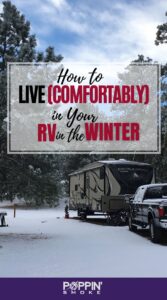
Good article? Share it!
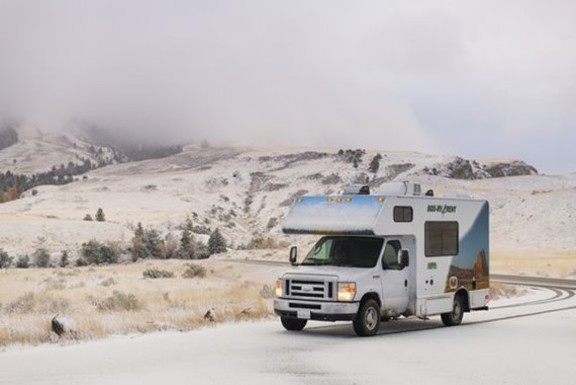
What’s It Like Living Full-Time in an RV in Winter?
What is it like to live full-time in an RV in winter? We get this question all the time since people have trouble wrapping their heads around the idea that living full-time in an RV in winter is doable.
Let me assure you, RV camping in winter is very doable, but it takes some getting used to — and a lot of preparation!
RV Camping in Winter? Prepare Your RV for the Cold!
While living full-time in an RV in winter is in many ways far more convenient than a house, RVs are also far more vulnerable to the effects of freezing temperatures than a regular house is. Even if it is claimed that it is a "four-season" motorhome, if you don't take steps to winterize your RV, you could find yourself in trouble.
One winter's night at a northeastern campground, our pipes burst after lows hit subzero temperatures. See, unlike a house's plumbing system, the undercarriage of an RV is usually fully exposed to the elements. Without adequate protection, plumbing and hoses could freeze or burst — or both! — in extremely cold weather.
Don't forget the insulation!
We'd taken for granted that our RV was ready for the cold, but the opposite was the case: The belly of our beast wasn't properly insulated. Water in a pipe froze overnight, expanded, and caused it to burst. We learned the importance of RV underbelly insulation first-hand… an expensive mistake we won't make again!
Make use of heat tape
Nowadays, we get ready for winter by wrapping our RV pipes in thermostatic heat tape . It's not actually tape; it’s flat wiring or a cable you plug in that wraps around vulnerable pipes. It comes in various lengths and automatically activates in freezing temps; some kinds can keep pipes safe up to -40 degrees Fahrenheit!
As for your freshwater hoses, you can wrap those in heat tape, too — or purchase a heated water hose that you can swap out as the seasons change.
How To Stay Warm When RV Camping in Winter
Beyond keeping your RV in working order in winter, there's another challenge in staying warm inside! If you're living full-time in an RV in winter, you're going to get a lot of mileage out of your propane-fueled furnace.
Try not to run out of propane
If you purchased an RV in warmer weather — as we did — and never needed to run your furnace before experiencing living full-time in an RV in winter, then you're at something of a disadvantage: You don't know how quickly your RV's furnace will use up propane!
If you're staying at a campground that sells propane , you're in luck… but not every campground offers such an amenity.
We did actually run out of propane one time during the first winter we spent in our RV, but were saved by staying at a campground that, indeed, did sell propane!
After that first incident, we realized how quickly running the RV propane furnace could eat up our propane, and we did what we could to stock up. In addition, we learned how to make our propane last a little longer by heating up our RV and ourselves in other ways.
Alternatives to using your RV propane furnace
The truth is that you don't really need to heat up your whole RV overnight in winter; long as you can keep your bedroom as warm as you need it to be to comfortably sleep, you're good. Because we tend to stay at campgrounds with electric hookups as often as possible, we are usually able to use the mini space heater we have wherever we go.
Using that mini space heater along with sleeping bags rated for cold weather , we're able to save propane overnight and only use it when we really need it. This allows us to save propane to run the furnace when even a space heater and a thermal sleeping bag can't keep out the chill.
Stay Warm Outside When Living Full-Time in an RV in Winter
Of course, you're not going to spend all of your time inside if you're living full-time in an RV in winter. You're going to go hiking, fishing, and spend time by the campfire. Therefore, it is really important to ensure you have clothing that fits the season when cold-weather camping .
Outerwear is what likely comes to mind at the mention of clothes that fit the winter season — but that's not all you need. Since space is likely limited in your RV, you can't count on being able to store a mass of clothes for each season.
So, for winter, be sure you have some thermal base layers that easily fold up and don't take up a lot of space. You can wear less and still stay warm. Oh, and if you don't have insulated footwear, trust me — get some!
To Snowbird or Not To Snowbird?
By the way, some people avoid "winter weather" during winter as much as possible and venture down to southern regions just like the birds flock south. We tried the snowbird life ourselves but found that you can experience ridiculously cold temps even in places like Arizona!
Rather than run away from the cold each winter, we embrace it! By winterizing our RV when the weather gets chilly and having adequate clothing on hand, we can go practically anywhere we want in winter — limited only by nor'easters, or campgrounds that close until spring.
Ready To Go RV Camping in Winter? Try It!
Related articles.

How to Start a Travel Blog in 10 Easy Steps
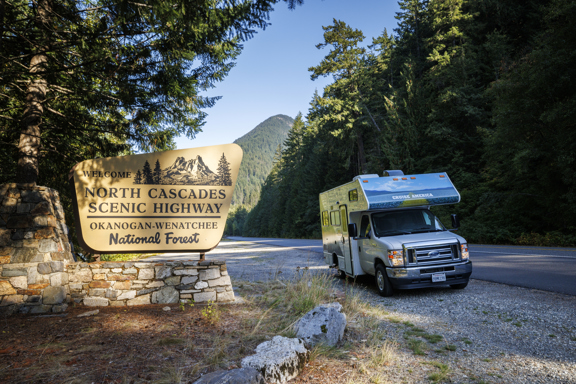
Why I Swapped Boat Life for RV Life

The Ultimate List of RV Travel Blog Ideas
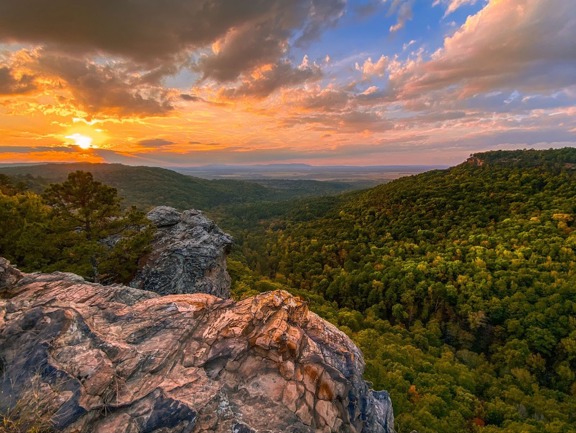
A Guide to State Parks in Arkansas

Top Harvest Host Locations in California for Wine Enthusiasts

The Best Glamping Resorts for RVs Hands Down
Share this RV trip idea with friends & family
Complete Guide to Comfortable Full-Time RV Living in Winter
I’ve combined my most popular posts about full-time RV living in winter to create a comprehensive guide to prepare you and your RV for winter living.
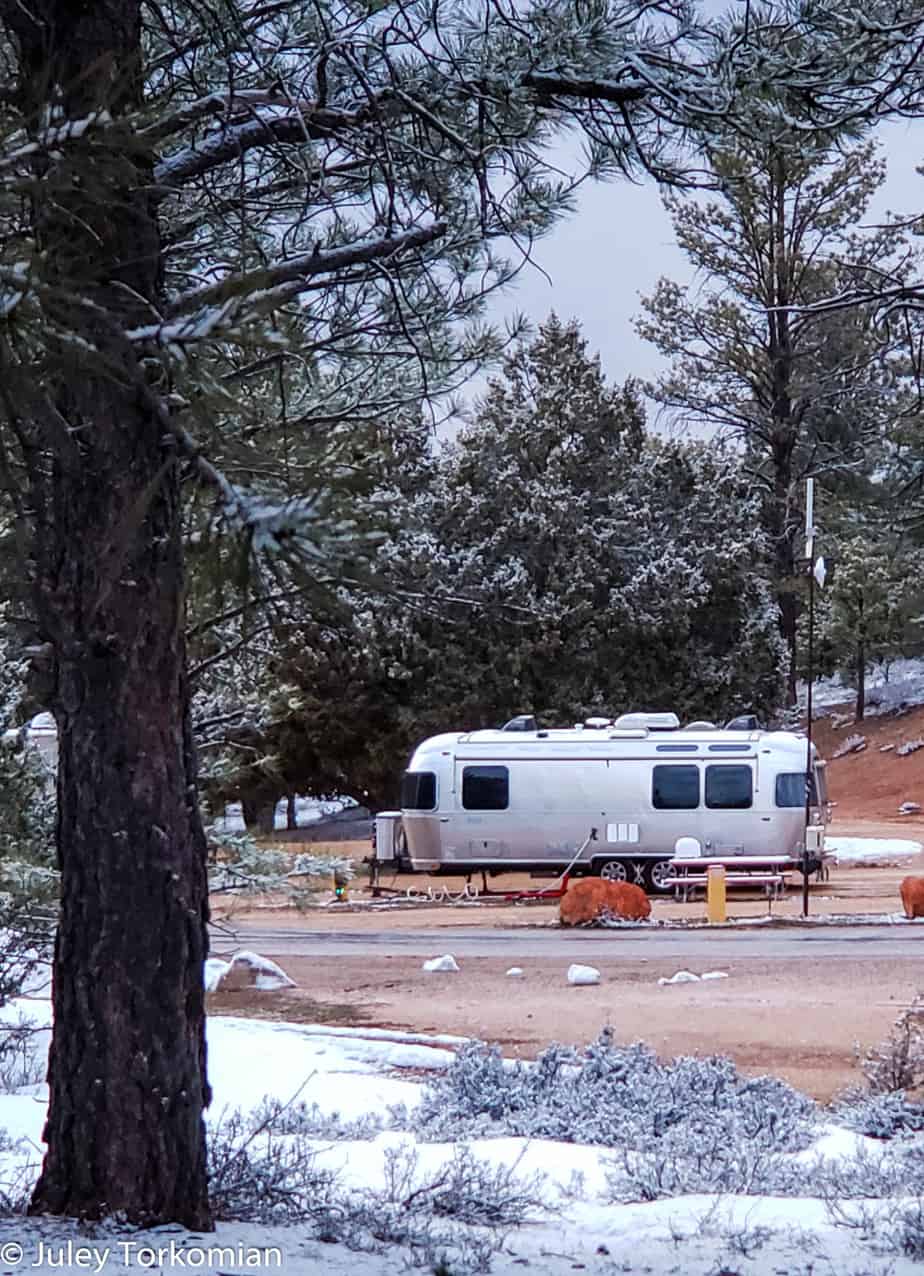
The basics are all covered in depth below but they include skirting, insulation, weather stripping, heating options, condensation prevention, water line, and holding tank safety,
Keeping The Floors Warm
I have a couple of 3×5, washable rugs to help insulate the floors a bit. However, I know there is an electric warmer you can place under a rug. I’m going to look into that. Unless you have a big fat bank account, planning to RV in winter means keeping energy consumption in mind so I’m not overloading my 30-amp system and blowing breakers and breaking the bank.
Heating Options
When the temperature outside drops below about 43-ish degrees, the heat pump cannot sufficiently warm the RV so heating has to be done by the furnace or a space heater.
Space heaters in RVs are very controversial. Many feel such a heavy and constant draw of power can overheat the wiring and cause a fire. I’m certainly no expert so my plan is to use a combination of the two but electric heat will be used sparingly and only when I’m home and awake. Also, never plug a space heater into a power strip or extension cord. This can also lead to overheating and fire.
My furnace is directly below my seat on the back end of the Airstream. I basically sit over the top of it and it gets hot in this spot while the rest of the trailer stays chilly. I’ve purchased a small fan to place under the area where I sit to pull the heat out and circulate it through the rest of the Airstream. Hopefully, that helps with my hot hiney and my cold bedroom and bathroom.
Using the furnace means using a lot of propane so I’ll probably get a larger propane tank. I have two 30 pound tanks right now but that’ll go fast.
Plumbing and Holding Tanks
The main reason it’s important to use propane heat when the temperatures get down to or below freezing, it to keep your plumbing from freezing. The warm air flowing through the heating ducts helps keep the holding tanks from freezing. My holding tanks also have warmers to keep them from freezing.
Skirt Your RV
My RV skirting for winter took just two afternoons to install on my own.
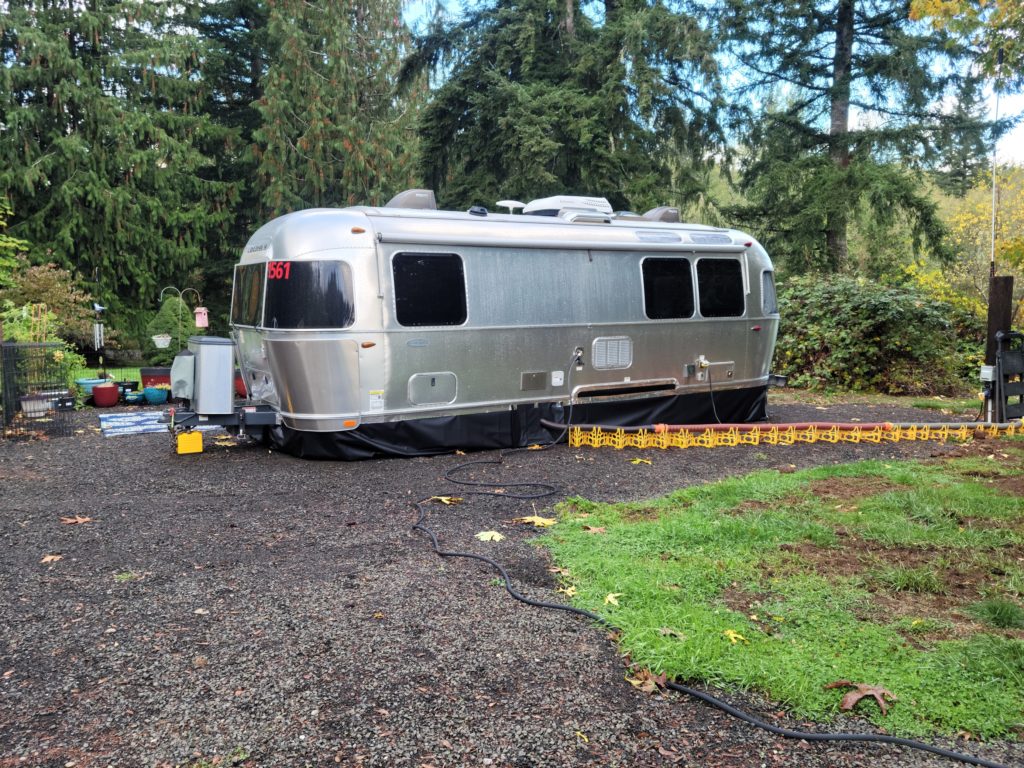
One of the things that helps the most in keeping an RV warmer in the winter is skirting. Placing a barrier around the bottom of the RV to keep warmer air trapped under the RV and colder air out makes a considerable difference. Keeping the underbelly warm will help us RV in winter in comfort. Some people even put a small space heater or heat lamp under their rig to keep the air warmer which in turn, keeps the RV warmer.
Why Skirt Your RV For Winter?
Skirting your RV for winter is a means of keeping out cold air and collecting any warmth that radiates from your RV. As temperatures drop it gets harder and harder to keep your RV warm inside. All that cold air blowing across the bottom of your RV only increases the challenge.
It’s imperative to keep your plumbing system from freezing. Having no water is a major inconvenience but the damage caused by freezing water lines and tanks can cost thousands in repairs.
RV Skirting Solutions
When I started looking at RV skirting solutions for my Airstream the main thing that stood out to me was the price. Options I explored and priced out were surprisingly expensive and ranged from about $500 to $2,000. I spent hours searching the web for an inexpensive DIY RV skirting option then I found billboard vinyl.
I choose billboard vinyl because the cost is very reasonable (super cheap), it’s flexible for Bridget’s (my Airstream) curves. I purchased my vinyl from Billboardtarps.com . I purchased a 4′ x 65′ piece of heavy black vinyl. The cost for my vinyl was $43 plus tax and shipping for a grand total of $69.
If you choose vinyl as your DIY RV skirting solution, make sure to check the shipping rates. One site wanted more for shipping than the cost of the vinyl. Billboardtarps.com was great. They shipped fast via FedEx and their shipping charge was very reasonable. You can read all the details about skirting your RV with billboard vinyl in this post; RV Skirting for Winter – How To Skirt Your RV On The Cheap .
RV Skirting for Winter – How To Skirt Your RV On The Cheap
When determining how much vinyl to order, overestimate a bit. I cut it really close and had only about a 2′ by 2′ chunk leftover.
My first step was to lay the vinyl out around the trailer.
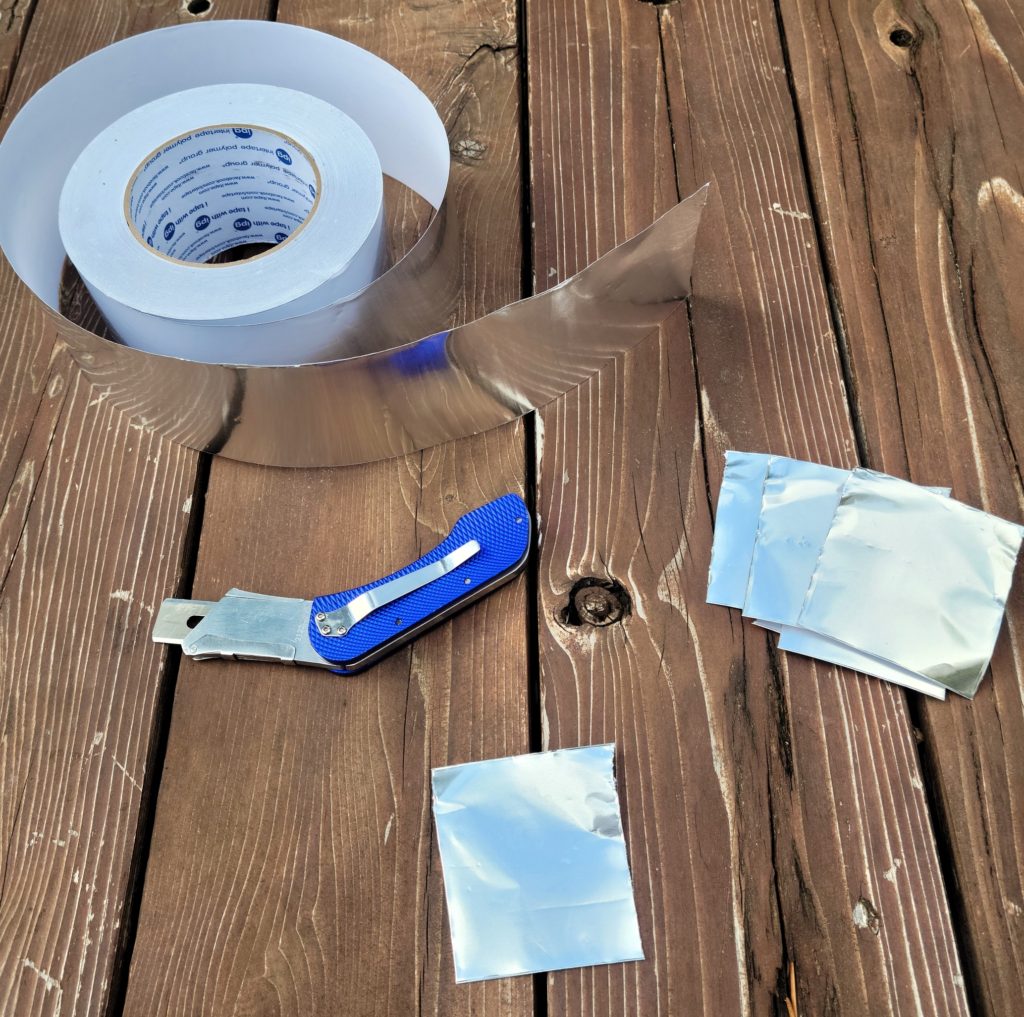
To attach the vinyl, I used a 3″ Cold Weather Aluminum Foil Tape , a utility knife, and a tape measure. Before I got started, I cut a bunch of roughly 2′ sections of foil tape.
I applied a small section of tape every three feet or so along on side of the trailer.
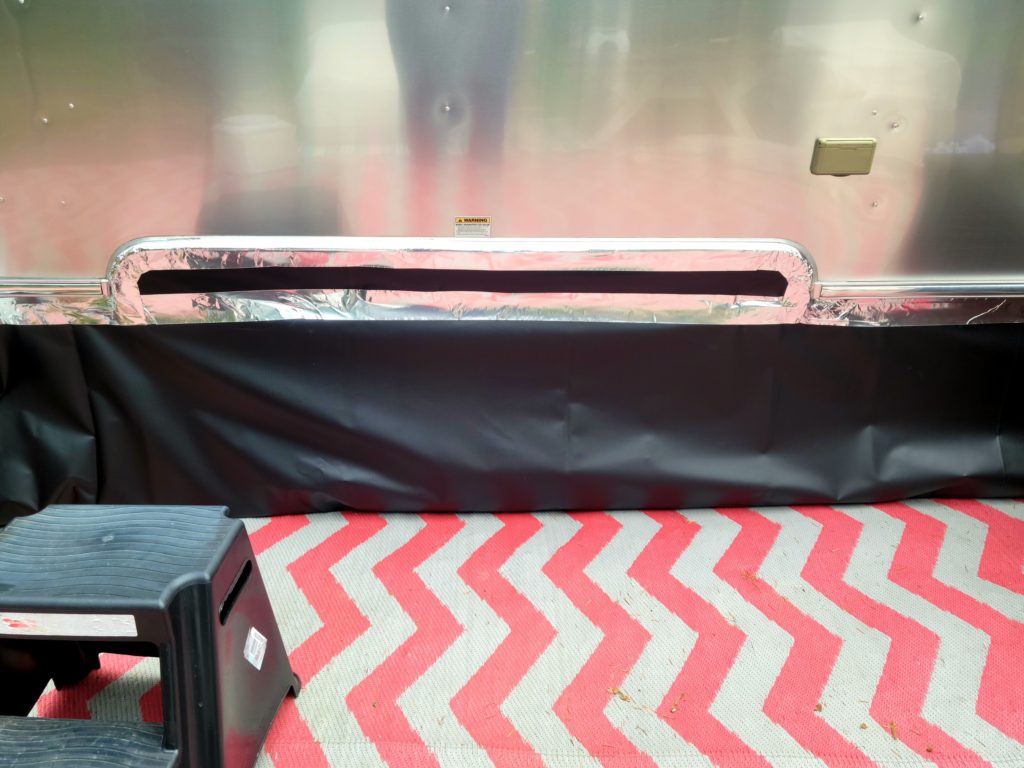
I’m pretty happy with the way the wheel wells turned out. The stairs and front end around the A-frame were tricky though.
At the back end of the trailer, my concern was there is no vertical surface to tape the vinyl to and I wasn’t sure if the tape would hold applied horizontally to the underside of the bumper.
The underside of the bumper and trailer is covered with a piece of smooth sheet metal. I decided to try taping the vinyl in place as I had done with the rest of the trailer. So far the tape is holding really well. I’ve checked it several times and we have had some severe wind storms.
I made an opening for the sewer hose and added a flap secured by an outdoor self-adhesive hook and loop closure to make it easy to open and close when I need to dump my tanks.
Seal Those Places Where Cold Air Gets In
Outside storage bays and under the beds.
I have twin beds in my Airstream and under each of them is a storage bay accessible from the outside. I’ve had the platform off the spare bed but never really considered just how much cold (or hot) air can enter through that space.
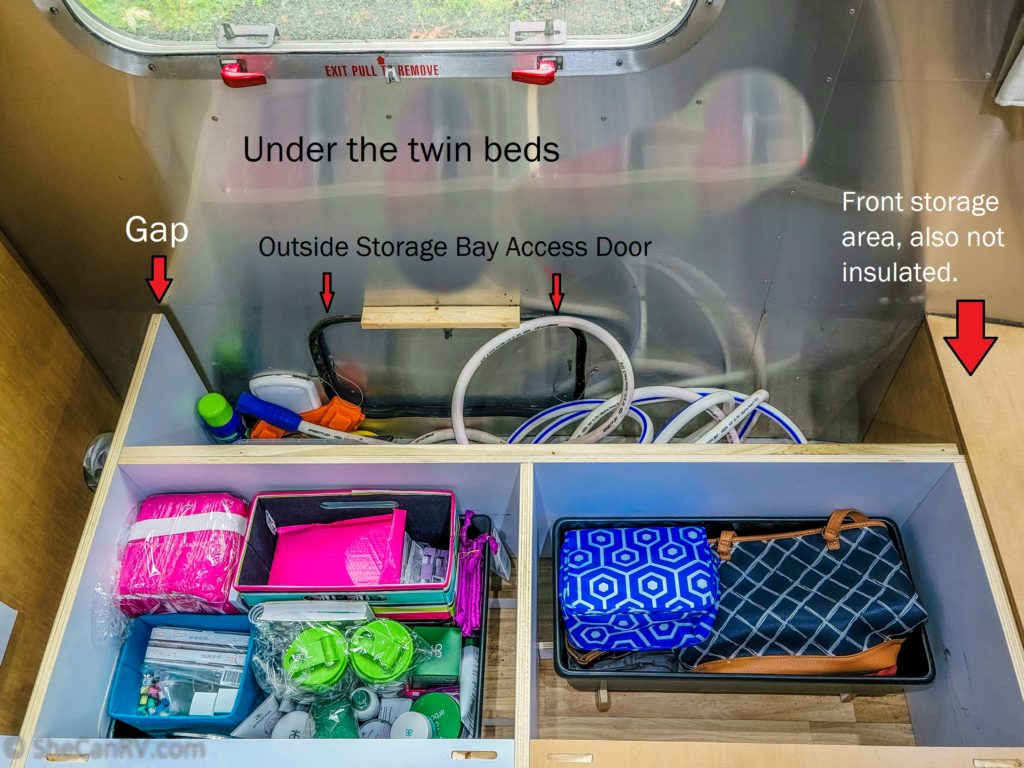
Under the bed platform is interior and exterior storage. There was no insulation and there are some large gaps between the exterior wall and the frame of the storage area. There isn’t much I can do about the air coming in through the exterior door but I insulated three walls in the exterior bay with Reflectix and filled the gaps with weather stripping. You can read how to do this in your RV here; Winter RV Living – Creative Ways To Keep Your RV Warmer .
Winter RV Living – Creative Ways To Keep Your RV Warmer
I flipped over the plywood bed platform to expose the underside and applied self-adhesive insulation/sound deadening material meant for cars. I used this stuff; Car Sound Deadening & Heat Insulation Closed Cell Foam .
This has been one of the best things I have done to keep my RV warmer this winter. It’s been immensely helpful.
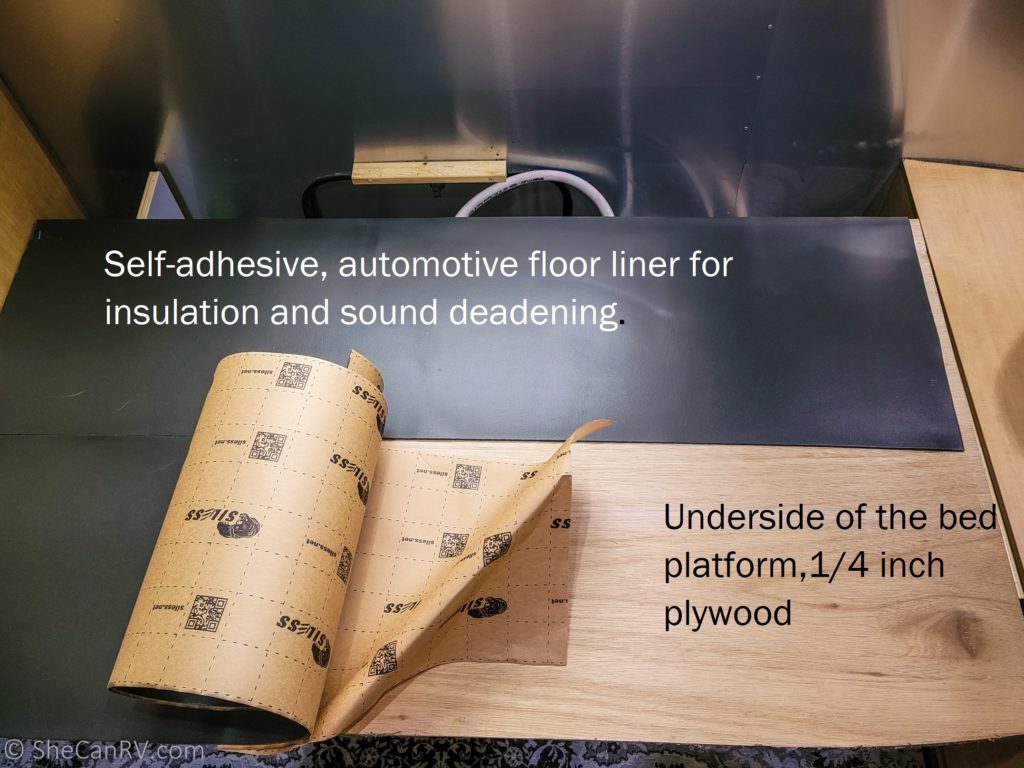
I forced weatherstripping into the large gaps in the exterior storage bay. I used Sponge Neoprene Stripping With Adhesive 1 in Wide X 1/2 in Thick X 25′ Long.
I wrapped the walls in the exterior storage bay with Reflectix to insulate further. I also taped it in place using the aluminum tape I mentioned above. I used Double Bubble Reflective Foil Insulation .
Weatherstripping Around The Entry Door
I applied new weatherstripping around the entry door. It is thick, heavy-duty neoprene. It’s a bit too wide for the door frame but it hasn’t been a problem. It’s too thick for the hinge side of the door but thinner weatherstripping fills that gap well. I can no longer see daylight through the gap. I call that a win.
Cover Your Screen Door With Clear Window Insulation.
I covered the screened sections of my screen door with clear plastic. I did this thinking it would help with the drafts around the entry door but I also wanted to be able to leave the door open on nicer days without letting all the cold air in. The third reason is that my door is curved and there is no awning above it and that allows rain in when the door is open. This helps keep rain from coming in when I’m letting the dog in and out. I’ve been happy with the results.
I used a Frost King Window Insulation Kit V93H, 42-Inch by 62-Inch . This is the type you apply to the door or window frame using tape included in the key. Then you use a hairdryer to gently shrink the plastic tight so it’s quite transparent.
To see a demonstration of installation check out this video. How to install the Frost King Shrink Window Insulation Kit
You can read all the details about that project here. Cozy Full-Time RV Living in Winter – 5 More Simple Tips .
Cozy Full-Time RV Living in Winter – 5 More Simple Tips
Fan Vent Insulation Pillows
A lot of warm or cool air can be lost through those vents we all have in our ceilings. They make a product specifically for that problem. Safoner RV Vent Insulator And Skylight Cover with Reflective Surface . They make these without the reflective surface but when It’s really hot outside, I plan to use them as heat-reflecting insulation.
I’ve had these in place for about a month and I can tell the difference. Some of these have removable covers so read the description and get the style you think will work best for your situation.
More Bubble Insulation Applications
I find places where there is an outside opening like around the outdoor shower, freshwater fill door, storage bays, etc. it’s like a draft superhighway. To give a little added protection, I cut pieces of bubble insulation to fit snugly in those places.
I also lined the front storage bay, which is under the head of my bed, with bubble insulation . The vent for my inverter which is not in use needed to be covered also.
Water Hose Insulation
My brother installed a new water line and spigot closer to the trailer.
I just can’t bring myself to buy one of those expensive heated hoses. I have wrapped my water hose with foam pipe insulation and run an Automatic Electric Pipe Heating Cable, down the length of the water hose, and zip-tied it in place. I’ve also run the heating cable up the water pipe and added an insulated cover to the top to keep that part from freezing. The last time I was home during the winter we used this setup and it worked flawlessly.

Moisture Control
Controlling RV condensation is more important than you might think, and here’s why. Excess moisture builds up on hard surfaces and accumulates on soft surfaces. If this moisture is left unchecked, it will cause mold and mildew. That’s not good for you or your RV.
I have a dehumidifier I use when I’m in damp or humid areas. It also puts out a fair amount of heat when it’s running so that’ll help keep me warm.
Get a Hygrometer
It’s a good idea to know the actual moisture level in your RV. This super inexpensive device will tell you.
ThermoPro TP50 Digital Hygrometer Indoor Thermometer Room Thermometer and Humidity Gauge
The humidity level you’re looking for is below 60%. Ideally between 30% and 50%. I have mine set on 50%. I find that is comfortable without being too drying for my skin and sinus passages while keeping condensation at bay.
Run A Dehumidifier
Dehumidifiers actually pull moisture from the air. They come in many sizes based on the number of square feet they are able to dehumidify.
Several years ago I purchased a good quality dehumidifier to help with RV condensation. Much of the year it stays packed away under the bed but when I have to get it out, it’s a game-changer. My Airstream is only 25′ and many would consider my dehumidifier overkill. I tried one of those little blue and white ones you see RVers talking about but it just wasn’t up to the task.
Ivation 13-Pint Small-Area Desiccant Dehumidifier
I consider it mandatory equipment. Mine has a setting for the percentage of humidity I want to target and it shuts off when it reaches the target.
Avoid Propane Heat When Possible
Burning propane creates water vapor so your propane furnace adds moisture to the air. If at all possible, use your heat pump or electric heat. These alternatives to your propane furnace actually dry the air.
Circulate the Air
Circulating the air in your RV will help with moisture control by drawing out stagnant cool air and mixing it with the dryer air and moving it around. This helps it shed some of the moisture and will keep those nooks and crannies dryer.
Many people will advise you to keep a vent or window cracked open. I disagree. If you’re in a very wet climate, allowing in more damp air isn’t helping. I like to use a fan to move the air. I keep a small fan, on the lowest setting under the dinette. It really helps keep air circulating and those hard-to-reach spaces are dryer. This is my fan and I love it .
Cooking Causes Consensation
The fastest way to fill your RV with steamy air is cooking. I have learned using my Instant Pot is one of the least moisture-producing options. The steam is contained until you’re finished cooking. When you release the steam, place the Instant Pot directly under the running stove vent and release the steam. That way, it all goes outside.
Instant Pot Duo 7-in-1 Electric Pressure Cooker
Using your propane oven will create some moisture but not nearly as much as cooking on the stovetop. If you have a convection oven, that’s the best way to cook to reduce moisture.
Moisture Absorbers
Check your storage areas for moisture and that musty smell (you know the smell) frequently. If you have a spot that tends to get musty and you have ruled out a leak, try placing a moisture absorber like Damp Rid there. it will collect the moisture and keep your belongings dry and fresh smelling.
DampRid Fresh Scent Refillable Moisture Absorber – 10.5oz cups
Damprid hanging bag, moisture absorber, pack of 3, use the vent/fan while showering.
The only time I actually use the vents when it’s really damp outside is when I’m showering. Pulling out that warm, moist air is important when you’re fighting RV condensation. Be sure to close it again after you finish showering.
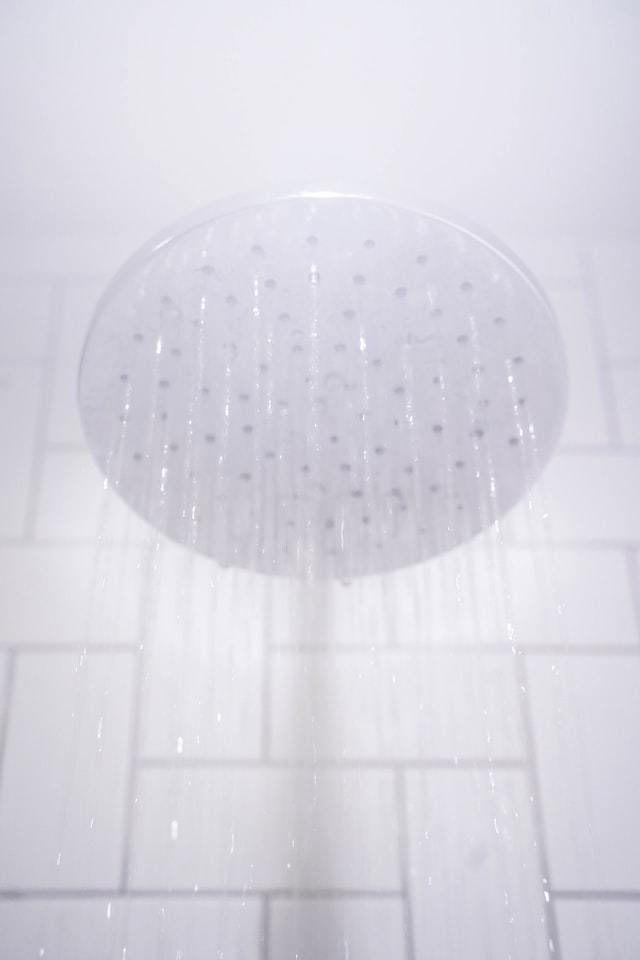
Insulate Your Windows
Many RVs have single-pane windows. A piece of glass with warm air on one side and cold air on the other will sweat. The good news is, it’s not hard or expensive to remedy this.
You may choose to insulate with clear plastic or reflectix if you don’t mind blocking the view. Leave a space between the insulation and the window where warmer air can collect for best results.
My bedroom windows are covered with bubble insulation to keep the cold air out. I don’t mind the darkness in there.
There you have it! My entire repertoire of cold weather RVing tips. Be sure to check out the linked posts for full details and how-to information.
If you like this post, please pin it.
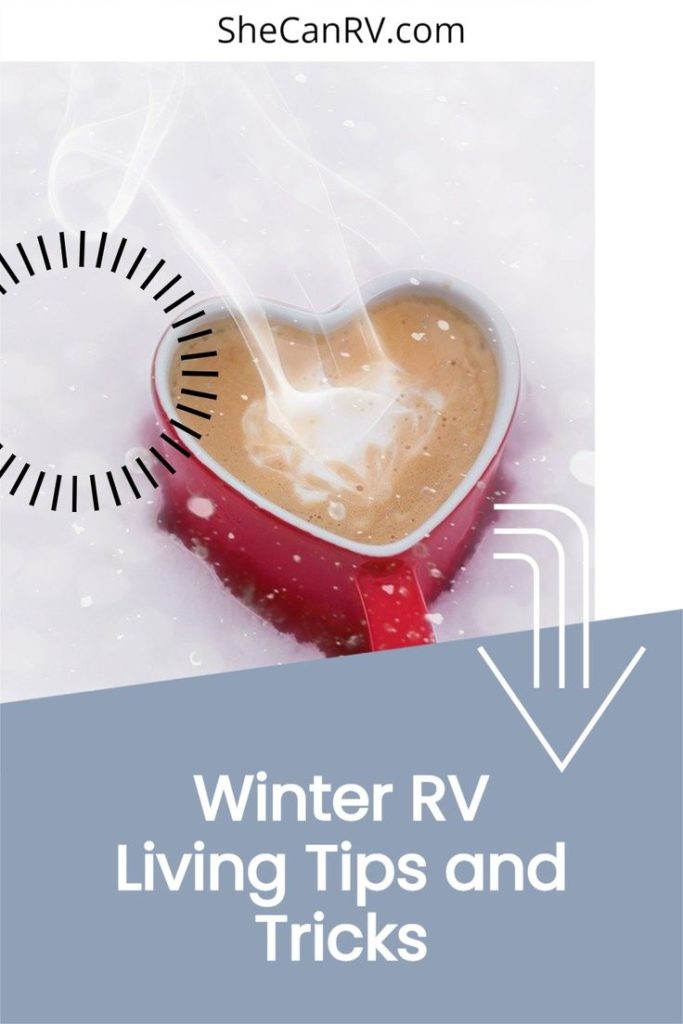
2 thoughts on “Complete Guide to Comfortable Full-Time RV Living in Winter”
This is a great resource. I am implementing several of these suggestions. I have a 28’ RBT with 9 glass windows (no screen). These glass windows produce an incredible amount of condensation. Have you tried to put the clear plastic on the windows with the slide curtains? The two windows above the sink would require tape applied to aluminum finish – not sure I want to do that – but hate to put the reflectix there. Maybe use reflectix at night when the furnace is running the most?
Hi Penny, I did try putting plastic on the inside of the windows and found that moisture collected between the plastic and the window. The best solution I found to keep the windows dry was to place small fans around the Airstream pointing them to the windows. It’s an ongoing battle. The other thing to watch is your storage compartments. Just today I disassembled the platform under my bed and found mold and mildew. I suspect it was from last winter and I had never found it. The musty smell, when I opened those storage compartments, was unmistakable. Perhaps you could keep them open part of the time to keep the air flowing. Best of luck to you. It’s a challenge. I’m in Texas this winter. There is moisture but nothing like days of neverending rain. Juley
Leave a Comment Cancel Reply
Your email address will not be published. Required fields are marked *
Start typing and press enter to search

Full Time RV Living in Winter Guide
- Latest Posts
- RV Modifications for Cats Guide -
- Top Airstream Alternatives Guide -
- Full Time RV Living in Winter Guide -
It wasn’t that long ago when the idea of living year-round in a Recreational Vehicle was outlandish and ridiculous. However, modern RVs and their components have come a long way, and there are more ways than ever to make them feel like home. As such, living in an RV year-round is more common than you might think. However, one of the trickiest parts about full-time RV living is getting through winter.
Living in your RV during a harsh winter is challenging but very possible when you prepare properly. You’ll need to find a way to keep the warm air in and the cold air out, keep your water from freezing , and ensure your furnace is in working order. You’ll also need to ensure that you have a backup power source because winter power outages are common.
Like we said before, surviving winter in an RV is difficult but possible and even enjoyable. Preparation and having a plan are key, and that’s where we come in. By the time you’re finished with our full time RV living in winter guide, you’ll know exactly what to do to ensure you and your family stay safe and warm this winter. Let’s get prepping!
Step-by-Step Guide to Preparing Your RV for Full Time RV Living in Winter
You can safely live in your RV throughout the year as long as you prepare it for winter. If RV winter living interests you, here are the steps you need to follow.
Upgrade Your RVs Insulation
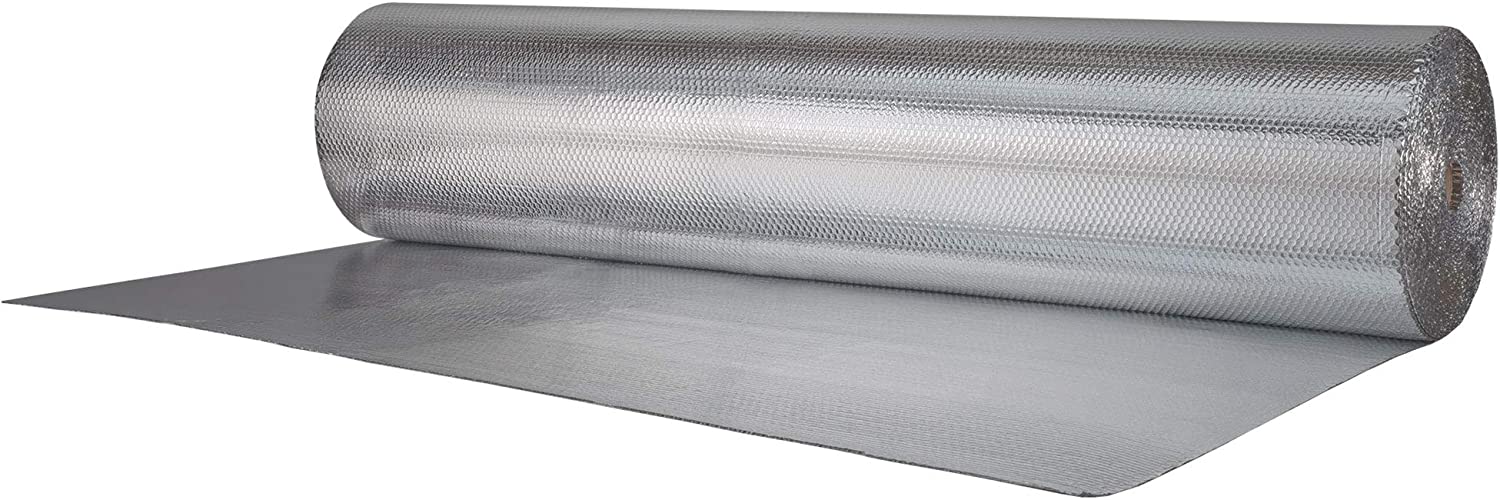
First and foremost with winter living is ensuring your insulation is up to par. Most RVs get built with little insulation to save costs during construction. While this makes your RV slightly cheaper, it also means that it isn’t suitable for winter living.
Upgrading your insulation doesn’t mean tearing the walls and ceilings apart. However, that is an option. Instead, you should focus on the underbelly of your RV. To do this, remove the wrapping or covering on the bottom side of your travel trailer.
Next, add an extra layer of insulation to the bottom of the RV, taking extra time to protect your plumbing pipes. You should also insulate your ductwork, which is usually on the camper’s bottom side. Once you’re satisfied, replace the cover or wrapping that holds the insulation in place under your RV.
Use Carpets and Rugs
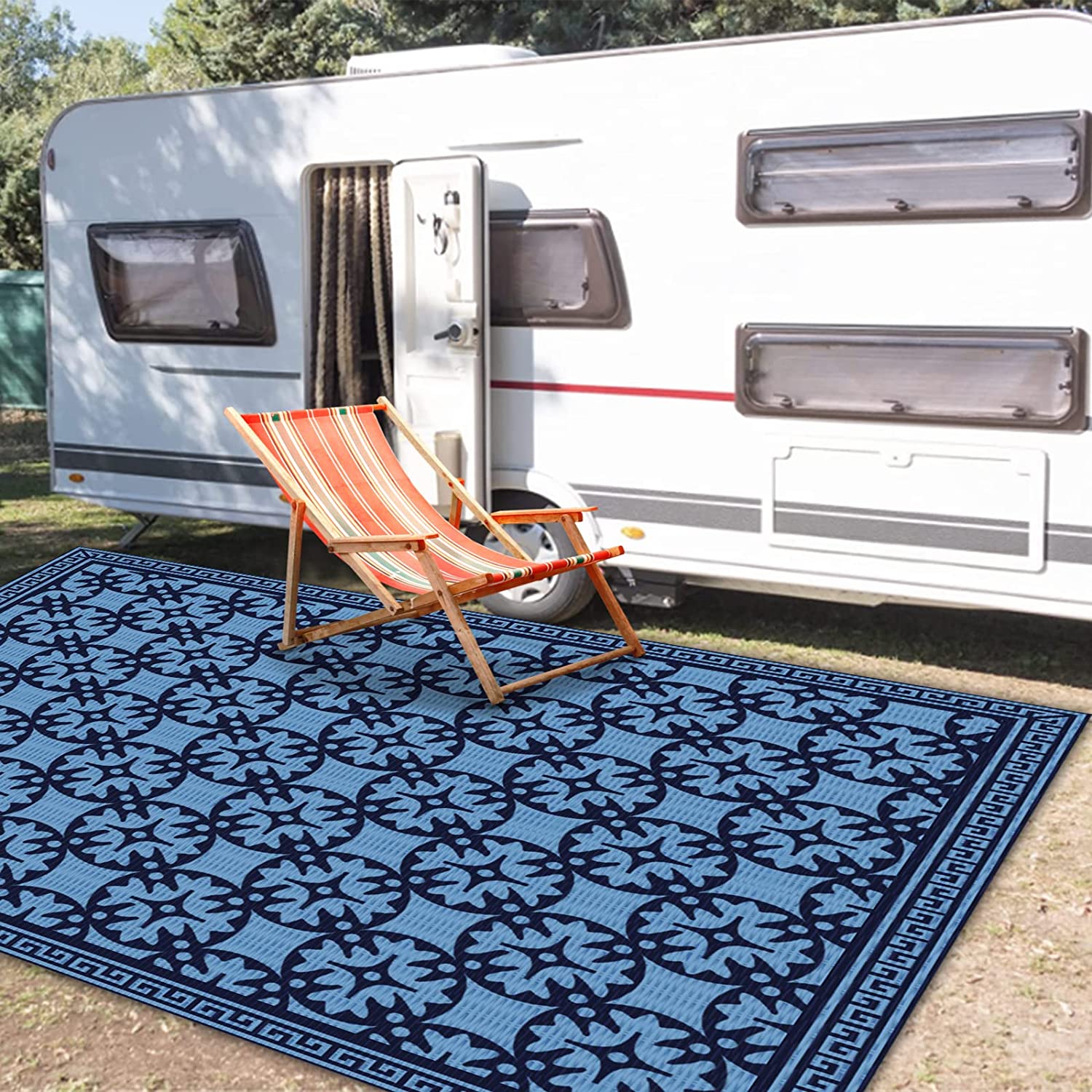
Whether you add insulation to the underside of your RV or not, investing in rugs and carpets is a great idea. No matter how much insulation you add, there’s still a chance that you’ll be stepping on a chilly floor in the mornings. Placing rugs and carpeting around your RV will help negate that early morning chill.
Install Window Coverings
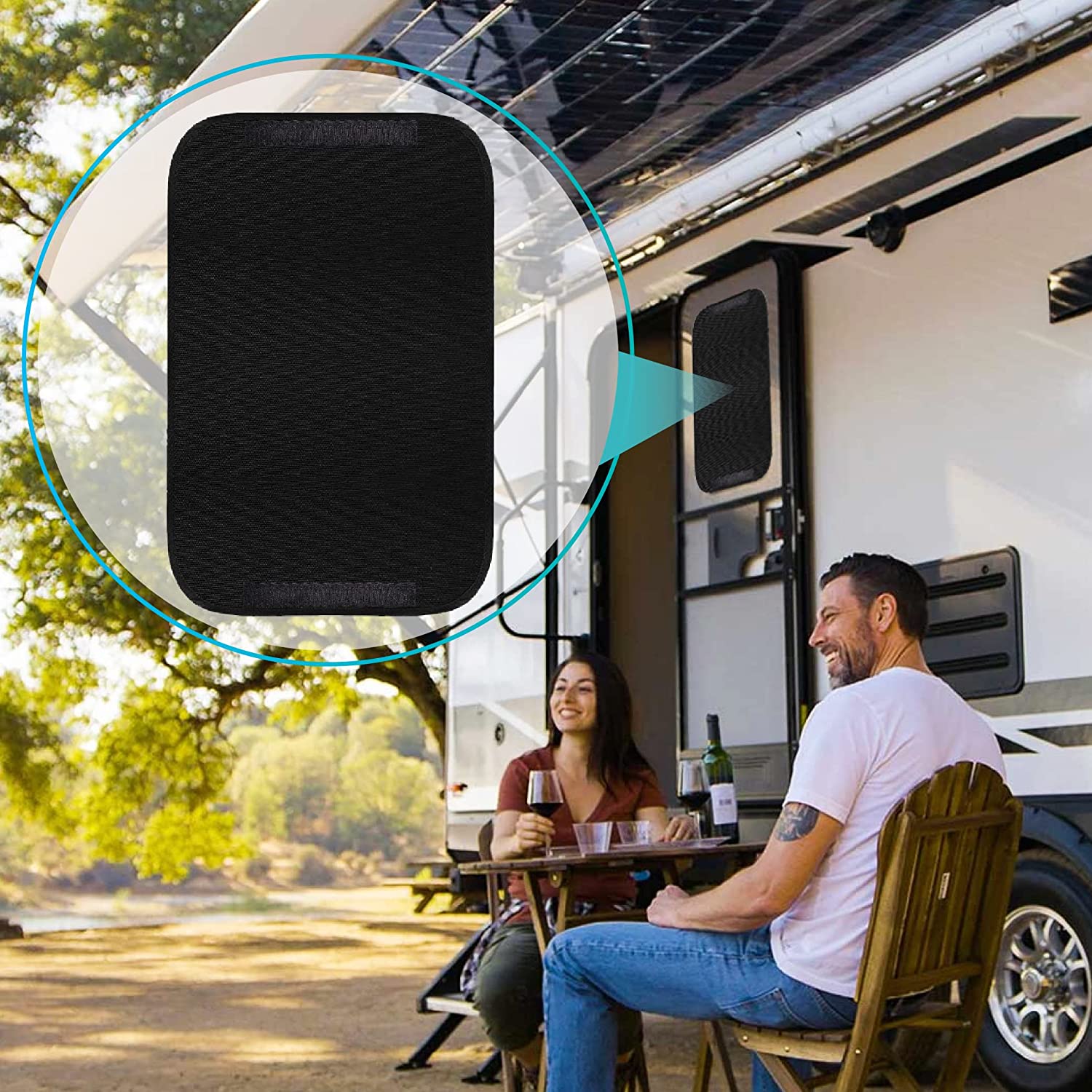
The key to staying warm during the winter is ensuring that warm air stays in and cold air stays out. RV windows are often the biggest culprits that get in the way of this. RV windows are usually single-pane and very thin, so they’re not very good at regulating airflow.
To fix your window problem for RV living, you have two options. You can either replace your single-pane windows with double-paned ones. Or, you can place window covers over your windows to maintain airflow.
The latter option is much cheaper and more manageable and is usually sufficient to keep you warm during the winter. Insulated and reflective window coverings are pretty cheap and do a great job of keeping cold air out of your RV.
Protect Your Plumbing Pipes
One thing’s for sure. You aren’t going to last long in your RV in the winter if you’re plumbing pipes freeze over and you’re living without water. Frozen pipes are one of the most common occurrences regarding RV winter living, and they’re entirely avoidable.
The first thing that will help your plumbing pipes is insulating the bottom side of your RV. As you’re doing that, since you’ll have the underside of the RV exposed, it’s a good time to wrap your plumbing pipes. The most common and affordable way to insulate your plumbing pipes is to wrap them in heat tape. Heat tape is readily available at most hardware and RVing stores and even online.
The other option is to use actual insulation around your plumbing pipes. Most of the lines will measure 1/2″ in circumference, and there will be pipes running to your kitchen sink, bathroom sink, toilet, shower, and outside spigots or showers. It’s also a good idea to leave your cabinet doors open where any plumbing is located so that your RVs heat can get to the pipes inside.
Leaving your cabinet doors open and insulating your pipes and RV underbelly should be enough to keep your lines from freezing and bursting.
Interesting Read : How to Find the Best Full Time RV Mail Services .
Have Your Furnace Serviced and Inspected

You will not last very long if your furnace isn’t ready to go during winter. Your furnace is the only thing standing between you and having freezing temperatures inside your RV. Most, if not all, RV furnaces operate on propane, which means they can run without getting hooked up to electricity.
Here are the basics to check if you want to service your own furnace.
- Check the furnace filter and ensure it’s clean and ready to go. Replace it if necessary.
- Check your heating vents to make sure they aren’t clogged or damaged. You should do this from above and below when the underbelly is exposed for insulating.
- Make sure you don’t have any leaks in your gas line.
- Check your thermostat to ensure that it’s working correctly.
- Examine the heat exchanger on your furnace and the fuses on the motherboard.
- Make sure the blower is working as it should.
While you can service your furnace on your own, having a professional check it out may be best. HVAC professionals will have the tools to make the inspection easy and will also be able to spot problems if they’re present.
Purchase a Generator
One of the best things you can do to prep for winter is to purchase a generator. Generators are especially important if you have an electric furnace or supplementary electric heaters. Power outages are common in the winter, whether because of freezing lines, winter storms, or a car accident knocking down a power pole.
You can opt for either a solar generator or a gas-powered one. Solar generators are great and save money on fuel, but they’re only viable if you can charge them via methods outside the sun. After all, the sun doesn’t shine a whole lot during the winter, which means your generator will be useless.
Gas generators, on the other hand, will always be ready to go if they’re maintained and cared for. Gas generators also tend to have more operating power than solar generators and are more affordable. If you’re only going to buy one accessory for winter living in your RV, it should be a generator.
Invest in a Heated Water Hose
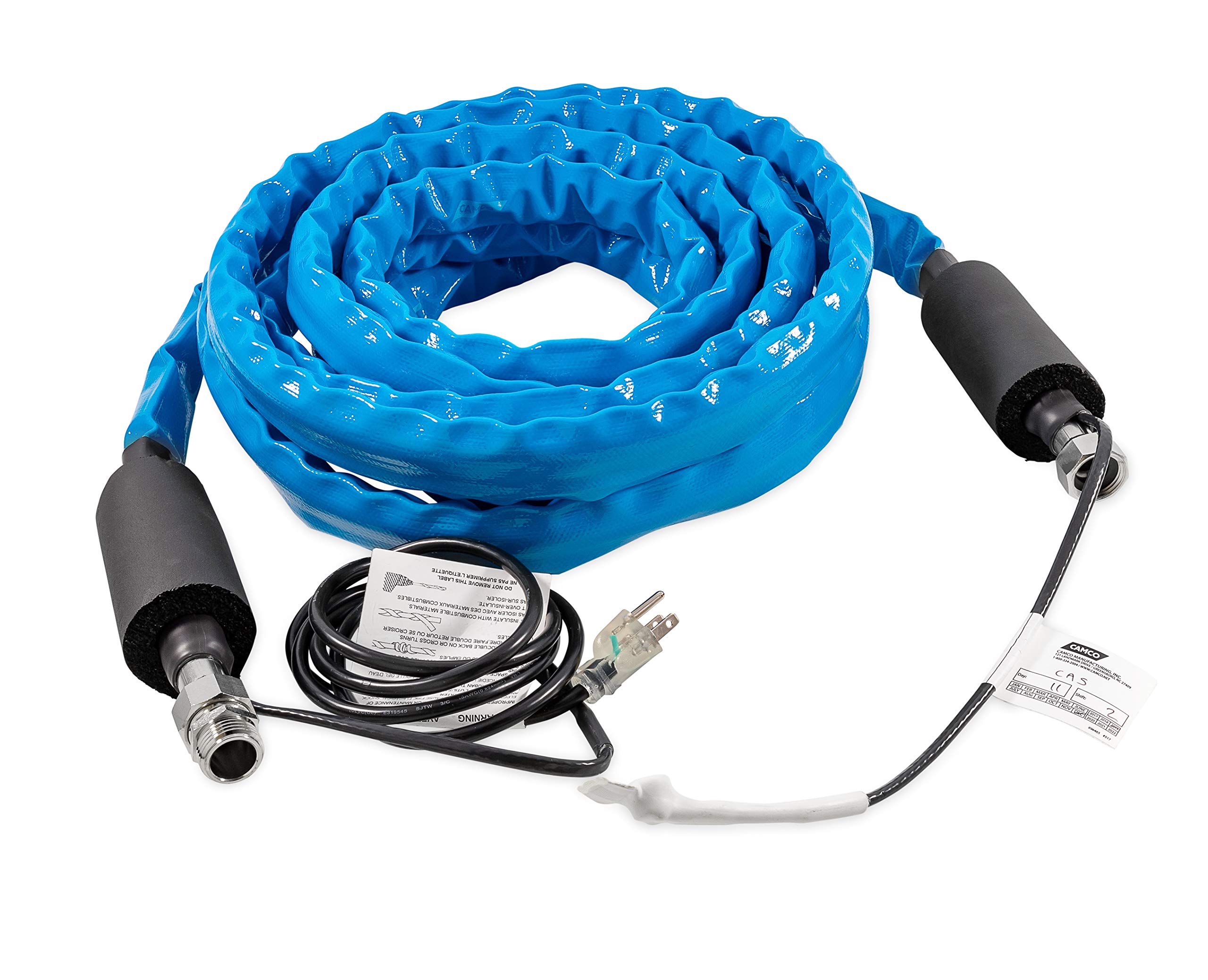
Now that the plumbing inside your RV is taken care of, it’s time to work on the water outside. After all, the water’s not going to do a whole lot of good if your water hose freezes over and it never reaches your RV. One option to navigate your water hose issue is to wrap it in insulation or heat tape. However, if temperatures drop low enough, this won’t be enough to keep your hose from freezing.
Instead, you should invest in a heated water hose. Heated water hoses get hooked up to electricity and have heating coils around them to ensure that the water it’s carrying doesn’t freeze. Water hoses aren’t cheap, but they’re well worth the money and are the best way to keep the water flowing in freezing temperatures.
Have Backup Heating Measures in Place
Even if you service and maintain your RV furnace with religious fervor, there’s still a chance it won’t work. There’s also a chance you’ll run out of propane, and your furnace will be useless. For that reason, investing in a backup source of heat is a good idea.
Electric Heaters
Your first option is to purchase a ventless electric heater. In fact, a ventless electric heater is our only source of heat, and it’s gotten us through some pretty cold nights. Depending on the size of your RV, you should have several heaters and place one in each room.
Space Heaters
The next option for auxiliary heat has a gas-powered space heater. Space heaters produce more heat than electric heaters but also require more maintenance. The main downside of a gas space heater in your RV is that it has to get vented outside because they give off carbon monoxide fumes. To vent your heater, you’ll have to open a window, negating most of the good it’s doing.
Your RV Fireplace
Most newer RVs come with an electric fireplace in the main living area below the TV. While these fireplaces are primarily decorative, they give off a decent amount of heat. They won’t be enough to warm up your entire RV, but they’re an excellent backup to supplement other heaters.

Have Your RV Batteries Checked
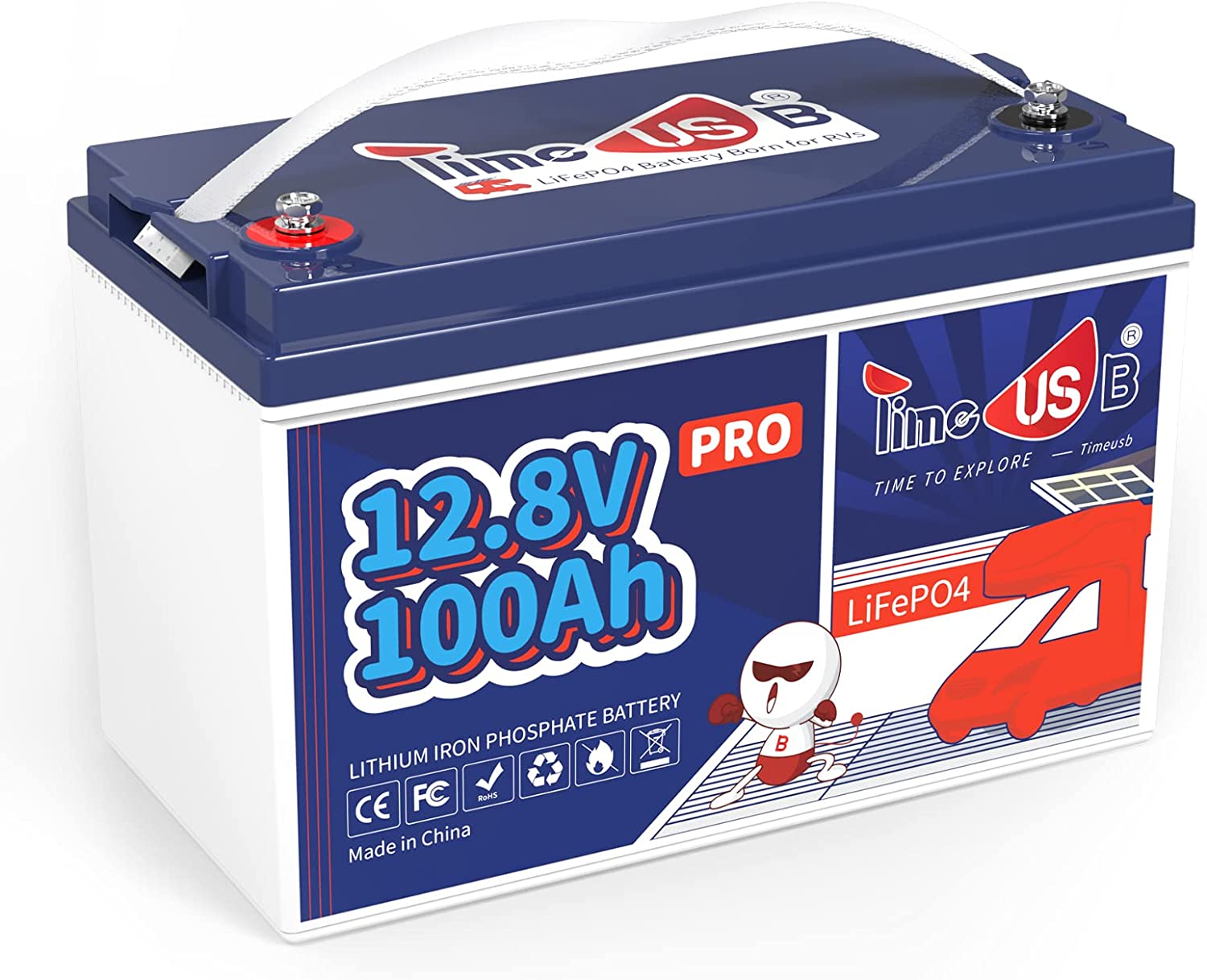
Whether you have a motorhome or travel trailer, you’ll want to get your RV batteries checked. It’s especially important with a motorhome because you’ll need your battery to drive. However, you’ll also want to check the auxiliary batteries on your travel trailer. Your rig is likely equipped with an inverter, which means parts of your camper will operate without electricity.
The lights, slideouts, awning, automated jacks, and certain outlets will work with your inverter. However, they’ll only work if your battery isn’t dead and is in working order.
Purchase Extra Supplies for Emergencies
In addition to insulation, a generator, extra batteries, and auxiliary heaters, here are a few other things to invest in for RV winter living.
Propane Tanks
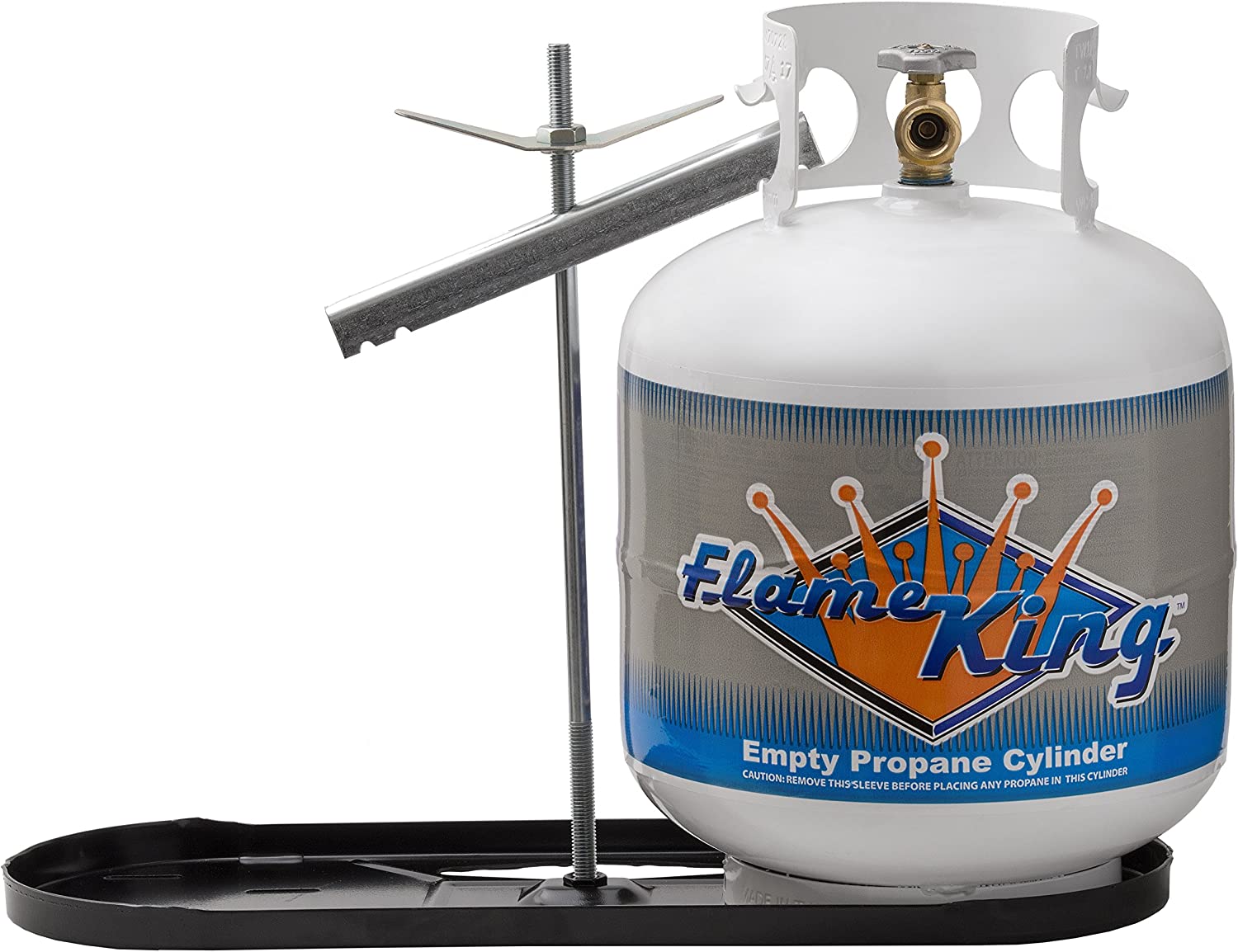
No matter how well you prepare, the propane tanks on your RV can only hold so much propane. As such, it’s only a matter of time before they run out, and you’re left stranded without a furnace. Therefore, you should always have at least one or two extra propane tanks. That way, you’ll have enough propane to last until you can run to town and refill your primary tanks.
Generator Fuel
If you have a gas generator, you should definitely have extra fuel with you. Whether that be gasoline or propane, extra fuel tanks are always necessary.
Food and Water
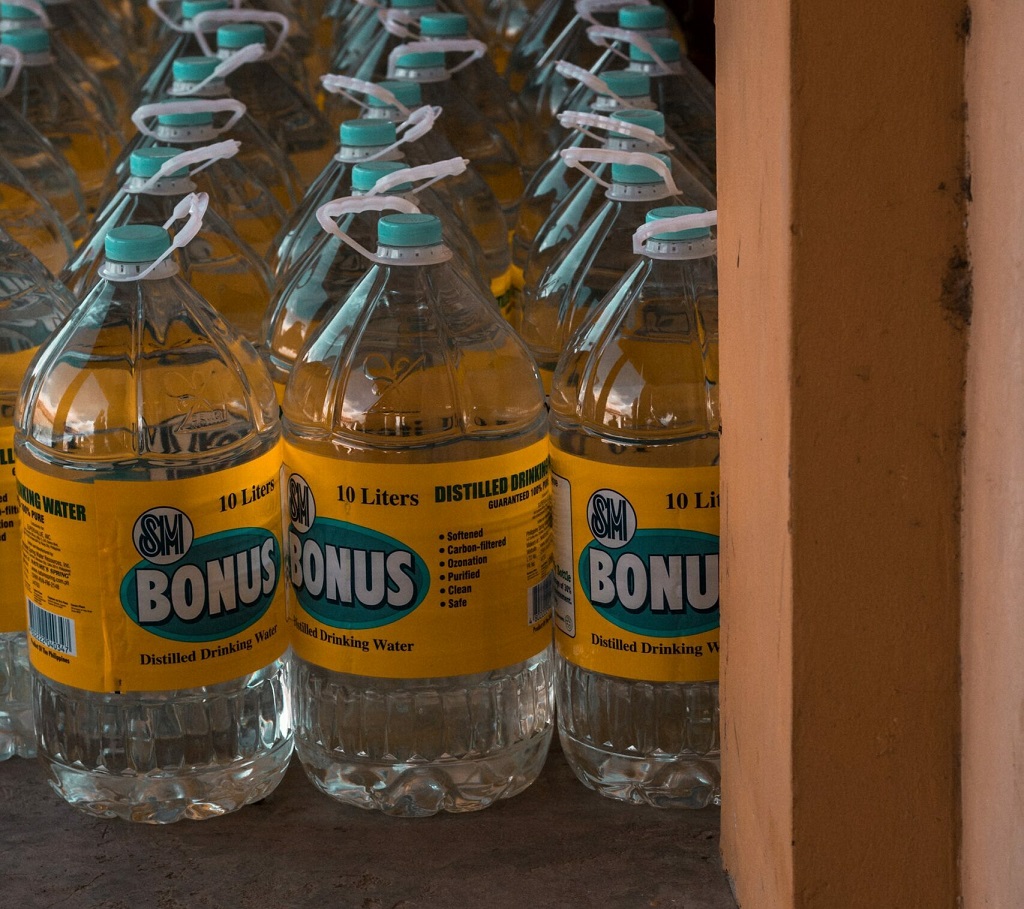
Winter is full of surprises, and you never know what will happen. Therefore, it’s a good idea to stock extra food and water in case you get stranded in a winter storm. Just because you never imagined it could happen to you doesn’t mean it won’t. It’s always better to be safe than sorry.
No matter how well you insulate your RV, cover your floors and windows, and keep the heater on high, you will still get cold at one point or another. To help combat the cold, you should invest in some extra clothing – quality clothing.
Extra coats, pants, socks, hats, gloves, and multiple base layers are a good start. Don’t skimp on quality either, because cheap winter clothing isn’t going to last long or maintain your internal body temperature.
Seal and Cover External Components
Once you’ve got the plumbing and insulation covered, it’s time to move on to making sure your RV is sealed and covered. Here are the steps to go over.
- Cover your rooftop air conditioner with a waterproof, thermal covering.
- Cover your bathroom fan vent and any other fan vents.
- Reseal any caulking around the roof and walls of your RV.
- Reseal around pipes and components protruding through the roof of your RV.
- Essentially, you should inspect and reseal wherever necessary, anywhere that there’s caulk.
Purchase an RV Skirt
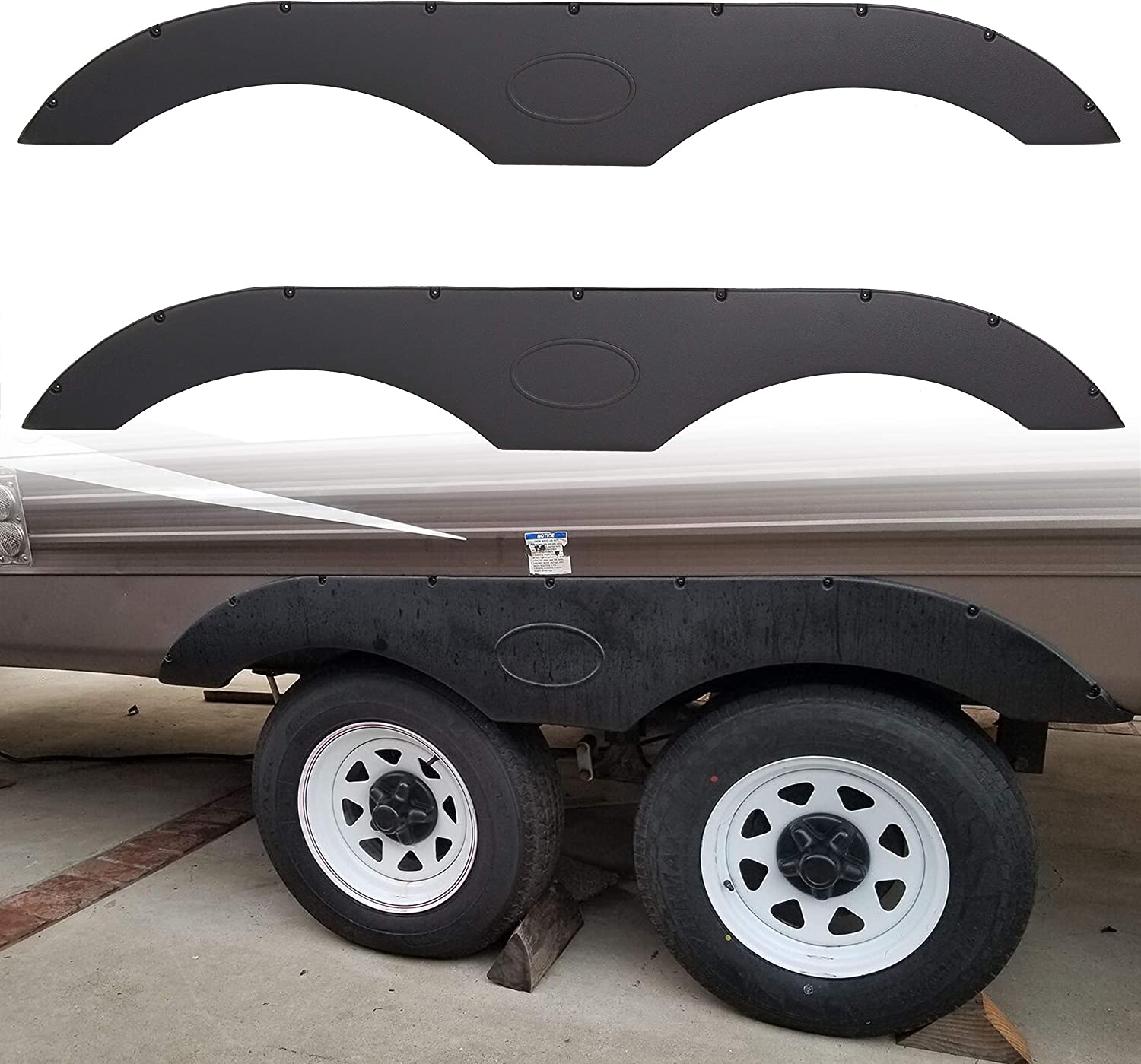
They don’t look the greatest, but investing in an RV skirt is a must if you plan to live in it during winter. A winter skirt will help keep the wind and cold from betting underneath your RV. It will also help keep critters and vermin outside. Small pests such as mice and rats are drawn to heat, so they’ll try to eat their way through your RVs underbelly covering and get to the insulation inside.
If you have an RV skirt, however, there’s a good chance they won’t be able to access it in the first place.
Check the Specs of Your RV
Depending on your RVs year and model, there’s a chance that it’s equipped with a winter package or four-season kit. RVs built this way have extra insulation and are better prepared for winter living. While you can live in an RV during the winter, that doesn’t include this package, it’s a benefit. It’s also something you should look for when purchasing an RV if you plan to try RV winter living.
Traveling in an RV During Winter
Most people who do the RV winter life like to stay in one place for the entire season. However, whether you want to go on a road trip or can only stay at a single location for a limited time, it might be necessary to move around during winter. If you fall into that boat, here’s what you need to do.
Check and Recheck Your Tires
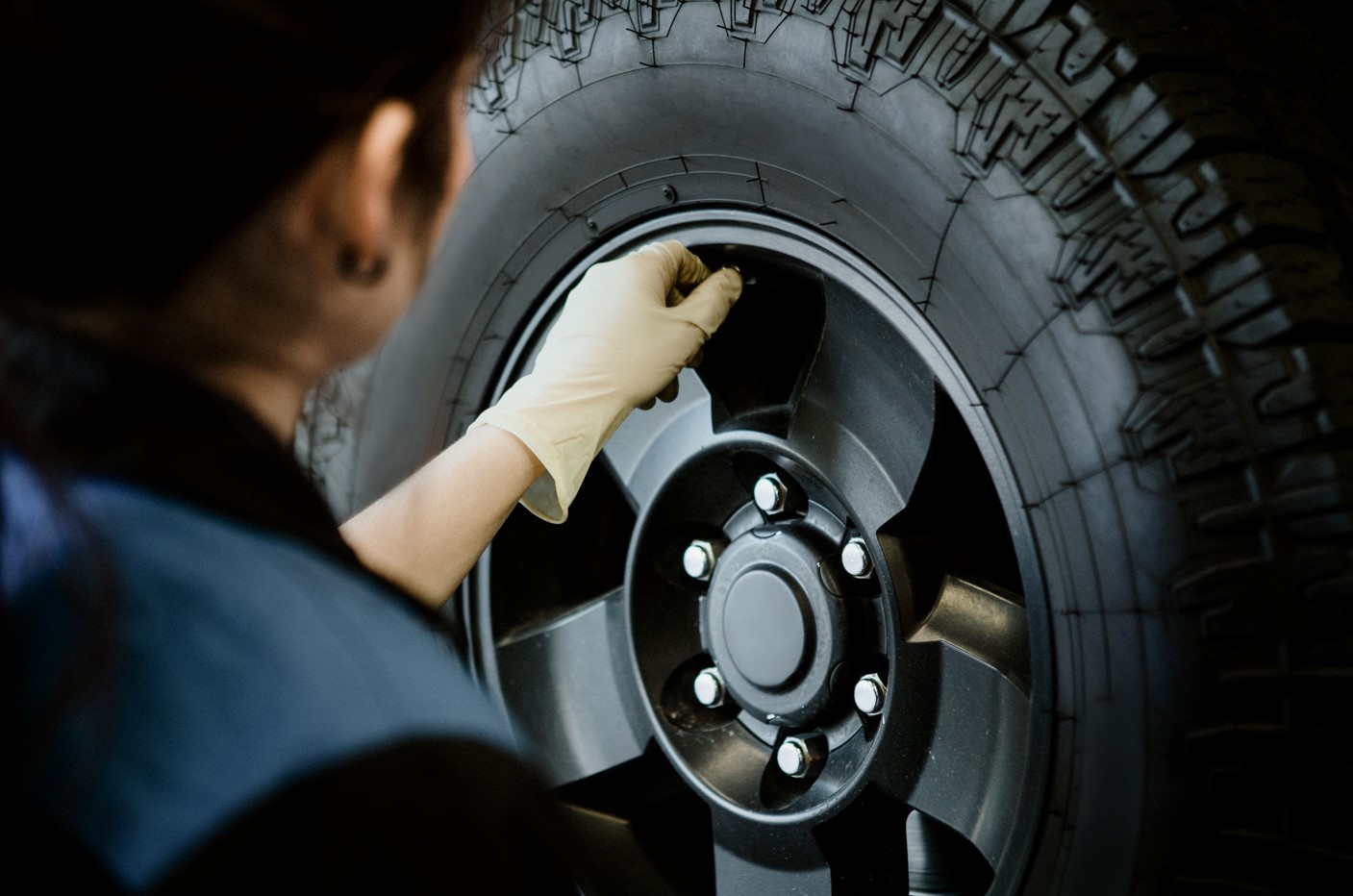
Your biggest enemy while traveling in winter is going to be your tires. Without good tires, you’re liable to run off the road or struggle to maintain control because of swerving. Therefore, you should check your tires before embarking on a journey. You should also make an investment in new winter tires with deep treads. Flat or bald tires are a major safety hazard in icy or snowy conditions, so avoid them at all costs.
Have the Engine Serviced
Whether it’s the engine of your towing vehicle or your RV, it’s important to have it in good working order. You should change your engine oil every three months or 5,000 miles. You should also have an in-depth engine inspection from a professional mechanic every six months to a year.
Drive Safe!
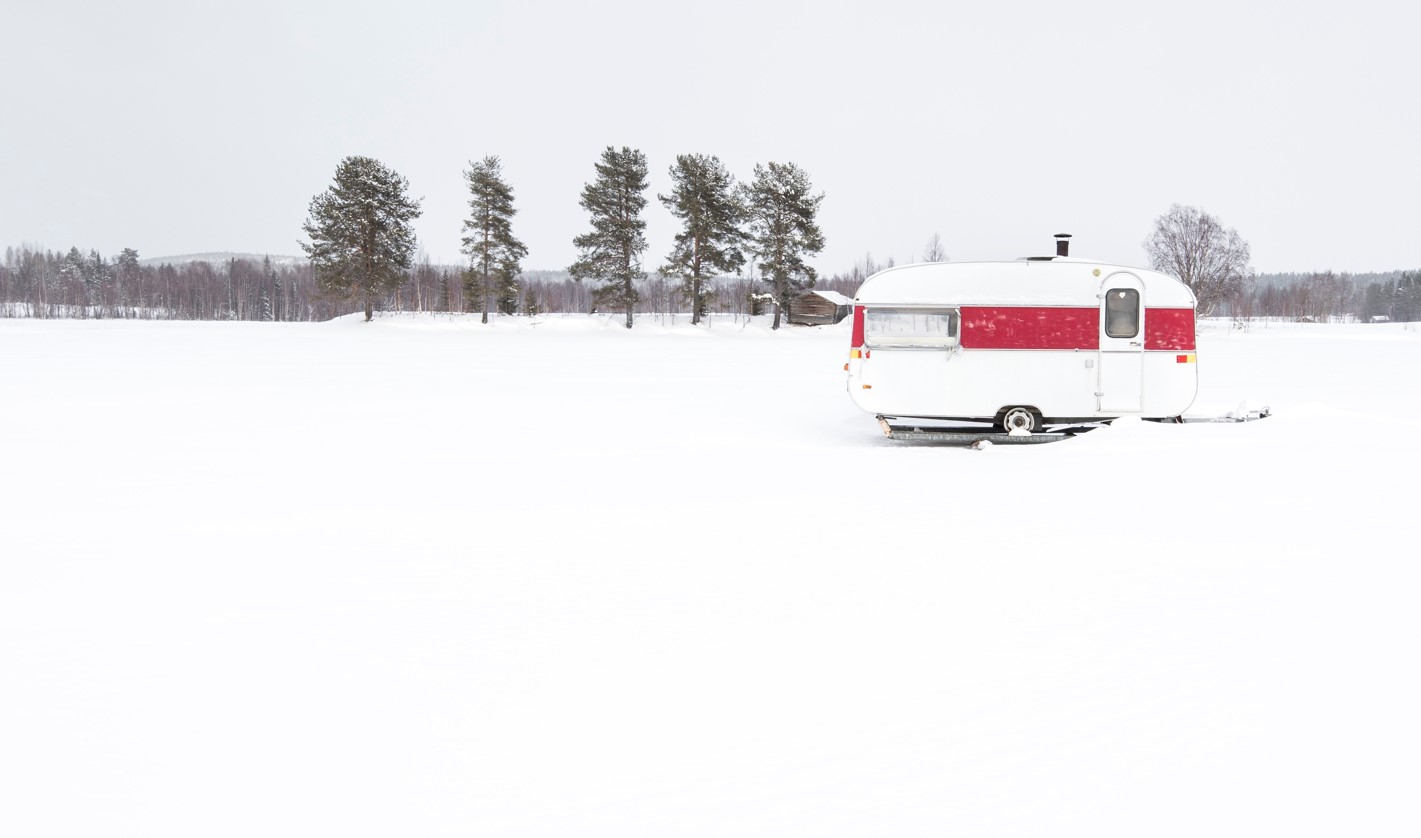
It might go without saying, but driving slow when you’re towing an RV is important – especially when the roads are bad. Never go faster than you’re comfortable with, and stay off your phone!
Be Patient With Each New Setup
The main reason that people don’t like to travel much during winter if they’re living in their RV is because of the takedown and setup. Every time you move to a new location, you must redo the RV skirting, recheck the tires, disconnect and reconnect your water lines and sewer hose, and go through everything with the RV jacks and slideouts.
While this isn’t a huge deal from spring to fall, it can be a real pain during winter, especially if insulated components are involved. There’s also a chance that your RV jacks or the gears that operate the slideouts will freeze up. In short, a typical 30-minute job can easily turn into a 3-hour one. For that reason, most people like to set up somewhere and stay put.
Frequently Asked Questions
Question: What to do if my plumbing pipes burst?
Answer: If, heaven forbid, your plumbing pipes burst, here’s what you need to do.
- Go outside and turn off the water spigot that your water hose is connected to.
- Disconnect your outside water hose and drain it so it, too, doesn’t freeze.
- Use blankets, towels, and anything else you have handy to mop up excess water.
- Contact an emergency plumber so they can repair or replace the damaged pipe.
- Don’t reconnect the water again until you wrap your plumbing pipes in insulation or take measures to insulate the bottom of the RV. The odds are that if it happened once, it will happen again if you don’t do anything differently.
Question: Are there extra tools to pack for winter living?
Answer: Here are a few extra tools to take with you on your winter travels.
- Snow Shovel
- Chains in case you go in a ditch
- A windshield scraper for ice and snow
- Roadside flares in case of emergency
- Extra food and water in your towing vehicle
- An electric blanket
Question: Will my RV holding tanks freeze?
Answer: If you have enough insulation in the bottom of your RV, there’s a good chance that your tanks won’t freeze. However, if they do freeze, you’ll have an expensive repair on your hands and a big problem. You won’t be able to drain your tanks until they unthaw, and there’s a good chance that your tanks will burst or suffer damage.
Final Thoughts
If you think living in an RV in moderate temperatures is an adventure, you’re in for a real treat when winter comes. While living in an RV during winter can be difficult and inconvenient, it’s actually a good time if you prepare properly. The best way to do that is by adhering to our full-time RV living in winter guide. If you follow our advice to a T, you and your family will surely enjoy your winter adventures.
Leave a Comment Cancel Reply
Your email address will not be published. Required fields are marked *
This site uses Akismet to reduce spam. Learn how your comment data is processed .
Prepping to Live Full-Time in an RV over the Winter

TL;DR: Essential tips for RV living in winter include keeping your RV stationary, protecting exposed parts, ensuring water safety, using indoor heat sources, driving safely, using electricity when possible, and planning ahead.
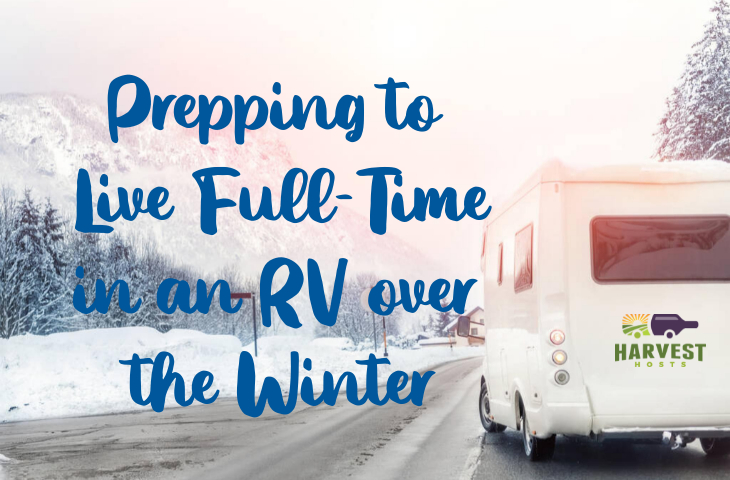
One of the most amazing parts of RV Living its overall flexibility. Some RVers are weekend warriors, while some travel for long trips, and others live in their RVs full time. Most RVers prefer to travel with the seasons, sticking to mild temperatures to ensure they don’t encounter extreme weather, especially considering that RVing in the winter is no easy feat. Most RVs are not well-insulated, and water pipes can freeze and cause damage once the temperatures drop too low. However, whether you choose to RV in a cold climate or get stranded at some point, it’s important to know how to prepare yourself and your RV. Get cozy as Harvest Hosts covers all the ways to prepare your RV for a deep freeze. Be sure you:
- Keep Your RV Stationary
- Protect Exposed RV Parts
- Keep Your Water Supply Safe
- Get a Proper Indoor Heat Source
- Follow Safe Driving Practices for the Winter
- Plug in to Electric When Possible
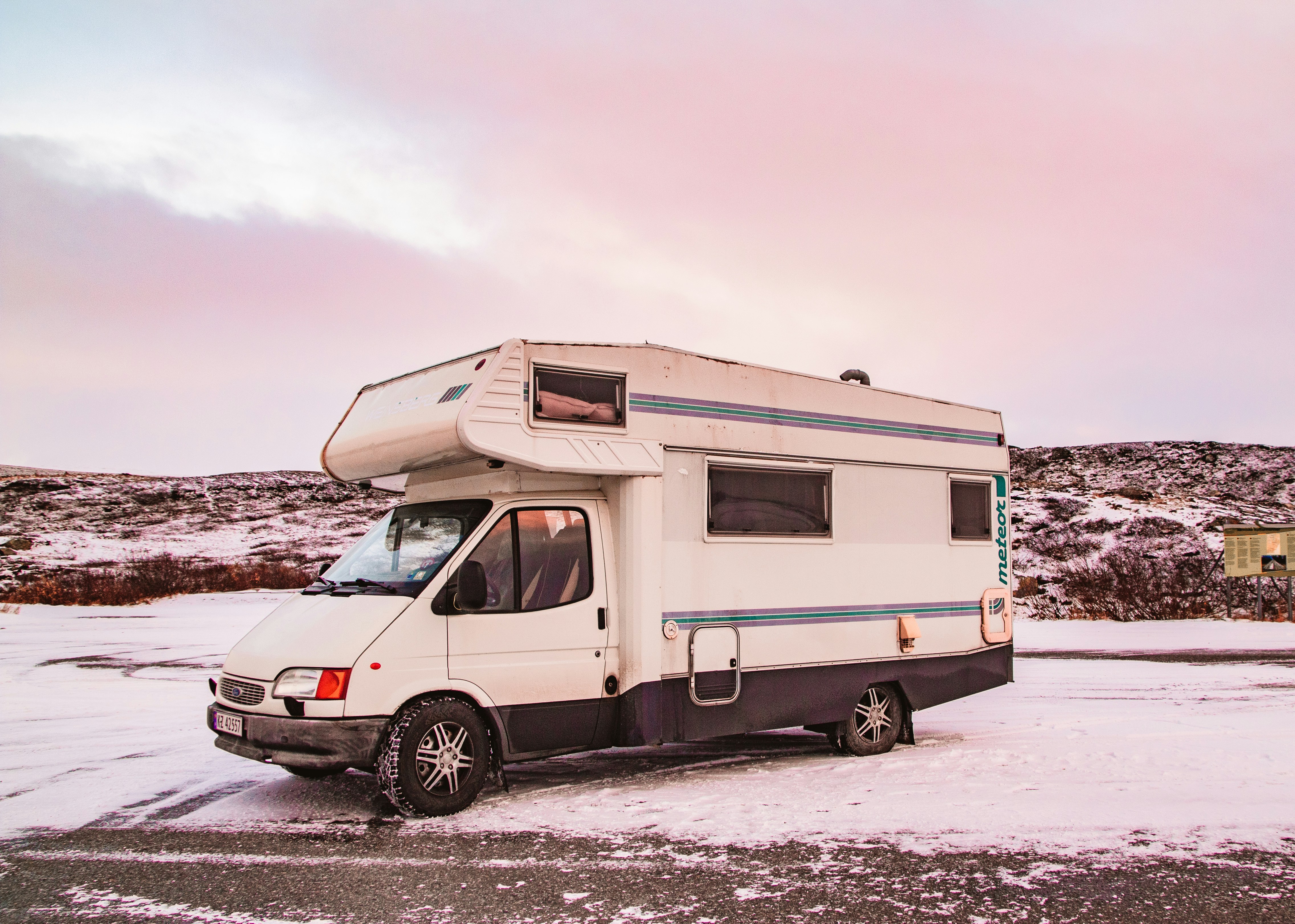
Keeping your RV stationary during a hard freeze is a different experience than actively traveling during one. While stationary, you will most likely have access to hookups and will have significantly more ways to prepare your RV. Planning ahead for freezing temperatures in your stationary RV is non-negotiable!
Protecting Exposed Parts
RVs are built to be as compact as possible. This can mean that many parts are located outside, in storage bays, or under the RV. Regardless, these areas need to be protected from the elements in the event of a hard freeze. A best practice is to utilize several of these methods in conjunction with one another for best results.
If you’ve ever seen long-term residents at an RV park or campground, you’ve most likely seen an RV skirt. These wrap around the base of your RV to keep snow out, protect the bottom of the RV, and help raise the temperature. Skirts can be made of foam and other hardy materials to help insulate your RV. A heater or two can also be used under your RVs skirting. Please be sure that any heaters placed under the skirting are suitable for use outdoors so that there’s no risk of any electrical shorting.
Heat tape for Pipes
Heat taping your pipes will take some time, but will be well-worth it. To accomplish this, you must locate all the water pipes outside of your RV and wrap them in heat tape. Be sure to follow the directions so that your tape can be plugged in safely.
Add Antifreeze
It would be no fun to live in a winterized RV. For those that don’t know, one part of winterizing your RV is adding antifreeze to all of the inner pipes, including the grey, black, and water tanks. However, actively using your RV in the winter can be more comfortable with adding antifreeze to the grey and black tanks only. This will prevent any wastewater from freezing and bursting any pipes. It’s important to note that an RV should not stay hooked up to a sewer connection during freezing temperatures. Stay disconnected and dump whenever necessary.
Running water is one element of RVs that make them feel most like a home. However, keeping the water flowing in your RV all winter long doesn’t need to be a challenge with some careful planning.
Heated Hose
The first investment here will be a heated hose. They can either be purchased, like this Camco brand hose , or DIY-ed using heat cable and insulated foam.
The best practice for winter RVing is to fill your water tanks using your heated hose and then pack up the hose. It can be too risky for the spigot to stay connected at all times, and parts of it can still freeze, even when using a heated hose. If you plan on using your freshwater tanks during the winter, be sure to utilize tank heaters (they work and look similar to heating pads) and you may even wish to use a little space heater if your water pump is in the same area outside.
Heating the Inside
You would think that heating the inside of your RV would be a no-brainer. After all, heating your home is usually pretty easy, right? However, most RVers know that RVing isn’t always that simple.
Furnace vs Heat Pump
Most RVs are equipped with two types of heat: furnace (propane) and heat pump (HVAC). While it may sound expensive, using the furnace is better for your RV in the frigid cold. The HVAC is not meant to heat the RV during extreme temperatures and can even break when trying to do so. Thankfully, most heat pumps will automatically ask the furnace for help if the job feels too big.
Keep Propane on Hand
As we stated above, propane should be the primary source of on-board heat used in the cold, and it’s essential to keep the onboard propane tank full. For a larger RV, this involves having a truck come to you and fill your tank, or using the Camco Extended Stay Attachment . Having your propane refilled on-site is often expensive due to the convenience. The Camco Extended Stay attachment allows for a small twenty-pound tank to be hooked up to your RV’s propane regulator and bypass the on-board tank. The twenty-pound tanks can then be taken to be refilled at a propane fill facility. Smaller RVs are usually equipped with a twenty-pound tank that can be removed and swapped out.
Electric Heaters
In addition to using the on-board propane heat, small space heaters can also be used to help keep your RV warm. There are numerous types of heaters on the market, ranging from ceramic to fan, infrared, oil, propane, and more. Be sure to do your research to figure out what type of heater will work best for your space and power consumption. Keep in mind that you should never bring a propane tank inside to use with a propane heater.
Insulate the Windows
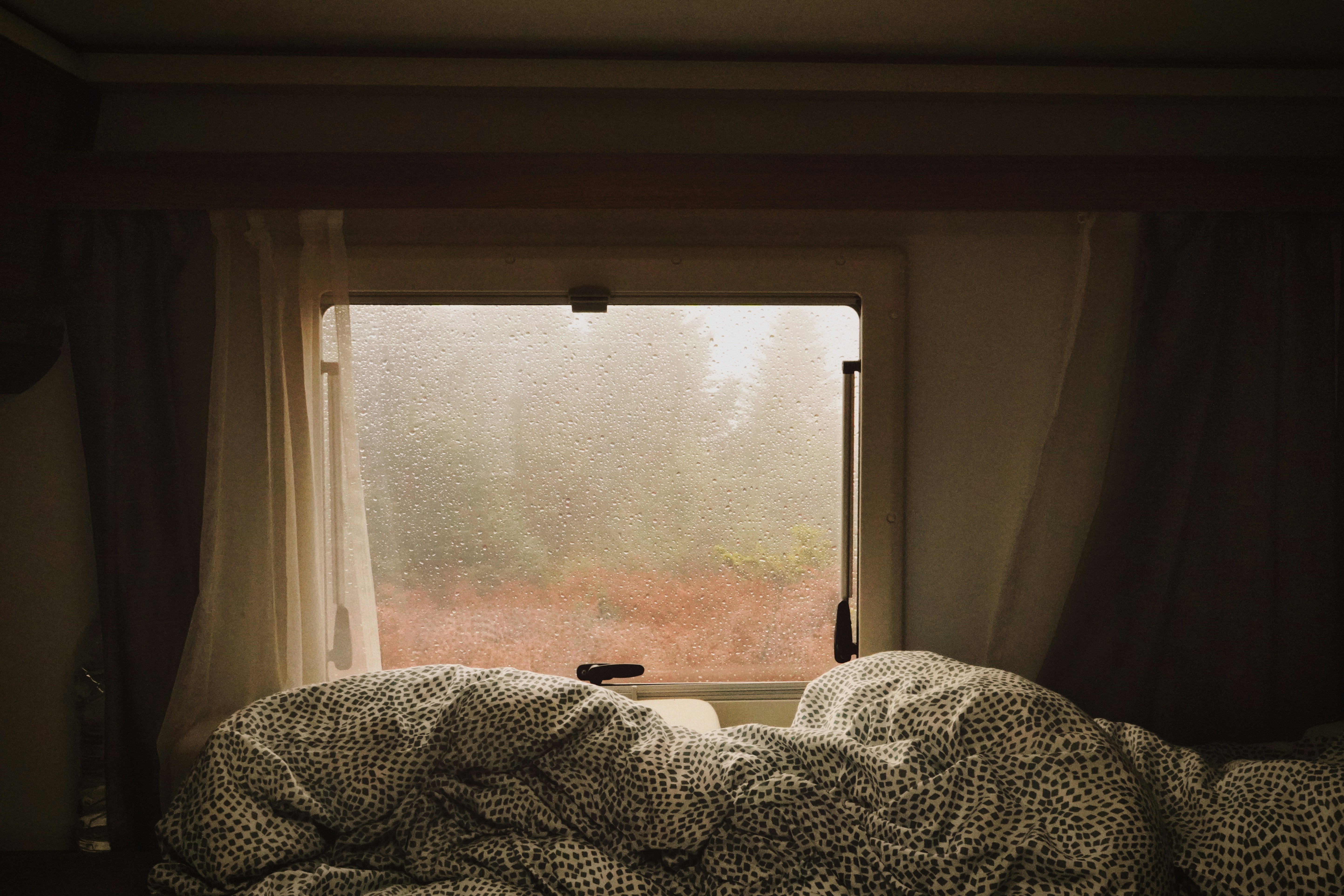
Thermal Curtains
Thermal curtains are a great DIY project that can keep your RV warm without losing any decor points. These heavy-duty curtains are designed to keep the heat in while still allowing you access to open your window if desired.
Dehumidifier
With all of this heat pumping in your RV, it’s imperative to keep your RV dry. Interior moisture and RVs don’t mix well at all. In the winter months, it can be easy to accidentally grow mold due to moisture build-up. Depending on the size of your RV, one or two dehumidifiers will be absolutely essential.
These tips and tricks are absolutely essential when preparing for a frozen winter. Be sure to plan ahead, and be prepared before it gets too cold!
Winter Travel
Traveling during an unplanned snowstorm or experiencing a hard freeze on the road can be a struggle. Most traveling RVers rely on quick overnight stops that may not have hookups, which can greatly impact your options.
Safety First
The first step to traveling in the winter is to ensure that you have first taken the proper safety precautions. Harvest Hosts has already covered how to drive safely in winter weather , but we’ve recapped a few points below.
Be sure that your RV tires have proper tread and that they are not outdated. Smaller RV tires tend to wear similarly to passenger vehicle tires in that the tread will be visibly worn. A larger motorhome’s tires can still have plenty of tread, but be outdated. Worn or outdated tires both pose serious safety risks while driving. Tire chains may be necessary in some areas for safety.
Safe Driving
Always use your best judgement and err on the side of caution when driving through winter weather. Go slow and pull off if you need to. Keep in mind that bridges freeze before roads, and always be vigilant for black ice.
Plug in Whenever Possible
In order to stay warm and comfortable, try to plug into electric whenever possible. This may mean stopping at a campground for the night or paying extra at certain Harvest Hosts locations that offer an electrical hookup. Even just a 30-amp hookup can make a big difference in your RV.
No matter how you RV, solar is always a good investment. This can provide power to your rig for a short overnight stay or even when you pull off the road to have lunch. However, unless you have powerful panels and beefy batteries, you probably can’t run a heater off of solar power. Still, solar can be extremely helpful, especially in emergency situations.
Helpful Products
There are a few products that can really help out RVers traveling through a snowstorm or in an area with winter weather. These aren’t necessary, but can make a huge difference.
Mr. Buddy Heater
This portable heater runs off of small propane canisters and doesn’t require any power to run. These invaluable heaters are well-known in the camping and RV community and are very safe for what they are. You will need to ensure you have proper ventilation when using these even though they have built-in safety mechanisms surrounding oxygen depletion. Be sure to read all of the instructions before use.
As we stated above, skirting your RV is a must in the winter. With the launch of the Air Skirt in 2020, the game has changed. These are portable, easy to set up skirts that inflate to fit snugly under your RV. They are weather proof and help regulate the temperature underneath your RV. They set up in about thirty minutes and store flat. Even RVers that are stationary during the winter may want to check out this product, since it doesn’t require any holes drilled into your RV’s body.
Plan Ahead When Possible
Of course this goes without saying, but plan ahead. Check the weather forecast on your journey to avoid snowstorms or hard freezes whenever possible. Be sure to carry your emergency supply kit and have extras of water and non-perishable food. Always have a backup plan as well!
RV Living in the winter can be scary, but it doesn’t have to be. With some careful planning and consideration, you can ride out the cold temperatures and keep your RV working smoothly.

10 Tips for Living in a Camper in the Winter & Living to Tell the Tale
Living in a camper in the winter isn’t for the faint-hearted.
Winter camping trips or full-time cold weather RVing doesn’t need to be uncomfortable or something only Ralph Fiennes would consider.
We’ve just come out of a Patagonian winter, and as we defrosted, we reflected on the whole experience.
Cold weather RVing is not only possible; it’s rewarding and, with the right kit and preparation, completely comfortable too.
In this post, we’ll walk you through our top tips for living in a camper in the winter, from insulation tips to keeping warm and dry.
Tips for Living in a Camper in the Winter
Living in a camper in the winter months isn't just possible, but it's exciting, adventurous, and you can even live to tell the tale!
Here are our top tips for winter RV living.
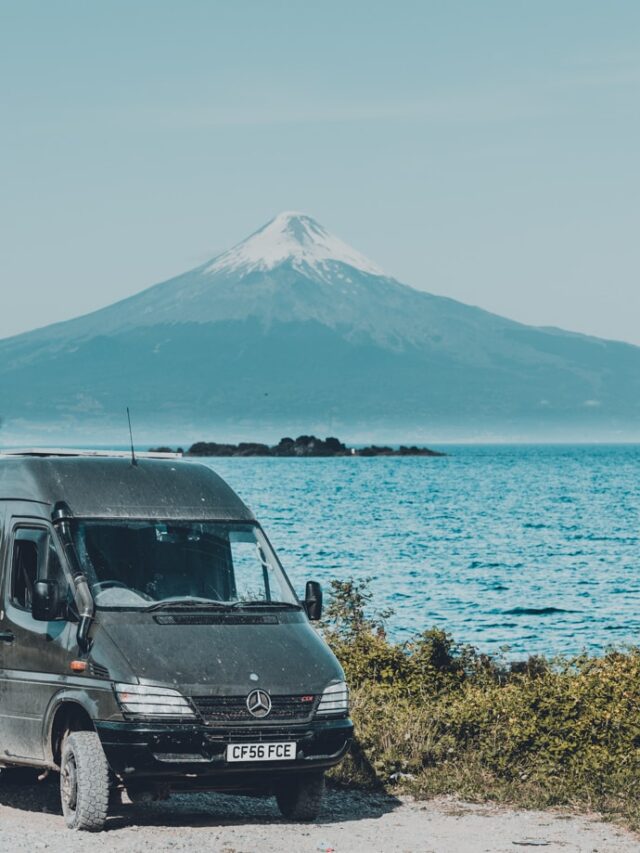
Buy a Small Camper or RV
If you’re buying a campervan and intend to live in it full-time or camp out often during the colder months, consider sacrificing some space.
A smaller camper is easier to keep warm than a large RV.
All the wide-open space, high roof, and big windows of a large campervan or motorhome is precisely the opposite of what you need for comfort in minimal heating conditions.
The air you warm ends up on the ceiling, not down on the floor with you.
There's more air to heat, and the RV windows allow much more heat loss than well-insulated van walls.
Conversely, a small space heats up much more quickly.
If you can’t sacrifice space, consider dividing the van into smaller areas to reduce the amount of space you need to heat.
A well-placed heavy curtain across the bedroom is a great way to reduce the area to heat.
If you're in the market for a pre-loved RV, we’ve detailed everything you should ask and inspect when buying a campervan.
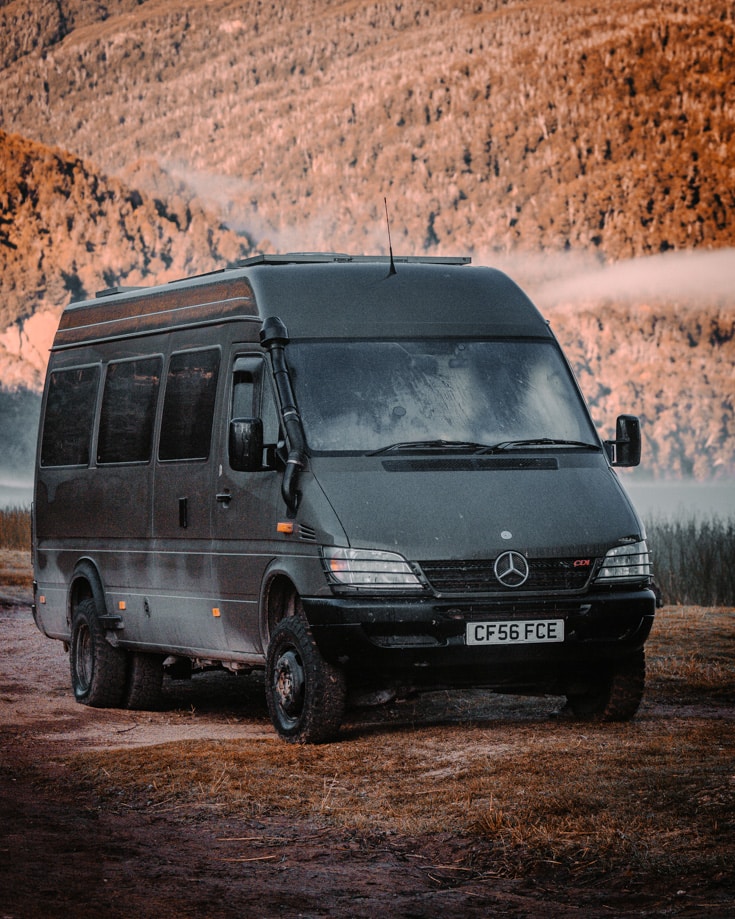
Insulation! Insulation! Insulation!
Insulation is the number one tip for improving your comfort levels of living in a camper in the winter.
If you're doing a DIY campervan conversion , considering the walls' insulation, floor, and ceiling early in the build stage is vital.
Look for the best thermal performance on winter living insulation materials to reduce as much heat loss as possible.
Even if your campervan conversion is already complete, there’s plenty you can do to improve the insulation for winter living.
Attach RV skirting to insulate the underbelly and foam pipe insulation for extra protection for water pipes.
Add thick rugs to the floor as they help trap heat inside and make it much more cosy than stepping onto a cold wooden floor in the mornings.
Windows are a significant source of heat loss too. Use thermal curtains and extra foam boards or Reflectix covers at night.
When the sun is up, keep the window coverings off. It's incredible how much the glass helps warm the inside of the van, even with just the winter sun.
And following on from tip #1, try to reduce the amount of space you need to heat.
We keep our thermal curtains closed between the driving cab and living area throughout the winter months, which is a massive help.
Don't forget the backs of your cupboards, too, where they meet the van's exterior walls.
Reflectix is a reasonably thin material, so it doesn't take up much space and adds another insulation layer.

Stop Condensation in your RV
Condensation will lead to poor health and rot your home on wheels if left unchecked.
Literally.
And it’s horrible to wake up to water running down the inside of your campervan windows, walls, and every other cold surface inside.
While it may seem counterintuitive in the cold weather, excellent ventilation not only prevents condensation but also helps keep your camper more comfortable too.
The best RV ventilation is to install one or two electric roof vents. They have a low draw on the batteries and ensure constant airflow.
This replaces stale, humid air with clean, dry air, keeping the van fresh inside.
Minimising water vapour inside the van is another crucial aspect of stopping condensation.
Cooking, showering, and even some forms of heating can all add to the problem.
Follow a few good practices to help reduce how much water vapour is produced inside during the winter so you can manage the condensation with adequate ventilation and heating.

Use a pressure cooker indoors
Cooking inside a campervan will inevitably create water vapour.
While this may feel like it’s warming the van up, don’t be fooled.
It's a short-term gain, and the resulting condensation will be the long-term price you pay if left unmanaged.
Ventilation is key to getting rid of the water vapour. So if you boil the kettle for your morning coffee inside, make sure to open your doors or windows.
If steam is condensing anywhere, you don’t have enough ventilation.
But cooking inside with the doors open isn't always pleasant, especially when living in your camper in winter.
This is where the pressure cooker comes into its own.
Cooking in a pressure cooker is a fantastic way to create quick one-pot meals and cut down on fuel. If used correctly, they produce a fraction of the water vapour of other cooking methods.
If using a stovetop pressure cooker instead of an electric one, make sure to turn the heat down when the pot comes up to full pressure.
Also, allow the pressure to release naturally, or you’ll let all the steam escape anyway.
Make sure your campervan kitchen essentials include a pressure cooker - right at the top of the list!
If you have a vented oven in your van, this is another excellent source of heat!
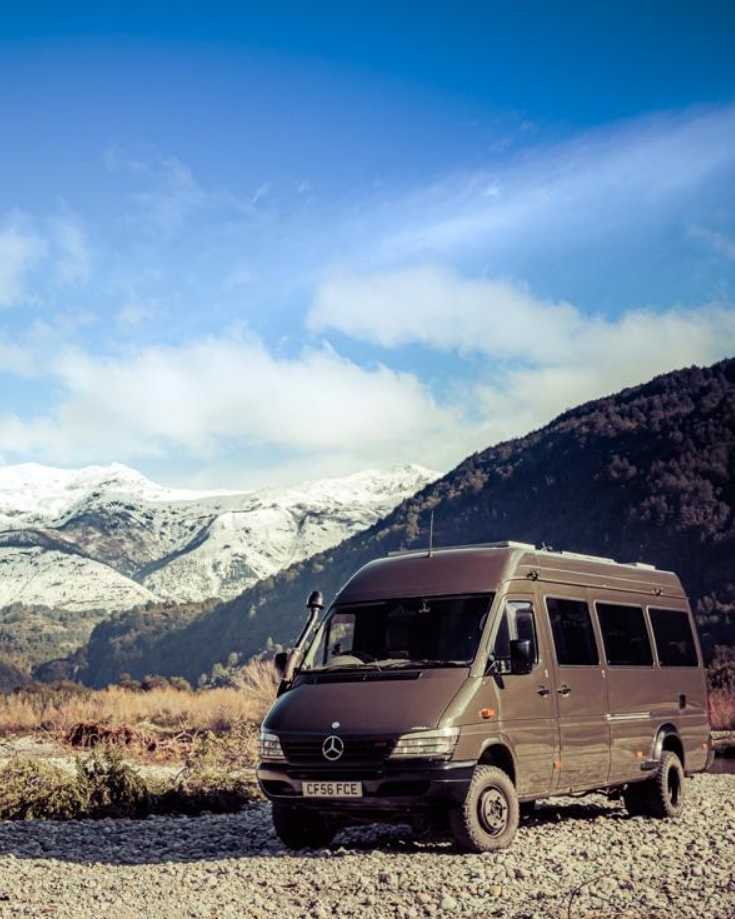
Keep the Camper Warm - All the Time
This is especially true for well-insulated RVs and campervans.
Heating the living space inside your camper takes a fair amount of energy and fuel, depending on what heating system you use.
But once at a set temperature, and IF you don’t suffer from a lot of heat loss through poor insulation, keeping it warm is relatively cost-effective.
Without excellent insulation, it's more cost-effective to heat the camper as and when you need it because it's quickly lost through the walls, floor, and roof.
There are many fuel types of heating for campervans, including propane, diesel , electric, and wood.
When choosing what type of heating you want to install, consider fuel availability, especially if travelling abroad or in remote areas.
Relying on an electric heating system and hoping to live off-grid in your camper in the winter may not be the best choice.

Install a DIY Campervan Solar System
Solar energy isn’t just for summer!
Even in the middle of winter and on an overcast day, the sun can provide energy for your campervan batteries.
We lived in Patagonia for an entire austral winter. We have 320w of solar panels , wired in series and connected with an MPPT solar charge controller .
We weren't hooked up and, because of travel restrictions, didn't do any driving either. We had to take care not to park under the shade, but we managed just fine with careful management.
Campervan solar systems are an excellent solution for charging small electrical devices or complete off-grid setups for boondocking and wild camping in the depths of winter.
The key is in sizing the camper solar set up correctly at the time of installation.
Suppose you only plan to camp on campsites where you have a reliable electrical supply. In that case, solar panels may not be necessary.
We’ve written a complete series with DIY campervan solar system guides to help you through the learning process for understanding the entire camper solar setup.
We’ve covered every component, what each is for, and how the system hangs together.
It even includes wiring diagrams and a step-by-step installation guide , too, so you can install it yourself and troubleshoot problems on the road.
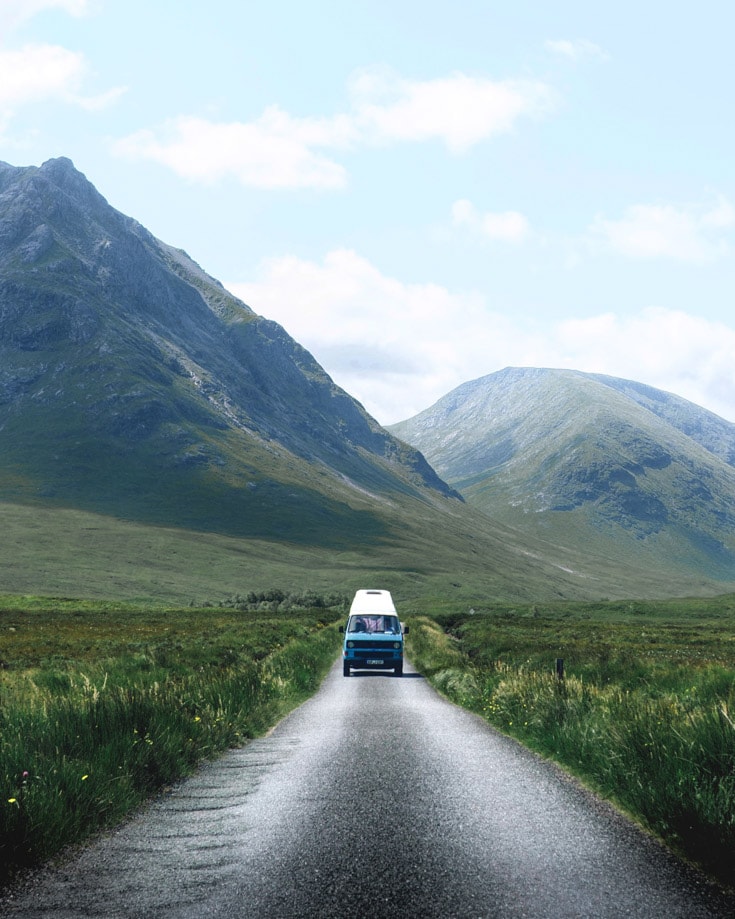
Keep your Campervan Batteries Warm
RV batteries can freeze, so keeping them warm is critical for living in a camper in the winter.
But how do you prevent your campervan batteries from freezing?
There are three factors to consider: the batteries, how long low temperatures last, and how well the battery is insulated.
A fully charged battery will freeze at a much lower temperature than a discharged battery.
Keep the battery topped up to help it survive the cold and retain its energy.
Suppose the low temperatures are just a transient cold snap and expected to pass quickly. In that case, this is probably not too damaging.
It’s more important to keep the batteries warm when the low temperatures last for more than a few days.
If you plan on spending a lot of time in sub-zero temperatures, check out the battery’s specification before your buy. It will state the freezing temperatures at varying charge states.
The best advice is to position your batteries inside the camper to manage the temperature and battery insulation actively.
Different types of batteries perform differently in cold temperatures. For example, lithium-ion batteries will freeze at much lower temperatures than AGM batteries but can’t be charged when too cold.
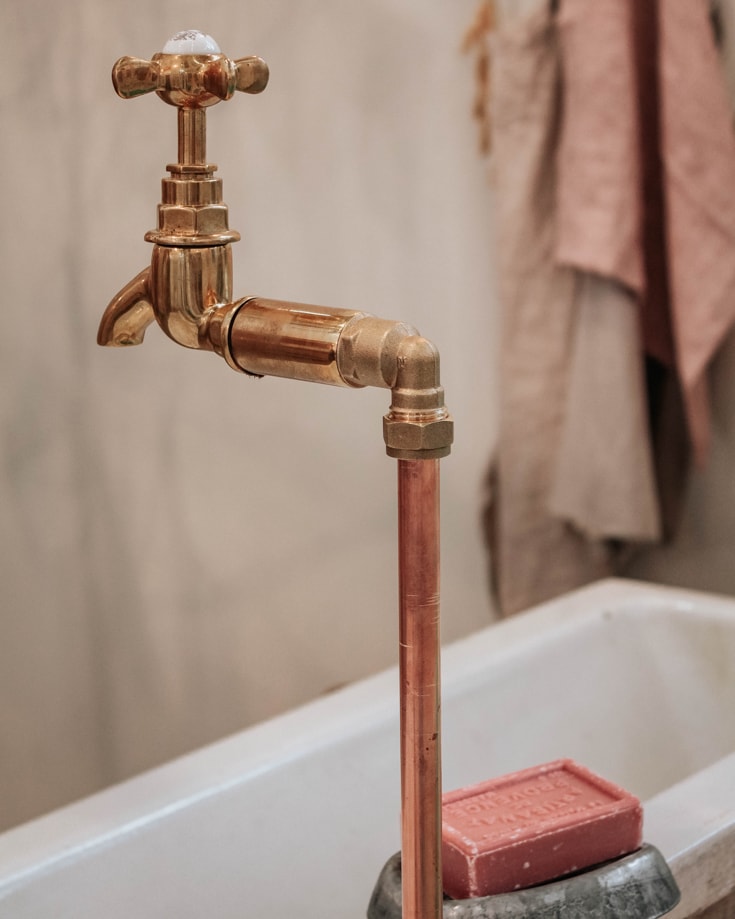
Protect the Water Supply from Freezing
Sub-zero winter temperatures can lead to freezing water tanks and pipes.
Not only will this stop you from having your morning coffee, but it could lead to burst pipes. It's not the best way to start any day.
We read somewhere we should pour whisky into our tanks, but we have a better use for our Johnnie Walker.
So how do we protect our water tanks and pipes from freezing?
If your campervan water system is indoors, you probably don’t have to worry too much about your fresh water tank if you keep the inside temperature above 0°C.
An electric space heater is ideal for keeping an unprotected water line from freezing.
But our fresh water tanks are underslung outside.
Skirting can provide some level of protection. And we park so our water tanks get as much sunlight as possible.
We also recommend keeping the water tank about three-quarters full. This way, it’ll take much longer to freeze, and if they do freeze, there’s room for expansion.
You do not want frozen pipes in your pump or water heater as they will do irreparable damage.
If you’re in any doubt, winterize the water system by completely emptying it and using LP air to dry out the pipes.
Use bottles of water instead and consider alternative shower options .
Never leave your water hose connected to the supply pipe because it’s likely to freeze solid, making detaching it next to impossible.
Alternatively, you could use a heated water hose.
For waste water, it’s best to leave the drain valve open and let the greywater run into a bucket.
A composting toilet performs better in cold temperatures, so a good option if you plan to live in your camper in the winter.
If you have a campervan toilet with black tanks, make sure not to let these fill too much and pour antifreeze into them.
You really don’t want those tanks or pipes bursting!

Take your Laundry to the Laundromat
Van life laundry can be a challenge in the summer, let alone in the cold, wet winter months.
Even with campsite facilities, drying laundry is the greatest challenge.
To avoid condensation problems, don’t attempt to dry your laundry inside the RV or camper.
If you’re in luck, you may have access to a covered area where you can hang your laundry. The air and wind will help dry the linen while protected from the rain.
But otherwise, use a laundromat.
Our van life laundry article has lots of tips for reducing how much laundry you have too.
These will come in especially useful in the cold winter months when getting the laundry done and dry is a nightmare.
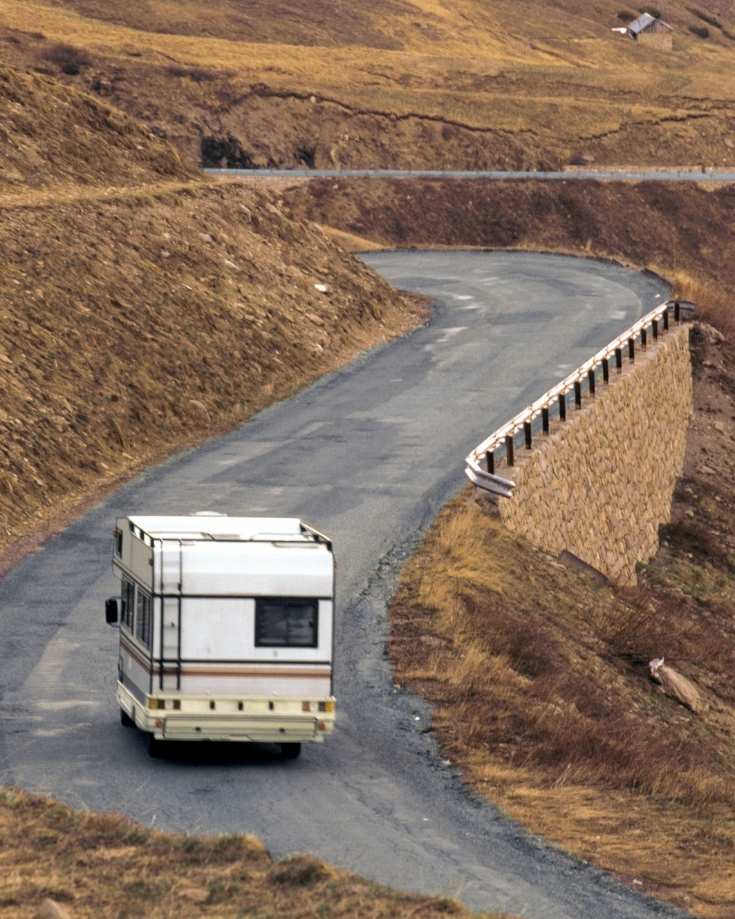
Travel Somewhere Warmer
I know it sounds like a cop out and if skiing is your thing, heading south in the winter months isn’t for you.
But if your camper just isn’t built to keep you comfortable throughout the winter months, then living in it will be grim. Instead, head south.
We can highly recommend Patagonia for the austral summer. November through to March are ideal months.
Who wouldn’t want to tick off driving the Carretera Austral or taking a tour in El Chalten off their bucket list?
You don’t have to go all the way to the southern hemisphere either.
From Europe, Morocco is fantastic in mid-winter and a perfect destination for a road trip.
What To Pack For Winter RV Trips
Even if you don’t live in your camper year-round, winter can be a magical time to take a road trip in your RV.
Winter RV living and driving in winter conditions need precautions.
On top of your packing essentials and accessories, make sure you’ve packed a few extras.
Keep these in your camper for the whole of your winter road trip.
Shovel : A good quality shovel is ideal for clearing away snow in the winter season. While folding military-style shovels save on space, the cheap ones often aren’t up to the job of heavy digging. Because a shovel is helpful for campervan vehicle recovery in many conditions, consider buying one with a strong handle .
Snow Chains : Snow chains are mandatory on some roads and mountain passes in adverse winter weather. Because they provide better traction on icy surfaces, they help prevent skidding and getting stuck in deeper snow.
Ice Scraper: Have you ever forgotten your ice scraper and needed to clear the ice from your windscreen with a credit card? It doesn’t help the card, and your fingers don’t appreciate it either. Get one with a brush on the back to help clear snow off your hood and lights without damaging the camper.
Road Flares: We don’t advise driving at night, especially in the winter. But even so, a blizzard or thick freezing fog could significantly affect visibility. If you break down on the roadside, you don’t want anything crashing into you. Make yourself as visible as possible by using road flares . You’ll be hard to miss. High-vis jackets and flashlights or head torches will help too.
Extra Propane Tanks: If your camper’s heating system, cooking, or hot water depends on propane, stocking up with a few extra tanks will avoid shortages.
Small Space Heater: For an additional heat source when you need it, a small electric heater is just the job. Alternatively, a portable propane heater will eliminate cold air in no time.
12v Electric Blanket : For extra coziness in the depths of winter, electric blankets are a great choice. No matter if you’re car camping, RV living, or even camping in a tent, 12v blankets aren’t energy-intensive, so they won’t drain your batteries either.
Frequently Asked Questions About Winter RV Living
Will RV holding tanks freeze?
If you’re RV holding tanks freeze, not only will it result in a costly repair, but the mess and further damage caused when they thaw can be extensive. Whether or not the holding tanks will freeze depends on where they’re fitted. Warm air from the camper can prevent them from freezing. A full tank is more likely to freeze and cause damage than a half-empty one. Find an effective way to protect the tanks before the cold months arrive.
At what temperature will pipes freeze in a camper?
RV pipes can begin to freeze once the temperature hits 0°C or 32°F. That doesn’t mean they will freeze, though. If the pipes are used daily, it may need to be much colder than this to freeze. Frozen pipes are best avoided, so either winterize the RV if you’re not living in it or take the necessary precautions well before the temperature gets this cold.
Angela Devaney

Angela Devaney, a former IT project management professional, embarked on an adventurous journey of full-time travel, which included touring West Africa in a converted overland truck and converting an ex-military 4×4 Sprinter van into a camper for a five-year South American expedition. She now utilizes her hands-on experience to create practical RV living and van life advice as a full-time digital media producer, reaching over a million users annually through her YouTube channel , blog, and newsletter. Angela also lends her expertise as the editor-in-chief of the Campervan Electrics Handbook .
3 thoughts on “10 Tips for Living in a Camper in the Winter & Living to Tell the Tale”
Don’t go…
Great write up. It’s nice to know I reached all of the same conclusions prior to reviewing your your article. Keep up the good work.
@Jonathan, I am in a 20 ft. Nomad bumper puld trailer and what I need to know is, I have 2-250 watt solar panels with 8 25 watt panels on the roof and a 60 amp controller with 3-100aph batt.also with 5 – 32aph all hooked in series ,ok and now I was wondering if I could tie the 60amp solar controller into the trailers original inverter, converter and and do away with the plug that you would plug into a power pole or generator
Leave a Comment Cancel reply
Save my name, email, and website in this browser for the next time I comment.
Related Posts
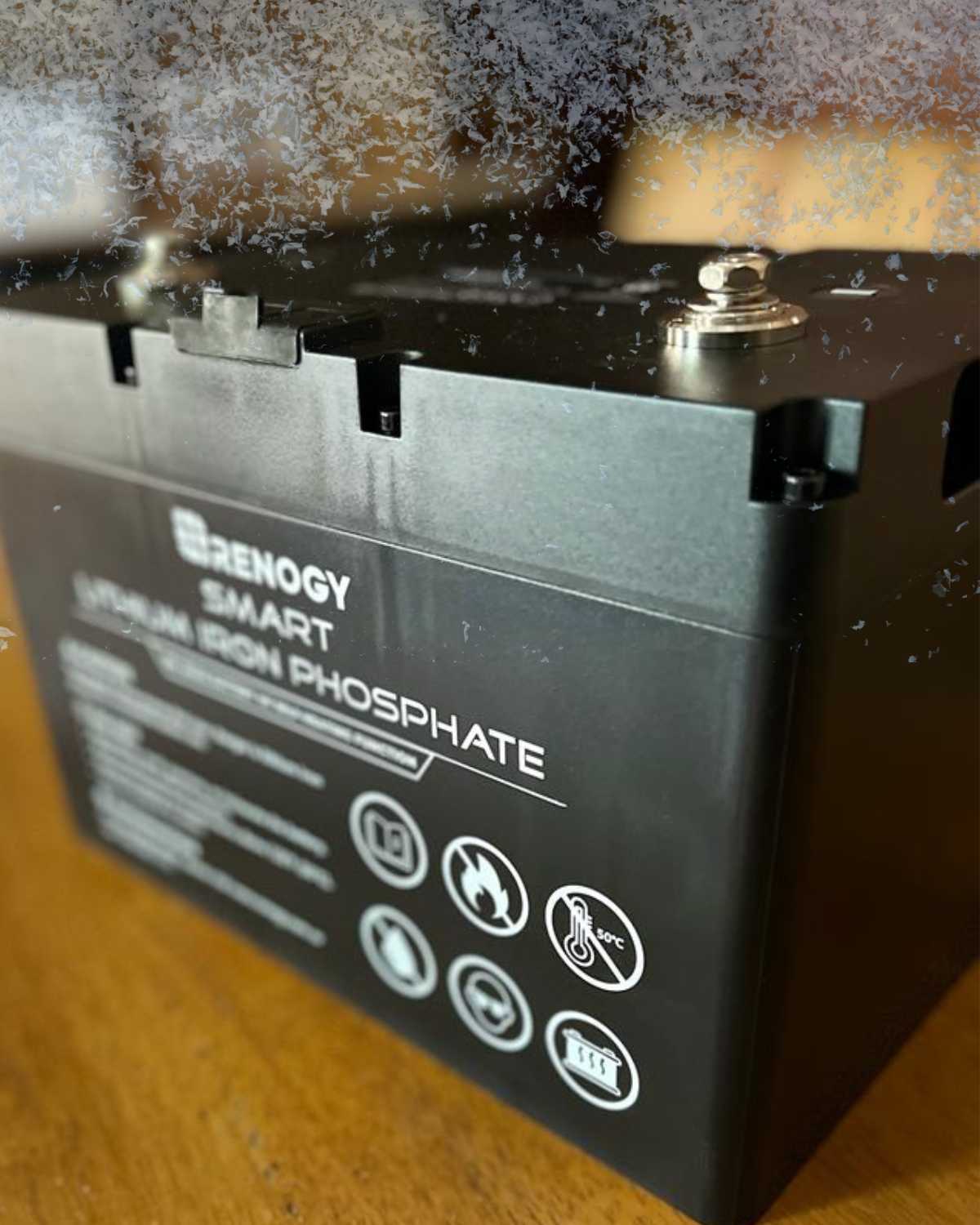
Should I Disconnect my RV Battery for Winter?
September 30, 2023
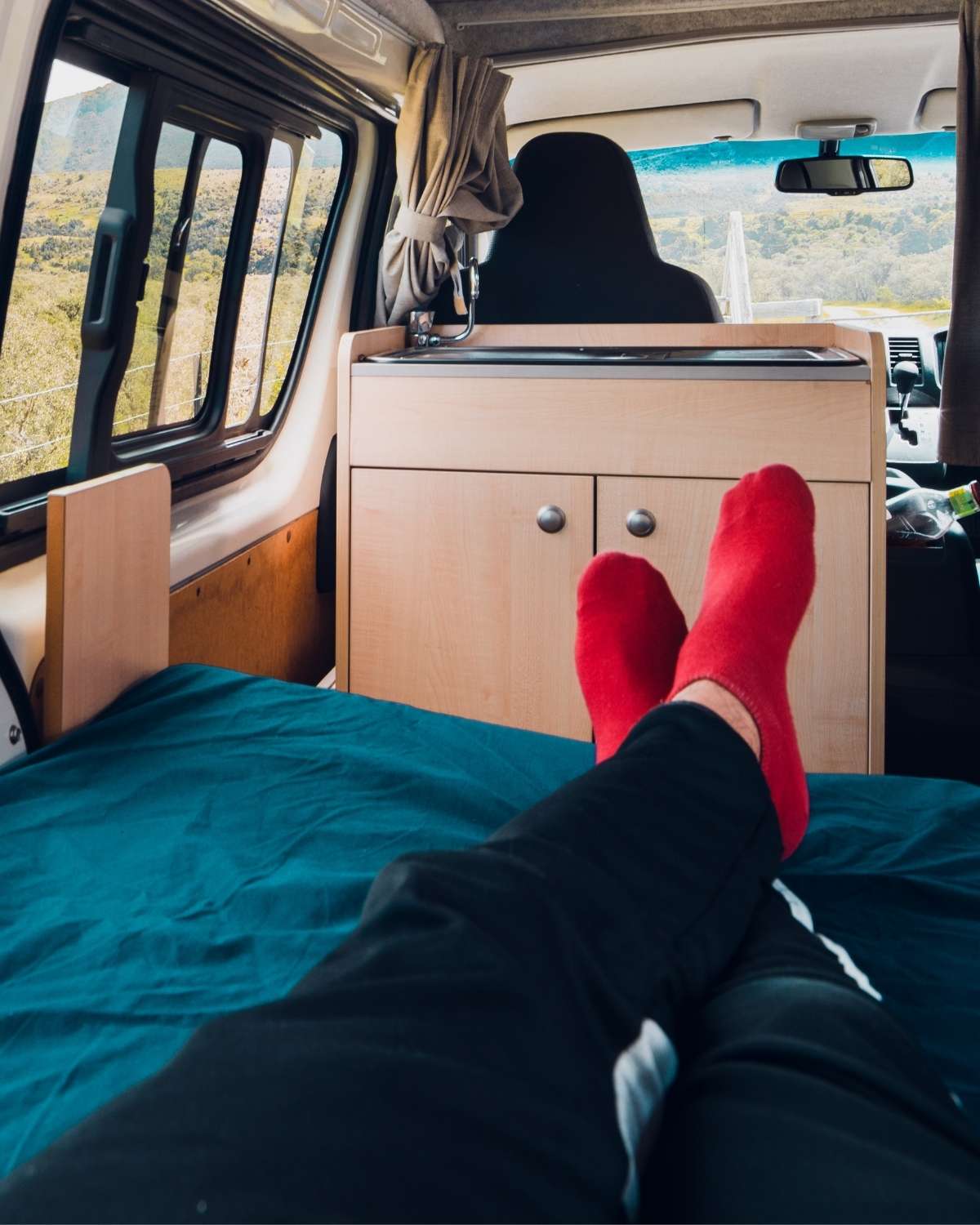
5 Best Diesel Heaters for Van Conversions, Campervans & RVs | A Buyer’s Guide
September 19, 2023

© 2024 mowgli adventures
Privacy Policy | Terms Of Service | Sitemap
Part of Mowgli Adventures Media Ltd. Registered in England and Wales. Company Number 13558893
- Skip to primary navigation
- Skip to main content
- Skip to primary sidebar

- Helpful Lists
Winter RV Living ~ Tips for Cold Weather Camping
Published: Jan 12, 2023 · Modified: Feb 9, 2024 by RebeccaBlackwell · This post may contain affiliate links
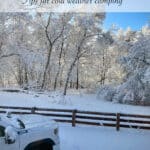
In May of 2020 my husband and I sold our house and moved into a brand new 5th-wheel toy hauler advertised as "4-Season". It was equipped with the "yeti package" that claimed to keep the RV systems protected and functioning even when the weather dropped to zero degrees Fahrenheit.
This sounded good to us because while our primary intention was to spend as much time in 70-degree weather as possible, we also knew that we'd spend most of November and December with our family in Colorado.
The first year after moving into our RV, Colorado was easy on us. We didn't get much snow and temperatures rarely dropped below freezing.
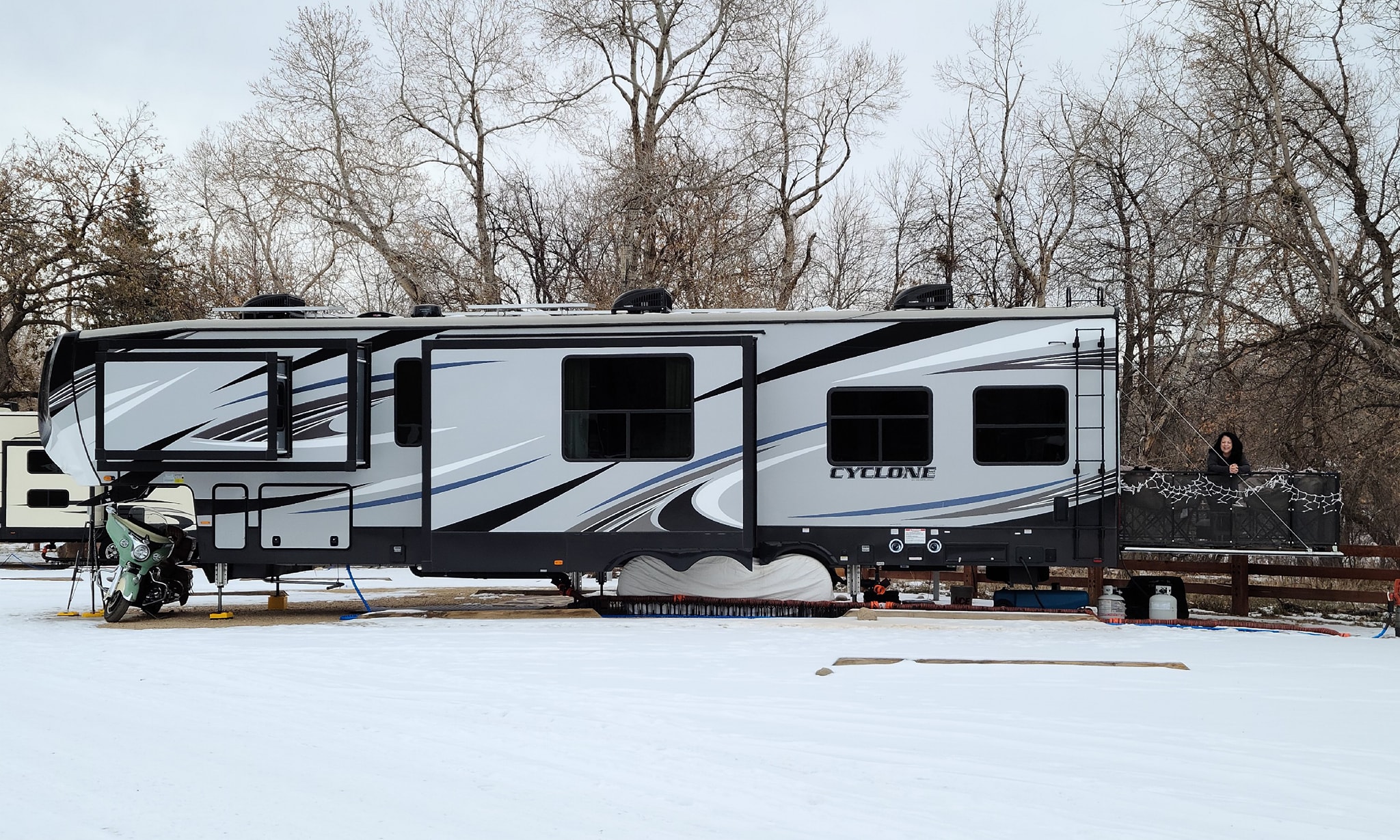
+ Subscribe to my newsletter for new and exclusive recipes in your in-box every month! As a full time traveler, living, working, cooking, and baking from a 5th wheel RV, it's also where I share our experiences of life on the road.
In 2021, a large snowstorm rolled in on the last day of the year, and temperatures dropped well below freezing and stayed there through the first week of January. We woke up every morning to frozen pipes, struggled to keep everything warm, and ended up with a broken black waste tank.
While parked in the Arizona desert later that year , we removed the bottom cover that runs the length of our RV, discovered that one of the heating pads on our tanks was not even connected and that the rest of yeti package "features" were woefully inadequate.
Steve repaired the damage to the tank and added some additional cold weather protection to our RV:
- He made sure all the tank heating pads were hooked up and in working order
- Insulated all the water lines by enclosing them in foam pipe insulation
- Inserted a thermostat-controlled heat cable into the foam pipe insulation, running the length of our water lines
All his work was put to the test later that year.
November and December of 2022 in Colorado were cold, snowy months. There was snow on the ground the entire 7 weeks we were there, nightly temperatures dropped well below freezing most nights, and daytime temperatures rarely rose above freezing. We even had a 3 day stretch in which temperatures didn't rise above zero degrees and dropped to a brutal -17.
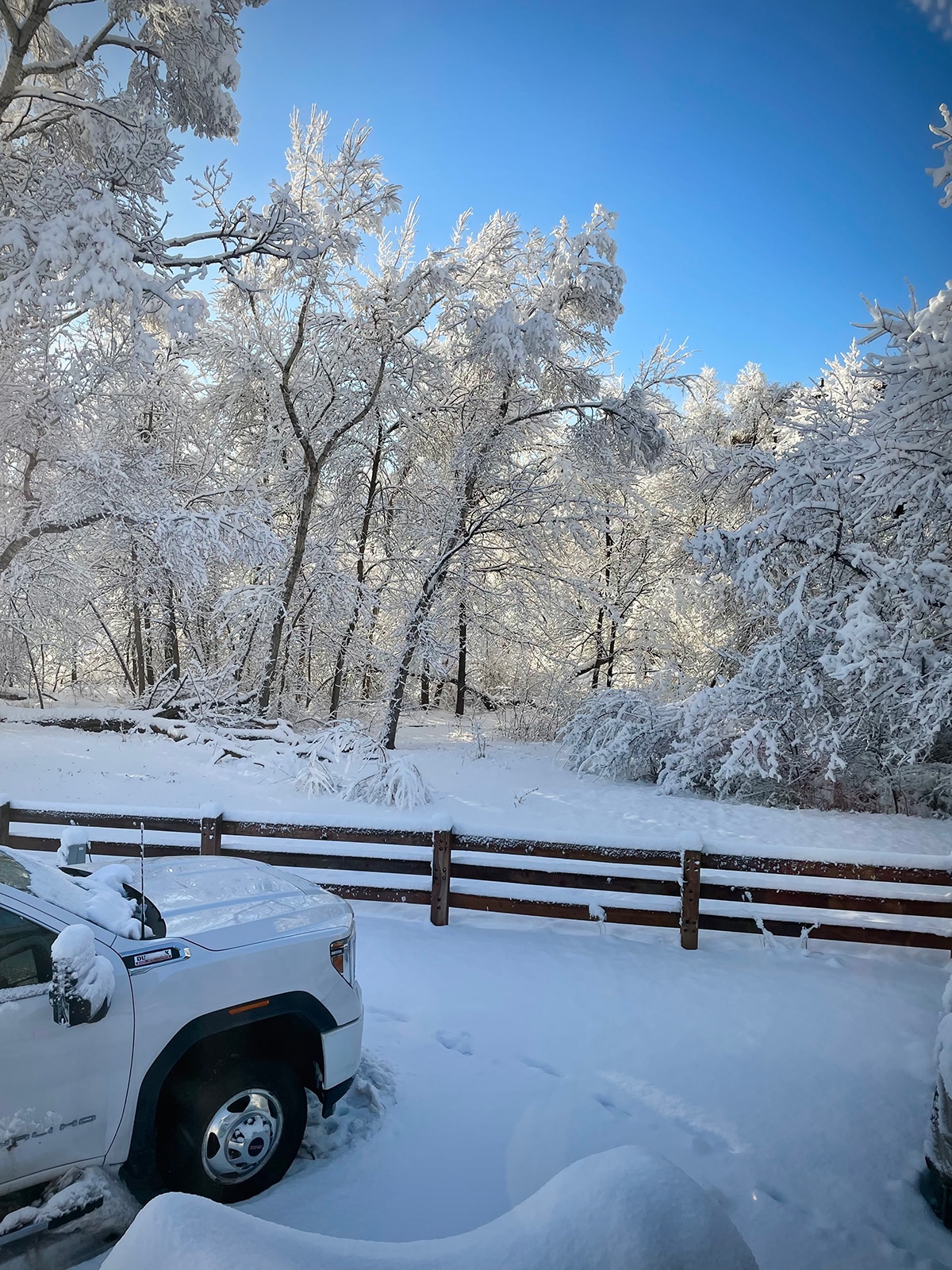
Staying warm and keeping everything functioning in an RV in sub-zero temperatures is a challenge.
Even RVs and campers with more effective cold weather protections aren't meant to withstand severe ice and snow and temperatures that stay well below freezing for days on end.
And yet, we emerged mostly unscathed. In addition to the work Steve did to properly insulate our freshwater and waste systems, we added additional cold-weather protections that kept us warm, our water running, our drains from freezing, and our batteries from cracking.
There are many reasons why RVers might spend time in cold, snowy places. Spending the holidays with family is our reason, but there are so many beautiful snowy places to visit in the winter months. If you're a skier, winter in Jackson Hole, WY , or the mountains of Colorado, Montana, or Utah might be reason enough.
Winter can be a beautiful time to get outside and explore new places and with some preparation there's no need to restrict yourself to places with warm and temperate temperatures.
Here's what we did to prepare and protect ourselves and our RV from the cold and snow plus some additional tips to help you prepare for RV winter camping.
3 Tips to Keep Your RV Plumbing System from Freezing and Bursting in the Winter
2 ways to keep the inside of your rv warm in winter, more rv winter camping tips, essential equipment for living in an rv in the winter, more rv and camping resources, #1. heat the "basement".
We refer to the storage compartments beneath the floor of our RV as the basement. That general area contains our batteries, most of the rig's wiring, the water lines, and connects to our waste tanks and fresh water tanks.
It's essential to heat this area if you want to avoid frozen pipes and cracked batteries. Many RVs use the propane heating system to keep this area warm. Ours doesn't work that way, so we added electric space heaters and thermostats to monitor the temperature in critical areas of these storage areas. And honestly, when the weather drops below zero, fortifying your heat situation is critical no matter what.
These extra measures worked great. Even when the temperature dropped well below zero, the storage compartments hovered around 40 degrees.
#2. A heated water hose and electric heat cables can keep the water running and drains from freezing
If you are camping in a place with fresh water hook-ups in the winter, a heated water hose is essential. Regular water hoses will freeze quickly in cold weather but a heated hose will keep the water flowing even when temperatures drop below zero.
We also wrapped electric heat cables around the sewer hose and every exposed pipe. In combination with the space heaters in the basement, the system worked pretty well.
If you DON'T have a heated water hose, but you DO have a heating pad on your fresh water tank, you can fill up your fresh water tank and disconnect your fresh water hose. But, in most cases, if you're going to do any winter camping in your RV, you'll want to invest in a heated water hose.
#3. Don’t leave the gray and black tanks open in freezing weather
Many RVers leave the gray tanks open when camping at parks with sewer hookups. But, in the winter, this can cause problems. Add some anti-freeze to black and grey waste tanks to prevent the wastewater from freezing and close them.
Empty the tanks when they are about ⅔ full. Even with anti-freeze in the tanks, it's important to not wait until they are completely full before emptying them. In extreme weather even tanks with anti-freeze can freeze and might cause damage if they are full.
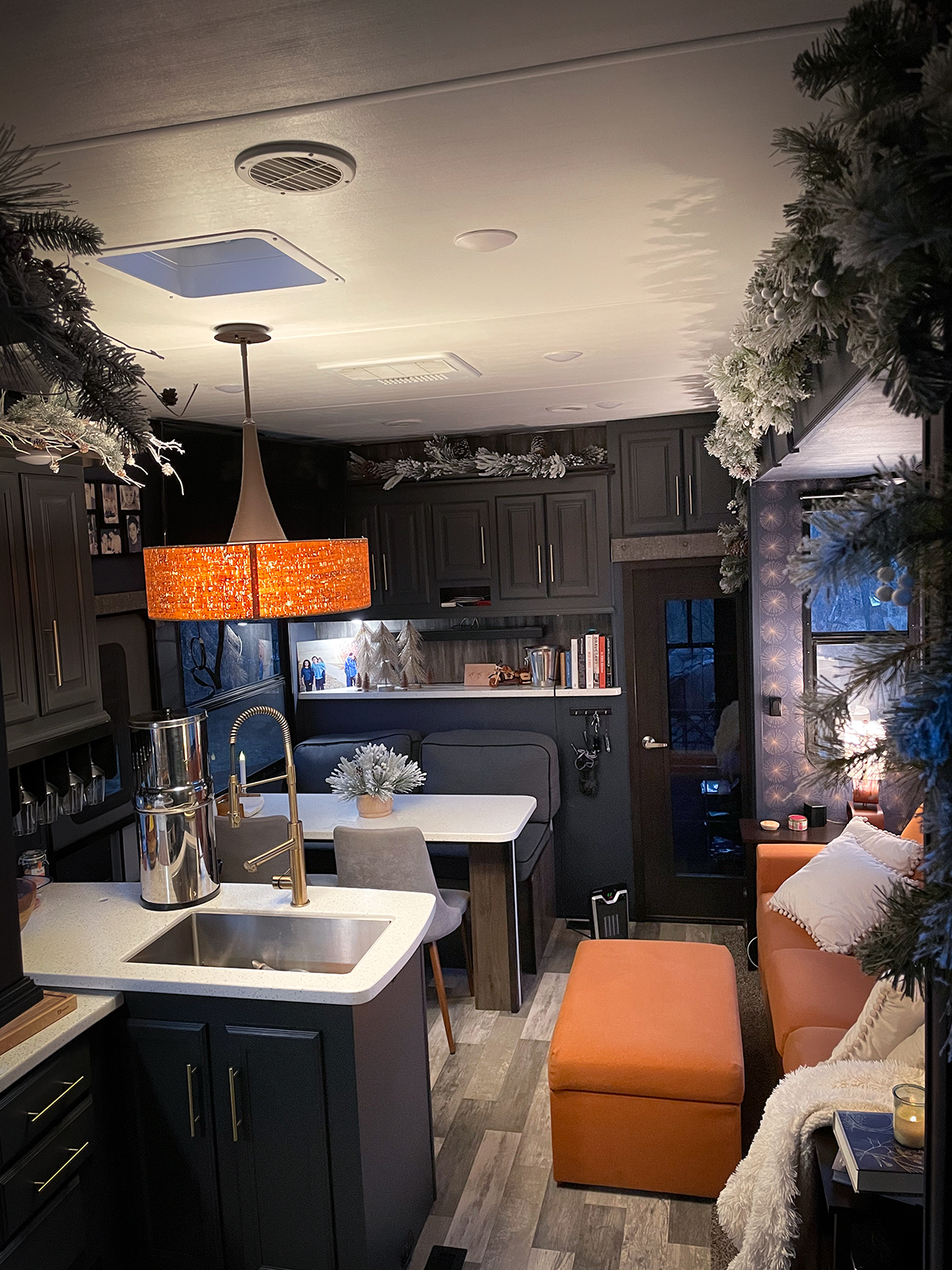
#1. Use electric heaters in addition to your RV's propane furnace.
To keep the temperature inside our RV at a safe and comfortable level in freezing weather, we kept 3 electric heaters plus an electric fireplace running non-stop.
Most of the time, this was sufficient to keep the inside of our RV warm on cold days. But, when the temperatures dropped below freezing, we also turned on our propane furnace.
Running this many electric heaters (3 space heaters plus the fireplace inside our RV plus two space heaters in the "basement" storage compartments) required some creative load management so that we could keep the load evenly distributed and not trip any breakers. It's important to understand your rig's electrical system and work within its limits.
#2. Insulate the windows
If your RV has double-pane windows, this might not be necessary. Our RV has single-pane windows that are not even approaching energy efficiency.
To add some additional insulation, we put clear shrink wrap over our windows which worked remarkably well. Two tips for using clear shrink wrap over RV windows:
- The tape sticks better to the walls around the windows than the window frames. As condensation builds up on and around the window frames, the tape will not hold.
- When possible, cover the windows when the temperature is above freezing. If you cover windows when the temperature is below freezing, the film will detach or tear from the inevitable expansion that happens when temperatures rise even slightly.
- Protect your batteries. We use lithium-ion batteries in our RV. Below-freezing temperatures can cause lithium-ion batteries to crack and separate from surrounding materials, reducing their storage capacity. To protect our batteries against extreme cold, we put a thermostat-controlled electric space heater in the battery compartment.
- Remove Snow and Ice to Protect the Exterior of Your RV . When snow and ice are allowed to build up on the roof of an RV, it can open the seams in the roof as it thaws. This can create water leaks that cause structural and cosmetic damage.
- Shovel. Honestly, a shovel is important to keep on hand at all time in any size camper or RV no matter the weather.
- Electric space heaters . We generally use electric space heaters instead of our propane furnace to heat the inside of our RV when connected to shore power in the winter. When the weather is extremely cold, we use our electric heaters in addition to our propane furnace. If you're curious about the difference between forced air, ceramic, or catalytic heaters, this is a good comparison.
- Electric fireplace . Our 5th wheel came with an electric fireplace in the bedroom and it's all that's necessary to keep us warm on even the coldest nights. The one complaint we had about the fireplace is that it was not thermostat controlled. Earlier this year, Steve replaced it with an electric fireplace that IS temperature controlled and we are much happier with it.
- Heated hose. A heated water hose is essential if you want to keep your camper connected to city water during freezing weather.
- Electric Heat Cables . We wrapped heat cables around our sewer hose and every one of our RV's plumbing pipes.
- Foam Pipe Insulation . We enclosed our water lines with foam pipe insulation secured with zip ties.
- RV Skirting. If you’re staying in one location for a while during the winter months, installing an RV skirt is 100% worth the investment. An RV Skirt is material placed around the bottom of your RV to help insulate your tanks and pipes from cold, snow and ice.
- A Generator . Even if you're plugged into shore power, having a generator that can get you through power outages is essential.
- Tank Heating Pads. Heating RV waste water and fresh water tanks makes them much less likely to freeze. If your RV came with tank heating pads, make sure they are installed correctly. If you RV doesn't already have them, they are easy and inexpensive to install.
- Extra Propane . Running out of propane in the middle of a cold night is not a fun experience. Always make sure to have at least one extra full propane tank at the ready.
- RV Antifreeze . Adding antifreeze to black and grey waste tanks can help them from freezing in extreme temperatures even if you also have tank heating pads.
- Shrink Wrap Window Covers . If you have single pane windows, these clear shrink wrap window covers make a huge difference in insulating the inside of your RV from the cold.
- Electric Heating Blankets . We have two electric heating blankets in our RV and they are essential to keeping warm on really cold nights.
- RV Living FAQs : Questions and answers about what it's like to live in an RV while traveling full-time and working remotely.
- Curious about where we're headed next and how we plan our itinerary? Click here for our yearly travel schedule
- Let's Get Lost is a Travel Journal about the places we've been, recommendations for things to do and see in those areas, and the reality of RV living and full-time travel.
- What is boondocking? Questions and answers about boondocking and dry camping.
More RV Life

Reader Interactions
No Comments
Leave a Reply Cancel reply
Your email address will not be published. Required fields are marked *
Notify me via e-mail if anyone answers my comment.
- Skip to primary navigation
- Skip to main content
- Skip to primary sidebar
- Skip to footer
Journey With Confidence
What No One Tells You About Living In An RV Full Time

What I Wish I Knew Before Full-Time RVing
Traveling in an RV full time is a lifelong dream for thousands of people, and it is a decision that can change your life and your perspective, but it’s not just one long vacation.
There are issues that can make this experience more fun or less enjoyable, so I want to share what no one tells you about living in an RV full time before you start on this journey.
Size matters
One of the most important decisions you’ll need to make when becoming full time RVers is what type and size of RV will meet your needs, and bigger is not always better.
In the five years that we have been full time RVers, and in the 20+ years as active weekend warriors before that, we’ve met dozens of full time RVers who regretted their RV choice, and that decision impacted every aspect of their full time RV adventure.
RVs that were too big
Some of these folks went to RV shows where massive fifth wheel toy hauler trailers were all set up with their dropdown back and side patios, open kitchen with a freestanding island, and lots of extra play space for the kids and pets in the back. These models were all on display, beckoning the would-be full timer to imagine how much fun they could have in these huge RVs.
We met a couple who got sucked into this illusion, but they had never even camped in an RV before they bought a 45-foot fifth wheel trailer. They quickly learned the stress of towing it, backing it, and setting it up in a campground. They remembered how tall it was, and that had already resulted in two accidents that damaged their new RV.
This couple was a nervous wreck. They had sold their house and everything in it to begin this new adventure, and they were absolutely miserable. They deeply regretted their decision and were not coping with the stress of their new lifestyle. Perhaps they might have been happier with an RV that was smaller and more manageable. After all, did a couple with no kids or pets really need an RV that large?
Another couple’s trailer was so large they refused to tow it themselves, so they hired a towing company to move it from one campground to another. They loved all the extra space, but it was extremely limiting to the spontaneity and adventure of being full time RVers.
Additionally, we met a couple with three children who bought the largest RV they could afford to give their children plenty of space for schoolwork and activities, but they quickly learned they didn’t need that much space, and their large RV was difficult to fit into many state parks and even some private campgrounds.
RVs that were too small
On the flip side of the size issue is an RV that is too small to meet your needs. Again, we have encountered many people who thought a small RV would be the perfect fit for their full time adventure, only to realize after buying one that the sink was too small to even wash the dog bowl, there wasn’t enough storage space for their gear, the space in the refrigerator was very limiting, the holding tanks were so small they could only boondock for a day or so, and not having an onboard shower required some creative outdoor gear and adaptations.
Certainly, smaller RVs are lightweight and nimble and can go almost anywhere a car or truck can go. They fit into almost any campsite, which makes them a very attractive option. Most of the smaller RVs provide a great base camp for an outdoor camping lifestyle, which is great until you discover that the weather conditions in many parts of the country are not conducive to an outdoor lifestyle.
Be prepared for winter weather
As full time RVers, you’re going to be living in your RV year-round, which will include all the winter months. We full-timed in Oregon for several winters and met numerous other full time RVers struggling to find shelter from Oregon’s constant winter rain.
One Canadian couple was full-timing in a teardrop trailer; another single man was using a pop-up Alpine trailer; a single woman and her dog were in a brand new van conversion; and another couple and their two dogs were in a very small Class B+ motorhome.
Oregon winters are not compatible with an outdoor lifestyle, and the people who were camping in these very small RVs had little to no room to move around, cook, recreate, or even shower without walking a few hundred yards through the rain to the public restrooms.
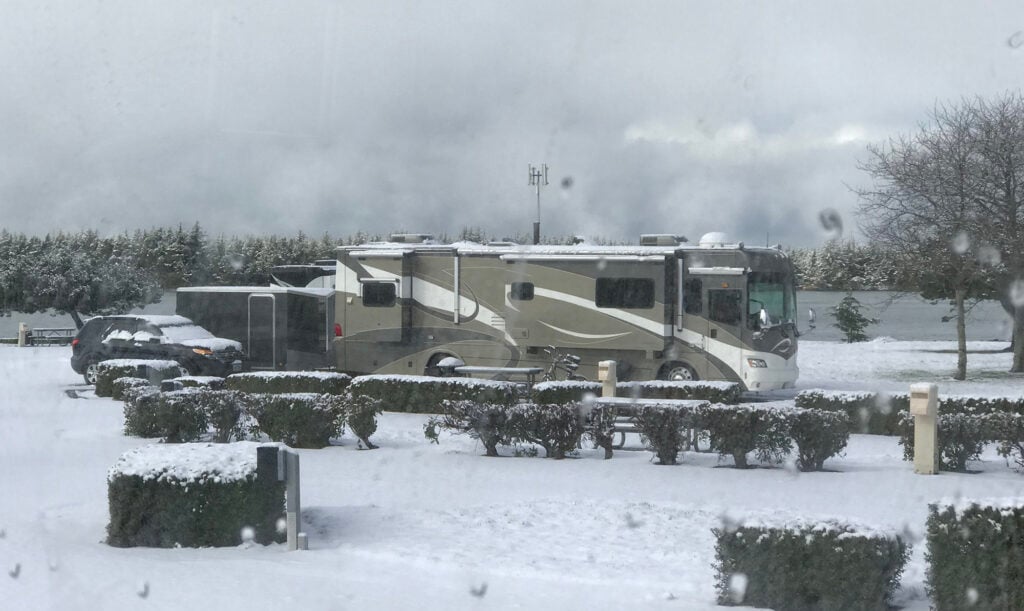
Try renting an RV first
Therefore, for new full time RVers, the first and most important consideration is to fully understand what size and style of RV will really meet your needs. The best way to do that is to rent a few different types of RVs and then go camping in them to see how they fit.
Don’t be in a rush to buy the biggest or smallest RV before you consider the pros and cons of each option. Take your time to explore all the features, benefits, and limitations of each type and size of RV. Know where you think you want to travel and what your objectives are, then spend time talking to current RVers to learn from their experiences.
Do you just want to live in an RV to save some money, or do you want to be continuous travelers on an extended adventure of discovery? How do you want to use your RV, who will be using it, where do you want to travel, how long will you be full-timing, and what is your exit plan? These are all important upfront considerations that will help you find the right RV for your full time RV lifestyle.
Uncertainty can be stressful
Another thing people don’t think about when they’re considering a full time RV adventure is that uncertainty can cause a lot of stress. When you’re in a daily routine, you follow familiar patterns. You shop in the same places, take the same route to and from work, know your neighbors, have favorite restaurants, and basically do the same things without really thinking about it. This routine may become monotonous, but at least it’s familiar.
But when you’re a full-time RV, everything is new and uncertain. This may be one of the allures of becoming a full-time RVer, but most people don’t appreciate just how pervasive this uncertainty can be. You have to think about everything and plan ahead, like where and when you will be traveling , how are you going to get there, and what weather or climate issues will you encounter.
Even after doing all this planning, you still have no idea what you may encounter when you arrive at a new destination. Even stopping for gas or diesel can be a stressful and frustrating experience.
Plan your travel days ahead of time
We often try to drive ahead in our tow car to our next destination to make sure the road is suitable for our 38-foot motorhome. We scout the road, gas stations, campgrounds, overpasses, tunnels, and any other travel hazards so we can reduce the stress of the uncertainty.
On several of these scouting trips, we have discovered roads that simply were too narrow or too long to justify the trip, or we discovered that the internet description of the campground where we had made reservations was completely false, and the campground was just not a good fit for us or our RV.
Another stressful uncertainty of full time RVing is the weather. Many full time RVers report this as their biggest concern. Snow, ice, hail, wind, lightning, hurricanes, and tornadoes are all potential dangers if you live in an RV.
You might think that being in a house on wheels would allow you to avoid dangerous weather conditions, but in many of these devastating storms, you do not have time to get away from the hazard, nor do you know which way to go to avoid it.
Lightning can cause a forest fire to surround you, and there’s no way to predict where a tornado will touch down. In one case, we had less than 15 minutes warning that we were in the direct path of a damaging hailstorm. Fortunately, it slipped past us just beyond the campground, but even with the biggest hail missing the RVs, it sounded like we were in a war zone, as thousands of smaller hail stones slammed into the windows and roof.
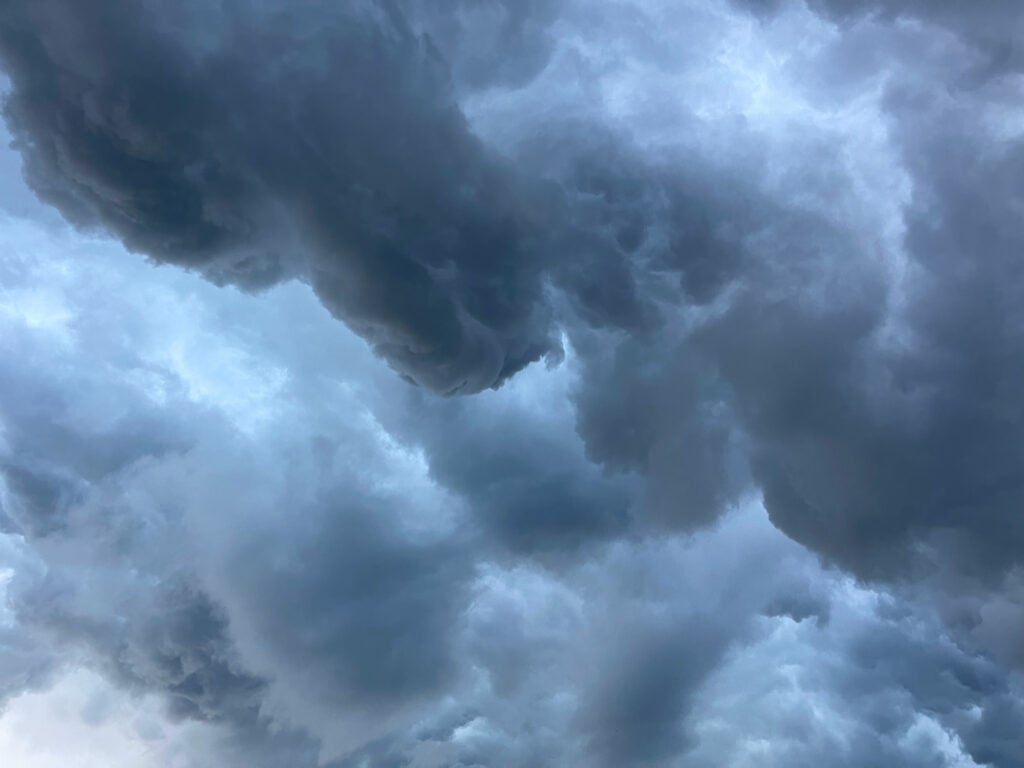
Disconnected from community, friends, and family
Many new RV adventurers underestimate how they will be affected by being disconnected from their communities. We are, after all, social beings, and we rely on family, friends, churches, clubs, organizations, teams, and loose affiliations to help us feel grounded and mentally well.
When you start a full-time adventure, you trade the familiar in for the unfamiliar, and many full time RVers express frustration with the superficial interactions between RVers that are common in this lifestyle. You may actually get to know some other RVers, and you may even choose to travel with a group, but sooner or later the rally will break up, and either you or they will be onto another destination.
Of course, you can keep in touch with family and friends via social media and technology, but it’s not the same as bowling with your team or playing gin with your usual group of friends. Holidays, family events, birthdays, big occasions, and celebrations, plus all the small routine visits from the kids and grandkids are no longer part of your routine. Being home sick may be a much bigger problem than you ever anticipate when you start on your full time RV adventure.
Full time RVing can be surprisingly expensive
Lastly, what no one tells you about living in an RV full time is that it may be more expensive than you originally thought. This may not be true for everyone, but our personal experience is that it is significantly more expensive.
You try to anticipate your costs, RV insurance , car/truck payments, fuel expenses, park fees, groceries, pet food and supplies, supplies for the RV, maintenance costs, emergency costs, etc. But for some reason, all these things may cost more than you anticipated.
Then there’s the admission fees to parks, museums, attractions, dining experiences, and sightseeing opportunities. It all adds up.
When we first started our full time adventure, we met a couple who had already been full timing for about three years, and we discussed the issue of the budget. They told us that their goal was to stay as close to $100 per day as possible with a monthly budget of $3000. At the time, we thought that was a little extreme because our budget indicated monthly expenses less than that.
We were wrong! Now after having spent over five years on the road as full time travelers, we have discovered that their goal of a $100 a day would be a huge victory for us because our average monthly expenses are closer to $5,000. Every month, we record all of our expenses, and we analyze these costs to see if we can economize anywhere, but we’re never able to shave much off the bottom line.
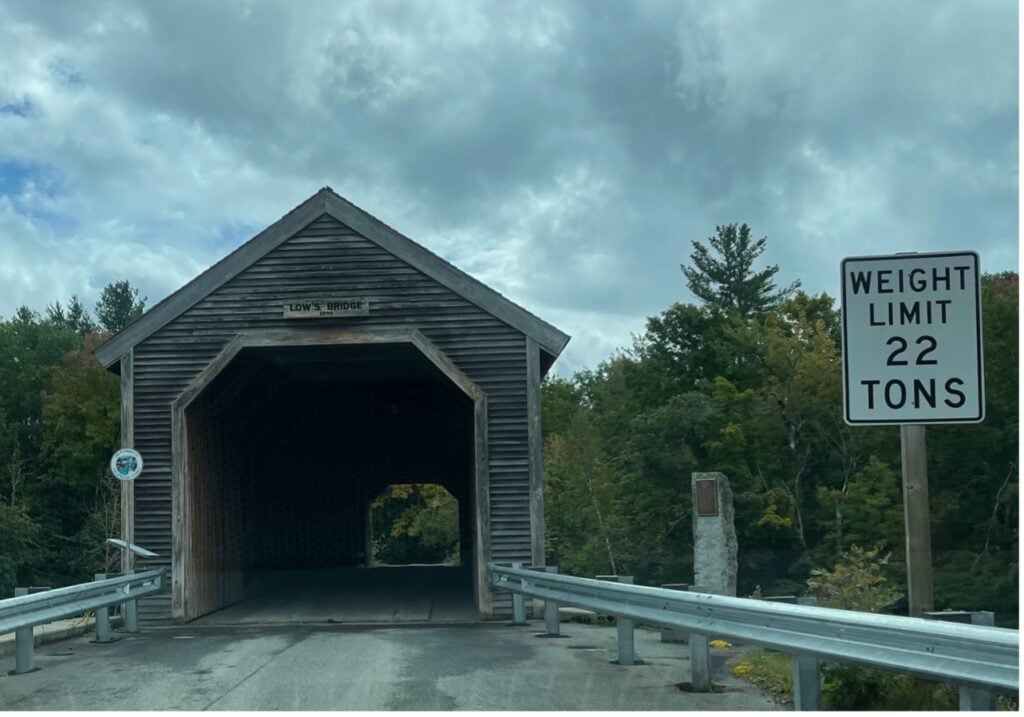
Be prepared to budget
We spend more on technology than most people, but we work from our RV and need reliable connectivity. We started our journey with several dogs (now we’re down to two), and we refuse to economize on their food and supplies, so we continue to economize and dream of getting down to $100 a day.
To be completely transparent, it’s worth mentioning that we do not have a car payment, motorhome payment, or an extended warranty. We have had a couple of significant RV maintenance bills, and two expensive dog health procedures that impacted our budget, but those are the types of emergencies you have to plan for when you are thinking of becoming full-time RVers.
Another relevant fact is that we do not like to boondock or camp in rustic campgrounds without electricity, sewer, and water. Our RV is set up for boondocking, but we just prefer full service campgrounds.
When you add up the fees for camping for 365 days a year, it will have a significant impact on your budget. We know many campers and full-timer RVers who only use full service campgrounds, for a few days a month, and I believe they might be able to hit the $100 daily goal more easily. Some other campers, only use membership campgrounds like Thousand Trails , and that will also lower your monthly costs. These are all personal decisions and only you know what will work for you.
Get tips from other full time RVers
One of the best parts about RVing is engaging with the community of traveling enthusiasts. iRV2 forums allow folks to chat with other RVers online, and get other perspectives on everything RVing, including products, destinations, RV mods, and more.
Related articles:
- The Dirty Truth Of Full Time RVing
- 10 Common Myths About Full-Time RVing

Living In A Travel Trailer During Winter
Heating, ventilation, and condensation.
- To reduce heat losses in your vehicle and improve your comfort, seal air leaks by using thermal insulation.
- For your safety: Do not alter or heat your vehicle improperly to avoid any danger. The use of heaters without an outside outlet is not appropriate to maintain the temperature of the room, such as space heaters or the gas oven.
- Heaters without an outside outlet generate carbon monoxide, a colorless and odorless gas that can be fatal; and they also produce about ½ gallons of water for every gallon of fuel.
- Any type of heater that burns fuel inside the room must be properly ventilated to remove the presence of toxic gases.
- Make sure you have a fire extinguisher and carbon monoxide detectors on hand.
Humidity Control When Living In A Travel Trailer During Winter
- Unlike heaters without an external outlet that burns fuel such as propane, electric heaters, and ventilated combustion heaters do not generate moisture problems.
- People and animals that live inside the vehicle will produce a lot of moisture and condensation will form on the surfaces where the air is saturated.
- Health problems can arise when humidity levels are high due to the proliferation of mold. Be sure to periodically provide some ventilation to avoid the presence of unhealthy conditions and avoid damage to the parts of your camper.
- Monitor humidity levels and keep them below, or between 30 and 40%, depending on the amount of condensation that forms.

Adapting Windows For Living In A Travel Trailer During Winter
- Windows with double and triple glass reduce heat transfer and reduce condensation problems. You can create the same effect by installing Lexan or thick plastic sheets outside the windows, and adding thermo-shrinkable plastic sheets inside, thus reducing heat loss and cold air infiltration. Aliner campers , such as the Aliner Ascape , they have Lexan windows. Aliner is a brand known for manufacturing a-frame campers . However, these campers are not suitable for living in a travel trailer during winter. We have a list of RVs that withstand better extreme cold weather temperatures.
- Install curtains that provide insulation and at the same time be decorative. Wool or fleece quilted fabrics work perfectly and can be purchased at factory locations or chain stores.
- Seal the curtains against the wall using Velcro or other closures. This will allow you to reduce wind gusts.
- Cover windows whose main use is not lighting, especially those that are toward the north side of the camper. Use insulation foam to reduce heat loss.
- Put insulating adhesive rubber tape around the door frame.
- Because the doors could be poorly insulated, it is recommended to use weather strips and curtains of quilted fabrics that cover the entire door, and likewise for the windows. Good insulation in doors and windows is key for living in a travel trailer during winter.
Ceiling vents
- You will need ventilation to replace the moist indoor air with the dry outside air. Cover and insulate the vents with some type of sealing material for living in a travel trailer during winter, but it is important that it can be easily removed.
- To seal the grids, buy industrially manufactured plugs or rigid insulators; Cut the material the same size as the opening and wrap it with masking tape to strengthen it.
Electrical openings and pipes
- Seal the areas around the electrical openings and pipes that have an external outlet. If possible, caulk small holes and use expandable insulation foam to seal large areas.
- Be prudent with the use of foams as these can expand and damage certain areas. Low expansion foams have traditionally been used to seal doors and windows and can be easily acquired.
- Remember that fiberglass insulators do not obstruct the movement of air, so plugging openings with this fiber will only be effective if they have been previously sealed.
- The addition of a base to the RV is essential to reduce heat loss. You can buy sockets made commercially or made of different materials, such as laminated wood or rigid insulation.
- The use of rigid insulators helps maintain the temperature of the lower part of the camper, thus preserving the warm floor and the area below the freezing vehicle.
- If the floor has not yet frozen and the area allows it, bury the socket a few inches, which will give it stability and reduce the flow of air. You can check some examples of how other people have built sockets for their campers at the following network links. (Note: These examples do not represent the ideal of how the seal should be made inside the camper, but they can be of short-term help. Check with local dealers for information on professional skirting installers.)
Rodents And Pests
- Do not use straw or bales of hay because they attract rodents, retain moisture and pose a fire hazard.
- The baseboards create a dark and warm environment that attracts rodents, so you must take precautionary measures to control these animals. The best option is to seal any hole greater than ¼ inch.
- Seal the holes with expandable foam, then cut a thin piece of aluminum from a soda can and put it over the hole.
- Locate traps and bait with poison in the slots where sealing has left gaps.
Folding compartments
- Remove snow that accumulates at the top of the folding compartments to reduce the damage caused by water.
- When snow accumulates at the top of the folding compartment, heating inside the camper can melt the lower layer of snow, creating an ice dam. You can use the rigid insulation to seal the body of the camper.
- However, any insulation that is placed over the top of the compartments must contain a tilt, in order to allow water to drain out of the camper.
Water Systems When Living In A Travel Trailer During Winter
Water tanks.
- Verify that the tanks and pipes are insulated and that the heating circulates around them. To be possible, You could leave the doors of the cabinets open or make use of small electric heaters.
- In those pipes that have not been isolated or are not at warm temperatures, such as showers or external taps, it is recommended that they are drained to avoid damage caused by water freezing when you are living in a travel trailer during winter.
- Maintaining fresh open water intakes is very difficult during winter in North Dakota. One option is to wrap the hose with thermal tape and use pipe insulation, but this could create a fire hazard. For the use of the fresh water tank of the camper to be simpler, the tank must be thermally insulated, instead of being exposed to freezing. It is also recommended that you fill the tank periodically and thermally insulate it from the outside.
Wastewater and sewage systems
- Verify that the tanks are thermally insulated.
- To reduce the possibility of tank freezing, use electrically heated heaters and periodically empty the tanks instead of letting them drain continuously.
- Avoiding freezing of external drainage pipes will be a very difficult task. Do not stick to the use of flexible drain hoses that can easily become brittle with extreme cold; and instead, install a PVC pipe in the drains.
Anthony Foxx
I am Tony, an RV designer and RV developer. I create bill of materials for RV manufacturers for travel trailers and fifth wheels. I worked as a freelance transportation consultant for Lyft. As an RV development consultant, I create customization trees for RV manufacturers who want to offer a solution to prospective customers to design their custom RV with variant configuration. Apart from this, I sell in Indiana trailer hitches, hitch balls, goosenecks and weight distribution systems where I provide advice to customers who want to know which is their towing capacity, which hitch ball should they utilize and how to deploy a weight distribution system. I do my best to explain all these processes and their installation, here in RV Favorites.
FEATURED ARTICLES
RV Plumbing Maintenance
Camper Plumbing Maintenance and Repairs Doing plumbing repairs in your particular camping unit is a part of regular maintenance. Inspection at the beginning of the season is a must if your...
Clearance Between Truck And Fifth Wheel
How Much Clearance Is Needed Between Truck Bed And Fifth Wheel Minimum clearance between truck and fifth wheel must be 6" Lower than 6" may cause a direct impact or at least the underside of...
- Buyer’s Guides
- Air Conditioning
- Backpacking
- RV / Motorhomes
- Portable Power Stations
- Solar Panels
- Solar Powered Generators
6 Best Solar Generators in 2024 Reviewed
4 best solar generators for house boats in 2024 reviewed, 4 best backup power sources for security systems in 2024, 5 best solar generators for container houses in 2024 reviewed, how many watts does a well pump use, how many watts does a camera use, how many watts does a leaf blower use, how many watts does a sump pump use, why renewable energy is the cheaper, how much are solar panels for a house in 2024, renewable vs non-renewable energy: understanding the differences, how does community solar works for you, rv living in winter: the complete guide.

Some RV owners put their motorhomes into storage for the winter. Many others live in their RV year-round or seek to continue their off-grid adventures during the winter months.
If you enjoy the RV lifestyle year-round in a part of the country that gets freezing temperatures, you must prepare your RV for winter living.
Preparation is vital to withstand and protect you through the coldest months of the year.
Fortunately, you can prepare for a long winter with foresight and the right supplies. To enjoy RV living in winter, you have to ensure both the vehicle and you are ready to deal with the cold.
Once you prepare for the potential challenges, you’ll be ready to hit the road in virtually all sorts of weather, even in sub-zero conditions.
Preparing Your RV for Winter Weather
Whatever your reasons for RV living in winter, you need to prepare for the weather conditions you will face. You need to get your vehicle ready so that both you and the RV have protection from the elements.
Insulating Your RV
Step one for winterizing your RV is to insulate it. A non-insulated RV lets heat escape, leaving you uncomfortable and potentially unsafe. When you plan to spend time in your RV in cold climates — especially if you’re sleeping in it — you must take steps to protect yourself.
In an RV, insulation begins with the windows. These are the points where most of the heat escapes from the vehicle. Check the caulk around the edges, and replace any worn or damaged areas. Silicone caulk here will last longer and offer better protection against heat loss around your windows.
If you have the time, install window coverings or multi-pane windows . These effectively hold in more heat, lowering electricity consumption and reducing the demands on your heating system.
Next, look into RV skirting solutions to cover the edges between the RV and the ground. It protects against snow, ice, and cold temperatures on the vehicle’s underside, helping prevent parts from freezing.
Seal or cover other openings in your vehicle, including the door and roof vents. Similar to your windows, these are places where heat slips out around the edges. Covering these areas during the winter will hold heat in and help protect you and the vehicle’s interior from cold.
Finally, cover your water tanks. In the coldest temperatures, standing water can freeze if you aren’t careful. Use heating tape to wrap your water tank and pipes, and keep your tanks closed when not in use. Avoid connecting to outside water lines, as doing so makes freezing your pipes and water lines more likely.
Winterizing Your RV
Winterizing your RV can mean two different things.
For those storing an RV for winter, winterizing usually means draining the water from the vehicle and running antifreeze into the engine and the pipes. This procedure prevents the water from freezing, expanding, and bursting your pipes. It will help keep your RV in tip-top shape for spring.
RV living in winter requires a different approach. Don’t wait for the temperatures to drop below freezing. By the time it reaches 40° F (5° C) — if not before — you need to prepare for what’s to come.
You still need to use antifreeze in your vehicle engine; most manufacturers recommend a 50:50 blend of antifreeze and water to protect your engine against the cold. You’ll also want to ensure your battery has a full charge since cold temperatures can drain the battery. These steps will help keep your vehicle operational even in the most frigid weather.
Storing Your RV for Winter
If you decide to store your RV during the winter, the first step should be to drain water from the entire vehicle. Make sure you dispose of the dirty water safely, following the regulations in your area. Flush the pipes and run antifreeze through them to protect them from damage in freezing temperatures.
Powering Your RV in the Winter
If you’re using your RV during winter, running out of power is one of the worst things that can happen. You need a reliable energy source to keep up with your needs and power your heaters and appliances.
You can’t rely on always being able to connect to the local grid or shore power — and often, you just won’t want to. The ability to go off-grid is one of the most attractive aspects of RV life.
Supplemental power generation is critical to actively using or living in an RV during the coldest months.
Generators and Other Power Sources for Your RV
Your RV’s battery works to power some small appliances in the vehicle. The problem is that it won’t keep up with all of your electrical needs for living off-grid . Like all vehicle batteries, the battery will recharge while the engine is running. It will drain quickly if you keep it running while the engine is off. To avoid getting stranded without power, you need to find alternative sources.
At most RV campsites, you can plug into a local power hookup. Shore power provides a convenient recharging site in these locations, so long as everything is operating correctly. In winter, many RV parks limit the number of spaces available or the use of electricity on site. Lack of shore power can leave you in a bind if you need to plug in during the winter months.
To protect yourself and keep everything running, you should have a generator available. In close quarters, you want a safe and quiet generator that still provides enough power to keep your RV going.
EcoFlow’s Power Kits are specifically designed for off-grid RV living. They’re designed to provide all the power you need — from 2kWh to 15kWh — and can recharge using four different charging methods, including household electricity, shore power, and solar panels .
It’s when you add solar panels that you achieve true energy dependence. Power Kits can utilize a combination of rigid , flexible , and portable solar panels to ensure you capture the maximum amount of solar power possible — even when you’re on the road.
There’s even a handy calculator to help you customize a Power Kit for your specific energy consumption needs.
Power Kits integrate with your RV’s existing electrical system. Installation is quick and painless, and the right Power Kit can meet all your off-grid electricity — regardless of the season.
Battery Maintenance and Storage in Cold Weather
During freezing winter days, RV batteries lose their charge faster. To help prevent this, you should check and recharge them periodically. You can do so using a generator or a battery maintainer. Keep your battery fully charged wherever possible so you’re ready to get back on the road or off the grid whenever you feel like it.
If you are storing your RV battery, keep it in a warm, dry location. Check that it has a full charge at least once a month. Don’t leave it connected to a power source unless you have a smart charger, as overcharging can damage the battery.
Staying Warm and Comfortable in Your RV
Even in a fully-insulated RV, staying warm can present a challenge. You will want to prepare with safe and effective heat sources inside the RV. Pack appropriate winter clothing and sleeping bags for protection against the elements.
If you go in ready, there’s no reason you can’t be comfortable in an RV in winter.
Heating Options for Your RV
Several different kinds of heaters are available for your RV. Electric space heaters are safe and efficient and can provide warmth through the night. You’ll need a generator to keep the power going, but you avoid many hazards of other kinds of heat.
Fossil-fuel-powered heaters should be used with extreme caution in RVs — if at all. The risks of carbon monoxide poisoning or fire in the confined space of an RV are high — and the consequences can be lethal.
Clothing and Bedding for Cold Weather
In cold weather, you should plan to dress in layers. Have hats and gloves, as these protect the parts of your body where you lose the most internal heat. In addition, having water-resistant clothing gives you the freedom to go out without trapping wet clothes against your body.
A thermal sleeping bag can be a lifesaving asset in winter RV living. In addition, a heated mattress pad or blanket provides an additional source of warmth to protect you during the night.
The more comfortably you can sleep through the night, the better you can enjoy the winter days of RV living.
Cooking in Your RV During the Winter
The simpler you can make cooking in an RV, the better for winter living. Slow cookers and instant pots can be your best friends, particularly if you couple them with simple recipes. Since campfire cooking is a little more treacherous in the cold, you want to prepare alternatives.
You also need to be careful to keep your fresh ingredients safe. Cooking and freezing meats ahead of time can protect against foodborne illnesses. Proper refrigeration and freezing for your ingredients also help keep you from harmful bacteria, helping to keep you safe and healthy throughout the winter.
Finally, water is a precious commodity. Protect your drinking water, and keep extra on hand. Avoid washing too many dishes along the way, as this can cut into your available water supply.
Don’t count on outside water supply lines for your food and drink. If you get snowbound in a blizzard , the next stop to refill could be far less accessible than you think.
Managing Potential Challenges of RV Living in the Winter
RV living presents challenges all year. Winter, though, creates unique concerns for which you need to be ready. The more effectively you prepare and maintain the RV, the better you can enjoy the experience.
Dealing With Snow and Ice
Snow and ice are part of winter reality in cold climates. You need to deal with them as you go. Allowing snow and ice to accumulate opens the door to leaks and damage to the vehicle.
Have a brush and scraper on hand, and plan to use them after any snowfall that sticks to the RV. You should also clear any accumulation around the parked RV, as it can trap you where you are.
If you have rigid or flexible solar panels installed on your RV’s exterior , make sure they’re free from snow and ice accumulation. This simple step will help ensure your off-grid solar generator system operates as efficiently as possible in extreme cold and precipitation.
Maintaining Your RV in Cold Weather
Maintenance for your RV in winter starts with antifreeze. Make sure you use at least a 50% concentration of antifreeze in your engine to prevent components from the cold. Be extremely careful to keep antifreeze out of your freshwater tank.
You also should keep an eye on your RV battery. Because winter tends to sap charge away from the engine battery, checking periodically and keeping it charged is essential to your safety and comfort.
Finally, check your seals around the windows and doors regularly. If cold air is coming in, look to block the source of drafts and, when the weather allows, re-seal around windows and doors that are letting out heat.
Popular Winter RV Destinations
The best winter RV destination depends on you. Some people like to travel south to escape winter hazards, and places like Florida and Arizona offer no shortage of opportunities.
If you want to brave the elements, look at some of the open spaces near national parks in the north. Traveling to Wyoming, Montana, Maine, or northern Michigan can provide you with plenty of opportunities for an off-grid adventure.
Finding Affordable Winter Campsites
If you’re looking for affordable campsites in winter, you should explore online and app-based camping listings. A campground in the heart of a popular winter destination — such as a skiing town — can get expensive. But locations well within driving distance can provide cost-effective options.
If you don’t require shore power because you have an alternative power source like a solar generator , your options for where to park will be far less limited.
RV life in winter might be an exciting adventure or a way of life for you. Whichever it may be, you should plan ahead.
Maintain your RV, including insulating and winterizing it, to prepare for the climate wherever you plan to go. Following the steps outlined above will keep you warm, dry, safe, and fed.
To reduce your dependence on the grid and shore power — or eliminate it completely — check out the RV and off-grid solutions available from EcoFlow.
Share this article
Sign Up for Emails
And unlock a delightful surprise!
I agree to EcoFlow's Privacy Policy and Terms of Service.
Popular posts
Why solar generators are your first & best choice for camping, 6 reasons why all homeowners should have a solar power generator, ecoflow power kits: a deep dive into the off-grid solar systems changing the game, mini portable air conditioners: 10 things to consider before you buy, guide to the federal solar tax credit in 2023, related posts, how many watts does a drone use, navigating heat-induced diarrhea: causes, symptoms, and prevention, leave a reply cancel reply.
Save my name, email, and website in this browser for the next time I comment.
- Privacy Policy
- Terms of Use
© Copyright - EcoFlow, Inc.

16 tips for using travel trailer in winter
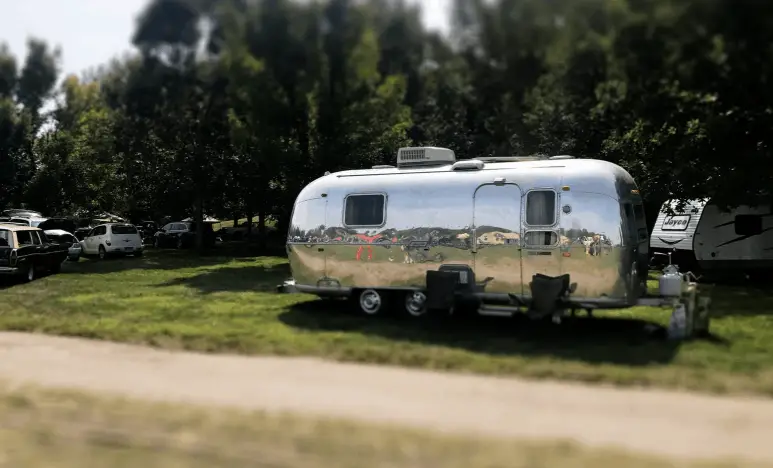
- BEGINNERS GUIDE
G. Yoganand
Winter camping is exciting and difficult at the same time. It comes with challenges and you need to be fully prepared. Having a motorhome like class A RV or class C gives great insulation during winter. Its easier to camp in such motorhomes during winter.
Travel trailer however, may not be as great during winter. You need to insulate them and make use of different tricks for winter camping.
In this article, I put forward multiple tips that one can use to live in a travel trailer during winter.
1. Use a Travel Trailer Skirt
First and foremost skirt the exterior of your trailer with insulated panels to prevent the cold air from cooling everything from underneath your RV. Wind blowing underneath can freeze the water tank and take all the heat out of the trailer.
RV skirt helps to protect the travel trailer from freezing and it also keeps the wind and excess cold out.
There are a variety of skirts available for different seasons. It will not only help in the protection but it will also keep the travel trailer warm and it is very important to stay warm during freezing cold.
The travel trailer skirt also reduces the effect of strong winds and provides more comfort.
2. Use Thermal Bags for Sleeping
One of the most important things that you have to take care during chilly winter is your body temperature. Your focus must be on staying as warm as possible. You should use thermal bags for sleeping because it will keep you warm.
Another point is that in winters, the most important body parts that you should prevent from cold are head and feet.
So to prevent your head from wind and cold, you should always purchase thermal bags that come with the hood. It will help in covering your head and the heat and energy loss from the body will be less.
3. Prevent Travel Trailer from Water
Even small amounts of water in the faucets, bends drains, elbows will freeze and cause them to crack or burst open. So you need to take care of your plumbing system. This can be done by filling all the water lines with non-toxic anti-freeze.
You can also use heat strips and wrap up your fresh water hose and sewer hose with it.
Water is the biggest enemy of you and your travel trailer or RV in winter. The moment you see mold in the walls, it is an indicator of water leakage. To prevent yourself from this, you should invest in a vent cover.
Vents are important but they can also elevate the heat loss from your travel trailer, however, it is better to use a vent cover to reduce the heat loss. With vent covers you can keep your vents open to keep the trailer dry in all the seasons without worrying about the snow or rain getting inside.
By using a vent cover, you will not only prevent condensation but it will also promote proper ventilation. You will also prevent the buildup of humidity in your travel trailer.
Installing a dehumidifier can help diminish the humidity buildup. A dehumidifier will reduce the levels of humidity and it will also help in keeping your RV moist free.
4. Insulate windows and floor
Install insulation to keep your trailer warm in winter months. Insulation also prevents the cold winds from damaging the piping and sucking the heat out of the RV.
To keep your travel trailer warm, you must properly insulate the floor and windows. Check the seals and caulking around the windows. If missing or weak replace them to prevent cold air from coming in.
Our feet are very sensitive and are more prone to catch cold easily. It is not possible to wear shoes all the time inside the travel trailer, so to avoid the heat loss through feet, you must cover the floors.
You can put thermal curtains on the windows and for the floor, you can use rugs. Rugs will work as a barrier between your feet and the floor.
Rugs are very comfortable and you will feel amazing walking barefoot on them. It will also elevate the look of your travel trailer and will make it more elegant. Windows can also deplete the warmness of your travel trailer, if not sealed or insulated properly.
Foam installation boards are also a great way to reduce heat loss. Install these boards and use heavy thermal curtains to cover your windows. It will increase the temperature and will also help in maintaining it. You can uncover the curtains if the sun is bright to allow the natural sunlight inside.
Do not cover the exhaust tailpipe or any vents with any insulated panel. If snow gets accumulated in these areas remove it.
Read : Preparing your RV for winter
Insulate the RV underbelly or floor. Similarly makes sure walls, ceiling are properly insulated. During very cold climate when the temperature is falling even small air leaks can make it worst.
5. Make use of heater
You can also use a small space heater to prevent water lines and pump of your trailer from freezing. But do not keep your space heaters too close to your trailer’s components and vents.
It may also be helpful to install a small heater under your RV to prevent the grey and black tank from freezing.
When the tank is emptied add half a gallon of windshield cleaner to it. This will make purging the tank easier and also keep the waste from freezing. Don’t forget to add windshield cleaner after each dump.
6. Get a Smaller Travel Trailer or RV
If you are planning to spend a long time in the travel trailer, then getting smaller travel trailer can be a good idea.
The main reason for using a small travel trailer is that it will get warm easily. Smaller the size easier it is to maintain the warmth.
It is also better for campers who mostly do camping in the cold areas because it will require less energy to warm up the entire trailer and you will also save your expensive propane gas.
7. Use Oven
If you are cooking something, then make sure to use an oven. Using an oven or any stove will increase the heat levels and will provide warmth to the entire RV or travel trailer.
There are two benefits of using stoves and oven. The first one is that you will get tasty, warm food and the second one is that it will also work as an alternative heat source.
You should always try to consume foods that are high in fats. This will provide a warm feeling. Also, exercising is another great way to keep yourself warm.
Having discussed this tips not all travel trailer will have ovens. Bigger RVs like fifth wheel or class A RV get lots of appliances but travel trailer are modest and may not have many of the amenities.
8. Make use of Antifreeze
Your RV and its components need special protection to withstand extremely cold conditions. Use antifreeze in your RV water plumbing system to keep it from freezing.
Engine block heaters warm up the engine and should be run for about 5 to 6 hours before you start it, especially if the temperature is below freezing.
9. Check RV furnace functioning
Before embarking upon another camping adventure make sure your RV’s furnace is in proper working condition.
Remove any dirt from your furnace using compressed air or a brush. Also, make sure that the furnace air return is not blocked.
Read : Troubleshooting RV furnace
You may also use space heaters and other additional heat sources but these can add moisture to the air which can damage your RV’s engine and other components.
10. Install Solar Panels

Using solar panels in RV for charging batteries is easy and you can do it without high cost. If you want to spend your winter without any difficulty, then you should invest in a solar panel. One good thing about advanced solar panels is that they get charged through UV rays even when the sun is not really out.
With the help of solar panels, you will be able to use electric heaters. By using electric heaters, you will save your expensive propane gas. You can also opt for an electric blanket, it is more efficient than an electric heater and it will keep you warm and save energy.
One thing that you have to keep in mind is before purchasing a solar panel, research well, otherwise you will waste your money.
There are two types of solar panels. The first one is polycrystalline, which is less expensive and 10% to 15% efficient approximately. The second one is monocrystalline which is more expensive in comparison to polycrystalline and 15% to 18% efficient approximately.
Well, both are almost the same except the efficiency level, you won’t see much difference. One benefit of monocrystalline panels is that they are more flexible, which means you don’t need to put effort into drilling holes to install them.
11. Keep RV batteries charged and ready
Check your batteries for corrosion and make sure they are properly charged and connected. Partly charged batteries can die out in cold temperatures. Testing and monitoring the batteries regularly will help in keeping them in proper shape and charged.
You definitely need good batteries for RVing. Keeping batteries charged and ready is necessary specially when you don’t have electricity connection points.
12. Insulate AC with cover
Cover your AC unit with an insulated cover as you won’t be running it in the winter. Insulated AC cover will protect your AC when not in use.
13. Be Active and do exercise
Suppose if the outside weather gets extremely chilly and nothing is working to prevent yourself from cold then the best thing that you should do is get up and exercise.
Well, you should not wait for the weather to get chilly to do exercise but you should do it regularly. You can do different bodyweight exercises to increase the temperature of your body.
14. Make sure carbon monoxide detectors are functioning
Check the carbon monoxide detectors and fire alarms for proper functioning. Test them and change their batteries before you head out on the road.
15. Make your Mindset and be prepared for urgency
Be prepared for any emergency as winter weather can be unpredictable. Pack an emergency kit that has all the things you would need to repair your trailer, in case your trailer freezes up or breaks down.
This is an important tip for using a travel trailer or any other RV in the winter. Despite having a lot of good features in a travel trailer, it cannot give you every comfort as your house.
You will have to do some sacrifices but the most important thing is your mindset. You will have to prepare yourself mentally. Be ready to face with cold conditions which might make you uncomfortable. So a strong will power is a thing that you will need the most.
16. Get enough winter clothing and insulation material
Lastly, prepare for your winter adventure by packing several different layers made of insulating and breathable materials like wool and fleece. Keep waterproof outer layers like a winter coat or jacket that can protect you against snow and freezing rain.
Bring a few warm hats, socks and gloves also. Take electric blankets and sleeping bags for extra comfort during cold winter nights.
Lets see some other dos and donts of winter camping in travel trailer or camper. These tips will help keep your camper warm in the winter.
- Choose a Rving region that isn’t extreme cold. An adventure is amazing but make sure you aren’t seeing something very extreme. Very heavy snow can cause much more damage than you can imagine. So just be sure about the weather in advance.
- Do not open the main door too often. Keep its use to minimal. Frequently opening the door will obviously allow the heat to escape.
- Make use of heated water hose
- Keep your RV pipes and other plumbing systems from freezing. You can insulate them or make use of a heat source to keep them from freezing.
- Stay active and keep your body as warm as possible
- Make sure water hoses are stored with water in them. This will freeze them.
Summer and spring are most suited for Rving but winter can be more exciting provided you follow all the tips. Travel trailer can make your Rving experience amazing during winter if you keep it insulated and warm. No matter what RV you get for living in the winter make sure to enjoy.
You Might Also Like
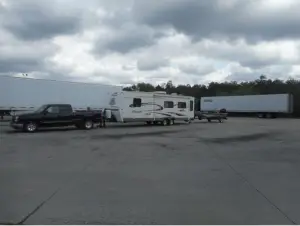
How To Tow a Boat Behind a Travel Trailer
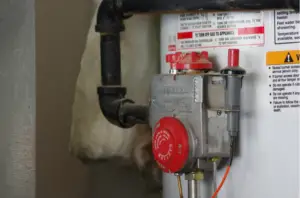
Why do trailer hot water heater shuts off (reasons and resolution)
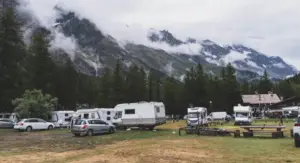
Where to dump RV waste for free
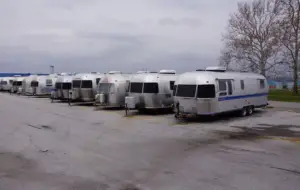
What is so special about Airstream Trailers
- International edition
- Australia edition
- Europe edition

‘We just need a little help’: how a safe parking plan for people living in cars split a US town
Sedona, Arizona, lacks affordable housing, but a program for priced-out local workers to sleep safely has drawn opposition
Jodi Jackson moved to Sedona, Arizona , last year for a slower pace of life. The 52-year-old has found the affluent town – known for its red rocks and appeal to the new age crowd – to be welcoming.
Working in a local laundromat, she comes into contact with a wide range of customers, from those cleaning linens for short-term rentals to those living in their cars.
Jackson herself lives in an RV, having left an abusive relationship and spending time in jail and rehab; she is one of many in the area who sleep in vehicles, priced out by the high cost and low availability of housing.
Finding a safe and affordable place to park has proved impossible. To camp, Jackson moves between a nearby state park and the parking lots of businesses that don’t hassle her.
Under a program proposed by the city, she could get a place to sleep safely and legally: somewhere she could pull in her RV after work and leave in the morning. But the scheme, designed to cater to the town’s workforce, has been put on hold in the face of vocal opposition.
“We may not be housed and living in town, but we’re the ones who are doing your laundry, working at your gas stations, working at your restaurants – all of the lower-wage jobs – delivering your pizza, for God’s sake,” Jackson said. “We’re not bad people. We just need a little bit of help.”
Stories of businesses and employees wading through the effects of local housing issues abound – from restaurants cutting hours or simplifying menus, to an unhoused teacher – as people on fixed incomes grapple with rents increased beyond their capacity.
But in the vacation destination spot, where rents are high and short-term rentals make up a sizable chunk of the housing market, a vocal segment of Jackson’s neighbors don’t want to see the parking lot open up.
Sedona’s Safe Place to Park program – similar to ones that now dot the US, amid an ongoing housing crisis nationwide – faces an uncertain future after becoming a flashpoint for the city’s housing woes. The episode serves as a microcosm of the difficulties communities face when trying to address homelessness, and the deep need for affordable housing – even in wealthy places.
A group of residents is gathering signatures to put the program to a citywide vote. The group has until 11 April to get nearly 600 valid signatures of Sedona voters.
The program
Safe Place to Park would use a parking lot on city-owned land at the Sedona Cultural Park, a long-defunct amphitheater, to hold 40 vehicles that come in and out around work schedules.
Slated to last two years, the program would be overseen by a social services organization that would vet people staying on the lot. The site, which would provide bathrooms and showers, was designed to offer people already sleeping in vehicles – in business parking lots, on residential streets and on forest roads – with a place to do so safely and legally.
The intent is that working adults will make up the majority of the program’s users, but other groups with Sedona ties who are suffering from housing issues – such as people with children in Sedona schools, older adults and people with disabilities on fixed incomes – wouldn’t be turned away, said Rhonda Bishop, executive director of the Verde Valley Homeless Coalition, which was tapped to manage the program.

The city says it has housing projects in the works that will bring permanent affordable housing to locals. When the city purchased the cultural park land in 2022, the initial idea was to use it for housing, though that will require planning.
The goal of Safe Place to Park is to find the people who sleep there a permanent place to live. But the pace of building in the area is slow – and the need is immediate.
The town of about 10,000 is landlocked by forest, making growth difficult. Many residents oppose increased housing density, such as larger apartment buildings, because it doesn’t fit the small-town feel of the area. And there’s a strong streak of not-in-my-backyardism that arises whenever new developments come around.
Sedona is short of 1,260 affordable units, according to the city council, and house prices have increased 50% since 2020. The average monthly rent for a two-bedroom apartment is $2,150.
A ‘last-ditch’ idea
This city, like many others across the country, is struggling with a great exacerbator of its housing crisis: the proliferation of short-term rentals.
In 2017, the Republican-led Arizona legislature made it illegal for cities and towns to regulate short-term rentals such as Airbnb. Cities and towns like Sedona have been fighting to get the ability to regulate these homes ever since, to little avail. Some minor regulations, such as requiring short-term rentals to register with the city, were allowed in recent years, but efforts to overhaul vacation rentals have been blocked by Republican leaders in the statehouse.
Short-term rentals now account for 17% of Sedona’s housing stock. Scott Jablow, the town’s mayor, and other city officials want the ability to cap the number of short-term rentals, while exempting existing ones.
“Every other state in the country, they allow the cities and towns to govern it themselves, to regulate it themselves,” Jablow said.
As a bevy of short-term rental regulation bills fell by the wayside during the latest legislative session, the city’s lack of affordable and available housing persisted.
The parking program is a last resort, according to Jablow. But as a group of residents take aim, he’s prepared to defend it.
“It was not the best idea,” he said. “It’s not even a great idea. It’s a sucky idea, actually. It’s a last-ditch effort of an idea. We’re not proud of it, but we have to do something.”
During his decade-plus in local government, Jablow has been on the frontline of this crisis, hearing frequently from both people who have lost housing and employers who have lost workers because of it.
One recent caller, who made $75,000 annually, lost her housing and couldn’t find anything she could afford on that salary, he recalled.
At the same time, local employers often can’t find workers who can afford to live nearby. “We will do anything for our staff because we just don’t have any choices,” said Steve Segner, who owns a hotel in town and supports the parking program. “We can’t lay them off in the slow season. We’ve got to treat them right.”
The backlash
After seven hours of testimony earlier this month, all but one member of the city council voted in favor of a zoning change to greenlight the parking program.
Two big issues combined for the group against the project: a faction that wants to see the cultural park brought back to life, and another which thinks the project will turn Sedona into a destination for people living in cars. Some people sit in both camps.
Others suggest the program isn’t a humane way to house people, or question the choice of location.
Bill Noonan, who eventually filed the paperwork to refer the program for a vote, told the council meeting that he wanted to see the cultural park restored to a music venue , with another spot used for the program. But he also pointed to an issue that spans far beyond one town in Arizona.
“I moved here from Portland two years ago to escape the homeless crisis that was created by the city there,” said Noonan, “so I’m sorry to see the Sedona city council considering making some of the mistakes that Portland made 20 years ago that destroyed that once-beautiful city.”
A website launched by the program’s opponents summarizes their opposition. They believe the program will bring in outsiders who are unemployed, crowding out the workers it intends to help. They fear the people who live there wouldn’t follow community rules against smoking and leaving trash.
The group leading the opposition, Save the Cultural Park Committee, did not respond to an email requesting comment.
Critics also nod to the larger housing crisis the community faces: “The City’s proposal for a homeless car camp at Cultural Park does nothing to address the true problem of assisting homeless workers to have a permanent, affordable INDOOR place to live , ” the website says. “Their approach is not caring, it is not humane.”
A divisive Band- Aid
At the council meeting, the lone vote against the project came from the vice-mayor Holli Ploog, who generally understands the need for the program, but found the voices against it overwhelming. While the city is unable to call a ballot on the program itself without voters organizing a petition for one, she would have done so were it an option.
Ploog has been stopped in the grocery store and pulled aside by friends, seeing a level of attention unlike any other issue that has come before the council since she joined a few years ago.
“To divide our community, to break our community over this – which is a short-term Band-Aid that doesn’t even solve the problem – to me, it wasn’t worth it,” Ploog said in a interview. “We need housing, and I want us to rally around housing.”
The questions of restoring the cultural park or approving the parking program aren’t mutually exclusive, she noted. With the parking program set to be temporary, it wouldn’t interfere with an eventual reimagining of the park – which, even if people decide to rally around that idea, would take years.
“It’s so complicated now and it’s so confusing, and there’s so much misinformation,” said Ploog. “But the emotion has been stirred up, and there’s a lot of fear also – fear that once you start down this path, you won’t be able to stop it.”
The politics
Opponents of the program warn it could attract people to Sedona and create a constituency that want it extended beyond two years.
A Change.org petition calling to stop the program dings the mayor and city officials for doing media interviews about the program, saying: “Now the adage ‘If you Build It, They will Come’ will become a reality for this beautiful town.”
This claim has been challenged by the National Vehicle Residency Collective, which advocates for people living in their vehicles both as a last resort and by choice, tracks safe parking programs around the country. The growing trend includes cities throughout the country, and especially in the western US.
Graham Pruss, the collective’s director, said such programs have not really seen a rise in people from other cities moving to access safe parking programs.
People often live in their cars near where they used to live, he said, “using their vehicle as a way to maintain a connection with their familiar community”, including their jobs, medical providers, family and friends; sometimes within a few blocks of their former homes.
The backlash to the program is common to any efforts to help the unhoused, Pruss said. Segner, the hotel owner, suggested the vocal opposition parallels the political divide in the US, played out locally.
“Sedona is primarily a liberal community in the heart of a red state, or purple state,” he said. “And then there’s a faction of people in town – a small faction – that don’t like anything that has a liberal smell or taste to it.”
‘Open to anything’
Since the parking program has become mixed up with the possible revival of the cultural park, some pointed to another part of town, the Dells, that could be used instead. But Jablow said this area presents environmental concerns: it’s across the street from a wastewater treatment plant, where the city sprays effluent water. And there’s no guarantee moving the project would quell the negative response.
Bishop, of the homeless coalition, has found it “embarrassing” that a portion of the community is “so against really just helping other people”.
She said her group was ready to provide additional services to help find stable housing for this population. Having those affected in a set location, with caseworkers who build a rapport with them, would be a step forward, she said.
“This is probably not going to happen, and it’s too bad,” Bishop said. “Because people are just afraid to have ‘the homeless’ in their community.”
Jablow, for his part, seems exasperated.
He is not prepared to push ahead with the project while campaigners are gathering signatures. He believes it’s needed immediately, but doesn’t want to waste money on a program that never sees the light of day.
The parking program isn’t the best idea, Jablow concedes. But he has yet to hear a viable alternative.
“Give me an idea,” the mayor said. “I’m open to anything.”
- Homelessness
- Communities
Most viewed
- Alaska Insight
- Watch KAKM Live
- Indie Alaska
- Ways to Watch
- There is Hope
- AK Passport
- In My Family
- KSKA Schedule
- Hometown, Alaska
- Listen to KSKA Live
- All Radio Programs
- Outdoor Explorer
- Addressing Alaskans
- State of Art
- Alaska Economic Report
- Hear me now
- Military Voices
- One Small Step
- Alaska Morning News
- Talk of Alaska
- Alaska News Nightly
- Traveling Music
- Black History in the Last Frontier
- Latest News
- Environment
- Mental Health
- Rural Health
- Alaska Legislature
- Washington, D.C.
- Public Safety
- ANCSA, 50th Anniversary
- Midnight Oil
- Daily Digest
- AKPM Community Education Engagement
- Race Matters
- Ready to Learn
- Library Explorers
- Molly of Denali
- Learning Media
- Parent Resources
- Watch PBS KIDS
- Workforce Development
- Ways to Give
- Benefits of Membership
- Together We Are Stronger
- AKPM Merchandise
- E-Newsletters
- Organization
- Public Documents
- Public Meetings
- Accessibility Commitment
- Donor Portal

Anchorage officials aim to keep camping in check as winter shelters wind down
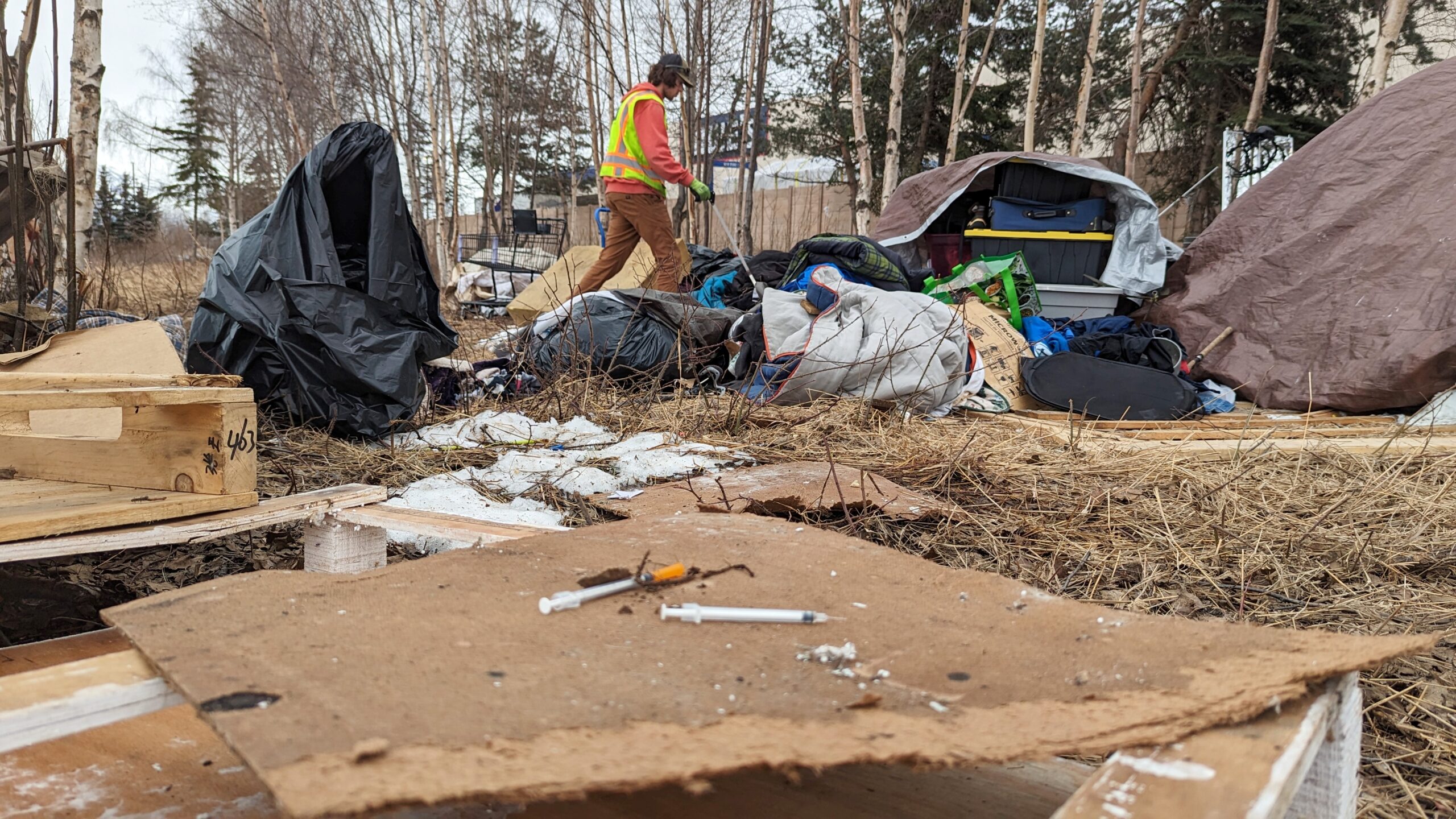
Anchorage officials are trying to create some clear structure and guidance for people living in Anchorage without homes this summer. The idea is to avoid some of the public safety and nuisance issues that came up after winter shelters closed last year.
On Tuesday, the Anchorage Assembly is expected to hold a public hearing and vote on an ordinance to limit the size of encampments, keep them away from existing year-round shelters, and create safe parking areas for people living in their cars.
Last year, when the city’s winter shelters closed , officials had little guidance for the hundreds of people being put out. Encampments on vacant city land and in wooded areas ballooned all over town , along with hosts of problems within encampments and in the surrounding neighborhoods.
“On our side, making clear expectations for those who are in encampments is really important,” said Meg Zaletel, executive director of the Anchorage Coalition to End Homelessness, which worked with Mayor Dave Bronson’s administration to develop the proposed ordinance. “Last summer, it was very unclear. It was very unclear and it created a lot of uncertainty.”
Zaletel, who is also the vice chair of the Assembly, said being clearer about where camps will and won’t be tolerated will make outreach and education easier.
The city’s homelessness coordinator, Alexis Johnson, explained.
“We’ll have a map handy that says, ‘Hey, this is where you will have the least amount of trouble if you set up camp here. These are no-go zones, please do not set up here,’” Johnson said. “And establishing that relationship prior to a majority of shelter letting out so that people know where they can go in town and not have issues.”
Zaletel said limiting the size of camps will also make outreach safer and more manageable. The size limit hasn’t been set yet, but in a work session , city officials kicked around limits between 25 and 50 tents or similar shelters.
Zaletel said barring campsites near existing shelters is helpful for keeping those clients on track. For example, she said someone trying to stay sober in a shelter wouldn’t immediately be confronted by people drinking.
“What we often see, and we’ve seen before particularly on Third Avenue, is that if you are able to go to shelter and you are in shelter and you want to leave shelter to attend to your appointments or anything else, if camping is right there, and large encampments in particular, you are inundated,” she said.
The last significant change the ordinance proposes is to create some city oversight and permitting for “designated safe parking areas.” The idea is that a church, nonprofit or government agency could make their property available for up to 50 vehicles for people to stay in. City health and planning officials would have to sign off that certain public health and safety issues were covered to get the designation.
At its peak this winter, the city paid for more than 600 people a night to have a safe place to sleep. Johnson said some pieces of that system are already scaling down, with a complete closure scheduled for May 31. All together, she expects about 900 people to go unsheltered in Anchorage this summer.
She said it’s far more expensive to manage the impacts of that population when they leave shelter, in terms of things like police and paramedic calls, emergency room visits and cleanups at camps.
But there might be some relief coming from the state. Legislators working on the state operating budget in the House Finance Committee recently added a $4 million grant to keep the city’s 200-bed shelter in a former administrative building running through the summer.
As just one small piece of a far bigger spending proposal, it’s far from guaranteed. But through a spokesperson, Mayor Bronson said, “This is a significant need that we face and I really appreciate the attention the Legislature is giving to this issue that affects all of Alaska.”

Jeremy Hsieh, Alaska Public Media - Anchorage
Jeremy Hsieh covers Anchorage with an emphasis on housing, homelessness, infrastructure and development. Reach him at [email protected] or 907-550-8428. Read more about Jeremy here .
RELATED ARTICLES MORE FROM AUTHOR
Boy, 3, drowns in togiak bay accident, teen driver dies in 3-vehicle wasilla crash, murkowski insists ‘i’m in the right place,’ despite rift with trump.
- Share full article
Advertisement
Supported by
Are You a ‘Spring’ or a ‘Winter’? It Could Cost You $500 to Find Out.
Seasonal color analysis, a fad from the 1980s seeking to identify a person’s most flattering color palette, is drawing views and exasperation on TikTok.

By Callie Holtermann
A barefaced woman studies her reflection, trying on fabric bibs that could have been yanked from a production of “Joseph and the Amazing Technicolor Dreamcoat.” In a video posted on TikTok last month, she is draped in lustrous silver, faint pink, a deep green that recalls a jalapeño pepper.
Standing behind her client as a hairdresser might, Tatum Schwerin oohs and aahs. “Stunning on you,” she says of one warm-toned tapestry. Another, with stripes of terra cotta and butter yellow, is “on the money.”
Ms. Schwerin, 44, calls herself the Color Analysis Queen on social media. She estimates that she conducts about 60 of these sessions a month at her home in Frisco, Texas, with the goal of identifying a palette that best suits a person’s skin, hair and eye colors.
Each 90-minute consultation costs $479. Ms. Schwerin said she was having trouble keeping up with demand.
Ms. Schwerin is among a wave of influencers turning seasonal color analysis, a classification system popular in the 1980s, into a viral phenomenon as well as a lucrative business. It posits that each person’s features can be sorted into a set of shades associated with winter, spring, summer or fall, and offers clothing and makeup recommendations to match.
@thecoloranalysisqueen Get started either virtually or in-person through the link in my bio! #thecoloranalysisqueen #coloranalysis #coloranalysistok #virtualcoloranalysis #styledbytatum #colorpalette #texasstylist #personalstylist #wardrobestylist #colorseasonanalysis ♬ original sound - The Color Analysis Queen
The system’s fans might once have attended a get-together “halfway between a Tupperware party and group therapy,” according to a New York Times article published in 1983. Now they congregate on Instagram and TikTok, where videos of Ms. Schwerin’s consultations regularly attract hundreds of thousands of views. Her biggest hit has been seen more than 30 million times.
A healthy slice of those viewers don’t see why anyone would pay nearly $500 to be told that they look pasty in blue.
“Watching these I feel the same as when someone shows me their baby sonogram,” a commenter wrote on one of Ms. Schwerin’s videos. “I DON’T SEE IT.”
Ms. Schwerin, a former stylist who took two online courses on color analysis, is undeterred. “I always like to say, ‘Have you tried on lipstick?’” she said. If so, “you surely can recognize that not all colors are equal on your skin.”
The idea of color seasons was popularized in part by Carole Jackson’s 1980 best seller “Color Me Beautiful.” Ms. Jackson offered four seasonal palettes that drew from the colors present in nature at that time of year: rich golds and browns for autumn, icy blues and whites for winter and so on.
Ms. Jackson, who ran a thriving business training color consultants, argued that a person’s season could be determined by the colors that made them look the perkiest. “See how Summer Mary looks drab in the yellow-tone camel and orange lipstick,” she wrote of a model in the book, “but comes to life in the pink shirt and pink makeup tones that are so complementary to her natural coloring.”
@sarah_novio Replying to @Toyia Am I a true winter or a dark winter? I honestly think I’m Dark Winter with my natural features but now that my hair is partially blue it made my skin more cool toned (appearing) #darkwintercolors #truewinterpalette #coloranalysis #coloranalysistok ♬ original sound - sarah_novio
Sarah Novio, 34, noticed color analysis taking over her social media feeds last year and began uploading her own videos about celebrities including Rihanna and Jameela Jamil. “Even though there was a lot of color analysis, I didn’t see a lot of people talking about people of color, or people with more melanin in their skin,” she said.
Ms. Novio uses Photoshop to test out swatches of different hues next to a person’s face. She tries to determine whether a person’s “undertones” are more yellow (warm) or more blue (cool), and if they look better to her in bright or muted colors, occasionally consulting the color wheel that she learned about in art school to make her recommendations.
Humans are sensitive to extremely fine differences in facial complexions, said Bevil Conway, a neuroscientist and artist who has studied how humans see color. It is true that our perceptions of those colors may shift based on how they contrast with the clothing or makeup around them.
Still, he was skeptical of the strict prescriptions offered by some color analysts. “People take a little grain of science and then it gets inflated to become a whole world,” Dr. Conway said. What is “flattering,” he added, is highly subjective: “Using it as a tool is fine. I think starting to make normative claims about beauty is where I would draw the line.”
Luckily for color analysis, subjectivity and disagreement tend to feed, not squash, a social media trend.
Some TikTok users post videos surrounding their faces with rainbow color wheel filters, asking commenters to determine their color season for them. (Professed experts tend to sneer at this approach.) Others have tried outsourcing color analysis to ChatGPT , which seems to identify almost everyone as an autumn.
Armchair color analysts argue in the comment sections of videos about celebrities like Jenna Ortega, Hailey Bieber and Beyoncé. The actress Zooey Deschanel posted a video last month “setting the record straight,” she wrote in the caption, that her much-debated color season was winter.
@missdarcei I got my personal color analysis done in Korea at @Colorwings in Seoul! #coloranalysis #korea #traveltiktok #beauty ♬ Aesthetic Music (Remastered 2022) - Bepo
Among the theory’s adherents, an in-person assessment remains the gold standard. Darcei Giles, a 32-year-old beauty content creator, flew 14 hours from Toronto to Seoul last year in part to get a color consultation there. She said her result — “bright spring” — had helped her shop more efficiently.
“It’s almost like finding out your zodiac sign for the first time and being like, Oh my god, that makes so much sense!” Ms. Giles said.
Ms. Novio thinks color analysis can make getting dressed less overwhelming, but she chalked up its popularity to a broader fascination with examining, rating and categorizing our appearances .
“People like to belong somewhere,” said Ms. Novio, who occasionally ignores her own “deep winter” classification to wear a favorite orange and brown striped sweater. “Being categorized in a season makes people feel that way.”
Callie Holtermann reports on style and pop culture for The Times. More about Callie Holtermann
The Rise of TikTok
“Being labeled a “yapper” on TikTok isn’t necessarily a compliment, but on a platform built on talk, it isn’t an insult either .
“Who TF Did I Marry?!?,” the TikTok user Reesa Teesa’s account of her relationship with her ex-husband, is a story for grown-ups in their midlife crisis era.
Return fraud is a rampant problem for both shoppers and retailers — and the mishaps often make for viral videos on TikTok.
The Pink Stuff, a home cleaning paste, went from total obscurity to viral sensation — and Walmart staple — thanks to one “cleanfluencer” and her legion of fans .
Have we reached the end of TikTok’s infinite scroll? The app once offered seemingly endless chances to be charmed but in only a few short years, its promise of kismet is evaporating , our critic writes.
The TikTok creator known as “Tunnel Girl” has been documenting her attempt to build an emergency shelter under her home. She is not the only person with an off-the-books tunnel project .

IMAGES
VIDEO
COMMENTS
To live full-time in an RV in the winter, you need the following: A heated water hose (or you can rely on the internal water pump in your RV). An internal propane heater in your RV. 1-2 electric space heaters. Warm clothes and blankets (you can keep the RV warm in the winter, but these help). A way to keep tanks and pipes warm (some RVs are 4 ...
3. Winterize While Still Living in It. Winterizing an RV while you're still living in it is possible. Of course, it can be a bit tedious to move around stuff, even more so if you have kids living with you. However, with a bit of finesse and a healthy dose of duct tape, it is possible to make your RV winter-ready.
Here are some RV fire safety and carbon monoxide tips for winter time. Use a carbon monoxide alarm in all main living and sleeping areas of your RV, and test them monthly. Never use an extension cord for an electric space heater. Never use a power strip for an electric space heater.
Outland Living makes a multi-purpose tank cover. It protects the propane tanks from the elements, has ventilation grommets, and a durable top that can be used a small side table. The weather resistant cover helps to prevent tank freeze throughout winter. UV and Weather Resistant Propane Tank Cover. $29.99.
The best RV for winter living is one that's fully self-contained and as insulated as possible. You may even want some extra aftermarket insulation added. Large motorhomes and travel trailers may be constructed out of sturdier, more weather-proof materials, but a smaller travel trailer may be easier to heat since there's less living space. ...
First, look for drafty areas around your RV windows, skylights, fans, doors, slide-outs, and roof vent that allow the cold air in. Then, make sure to seal them with weatherstripping. Foam inserts also create an effective barrier in skylights and the back of cabinets.
Prepare Your RV for the Cold! While living full-time in an RV in winter is in many ways far more convenient than a house, RVs are also far more vulnerable to the effects of freezing temperatures than a regular house is. Even if it is claimed that it is a "four-season" motorhome, if you don't take steps to winterize your RV, you could find ...
One of the things that helps the most in keeping an RV warmer in the winter is skirting. Placing a barrier around the bottom of the RV to keep warmer air trapped under the RV and colder air out makes a considerable difference. Keeping the underbelly warm will help us RV in winter in comfort.
RV living in winter depends on the right packing list. While it is important to prep your RV's exterior in the right ways, it's equally important that you and your family have the right gear for the cold. Thermal sleeping bags and/or thick duvets along with an ample supply of blankets will keep your crew happy and toasty while winter camping.
1.4) Keep Gate Valves Closed and Insulated During Winter RV Living. 1.5) Run a 60-Watt Incandescent Light Bulb. 1.6) Seal Off Sewer Hose Entry (ies) 1.7) Use Steel or Brass Wool to Seal Small Openings. 1.8) Use a Remote Temperature Sensor. 1.9) Moisture Control For Winter RV Living. 1.10) Use Holding Tank Heating Pads.
Living in a travel trailer during cold winter months can be enjoyable with proper preparation. Having efficient, safe heating and warm bedding are essential to comfort. Preparing the warm outerwear for outdoor excursions. Hats, gloves, and thermal sleeping bags are necessities for retaining body heat. You can simplify the cooking.
RV Enjoyer at Roaming RV. Jalin Coblentz has been living the RV life full time with his wife and Goldendoodle, Harper, for over a year and a half now. And absolutely loving it. 86. It wasn't that long ago when the idea of living year-round in a Recreational Vehicle was outlandish and ridiculous. However, modern RVs and their components have ...
One of the most amazing parts of RV Living its overall flexibility. Some RVers are weekend warriors, while some travel for long trips, and others live in their RVs full time. Most RVers prefer to travel with the seasons, sticking to mild temperatures to ensure they don't encounter extreme weather, especially considering that RVing in the winter is no easy feat.
Tips for Winter RV Living: Find an RV park with Hookups. Fill your Fresh Water Tank. Drip Faucets if needed. Pour RV anti-freeze down sinks and toilet. Use a Propane Heater and Electric Heater. Insulate RV Windows and Roof vents. Prepare Outside Your RV. Prevent Heat Loss Under the RV.
The best RV ventilation is to install one or two electric roof vents. They have a low draw on the batteries and ensure constant airflow. This replaces stale, humid air with clean, dry air, keeping the van fresh inside. Minimising water vapour inside the van is another crucial aspect of stopping condensation.
2 Ways to Keep the Inside of Your RV Warm in Winter. #1. Use electric heaters in addition to your RV's propane furnace. To keep the temperature inside our RV at a safe and comfortable level in freezing weather, we kept 3 electric heaters plus an electric fireplace running non-stop.
Living in an RV full time is an exciting adventure, but it also comes with some extra stress & anxiety related to weather, safety, and travel. ... Be prepared for winter weather. As full time RVers, you're going to be living in your RV year-round, which will include all the winter months. We full-timed in Oregon for several winters and met ...
Doors. Put insulating adhesive rubber tape around the door frame. Because the doors could be poorly insulated, it is recommended to use weather strips and curtains of quilted fabrics that cover the entire door, and likewise for the windows. Good insulation in doors and windows is key for living in a travel trailer during winter.
For those storing an RV for winter, winterizing usually means draining the water from the vehicle and running antifreeze into the engine and the pipes. This procedure prevents the water from freezing, expanding, and bursting your pipes. It will help keep your RV in tip-top shape for spring. RV living in winter requires a different approach.
In this article, I put forward multiple tips that one can use to live in a travel trailer during winter. 1. Use a Travel Trailer Skirt. skirting a travel trailer for sub zero temperature. First and foremost skirt the exterior of your trailer with insulated panels to prevent the cold air from cooling everything from underneath your RV.
Since RVs are designed for mobility and travel, they allow you to explore new places, meet new people, and embark on exciting adventures. Living in an RV during winter allows you to experience the beauty and wonder of winter landscapes, from snow-covered mountains to frozen lakes and rivers.
The 330RSTS is one of the best overall travel trailers for the winter. It's protected by Climate Shield™ technology that protects it against all kinds of weather conditions. The design also includes an enclosed and heated underbelly, a 35,000 BTU furnace, a built-in fireplace, and double layered fiberglass insulation.
4. Insulate the Water Heater. Using the water heater insulation blankets will help you to maintain higher temperatures of the freshwater, making it easy for you to live in a travel trailer during winter. Although the only reason why your travel trailer is equipped with a water heater is to provide you the hot water, in incredibly cold ...
Sedona, Arizona, lacks affordable housing, but a program for priced-out local workers to sleep safely has drawn opposition Jodi Jackson moved to Sedona, Arizona, last year for a slower pace of ...
Jeremy Hsieh covers Anchorage with an emphasis on housing, homelessness, infrastructure and development. Reach him at [email protected] or 907-550-8428. Read more about Jeremy here. The ...
Alaska has the highest total monthly utility bill of all states at $569.64 and Utah has the lowest at $345.62. The average utility bill per month nationwide is $429.33. The year 2022 had a number ...
Schwerin said she was having trouble keeping up with demand. Ms. Schwerin is among a wave of influencers turning seasonal color analysis, a classification system popular in the 1980s, into a viral ...